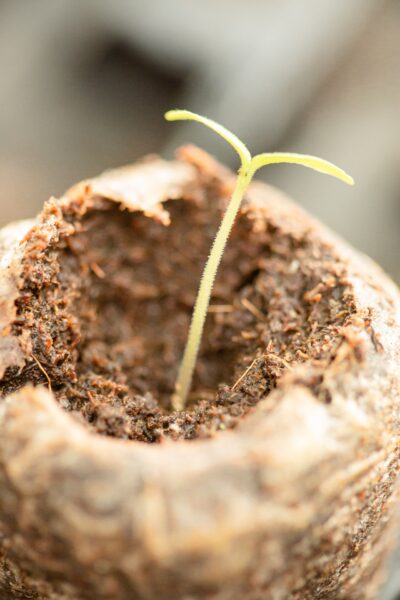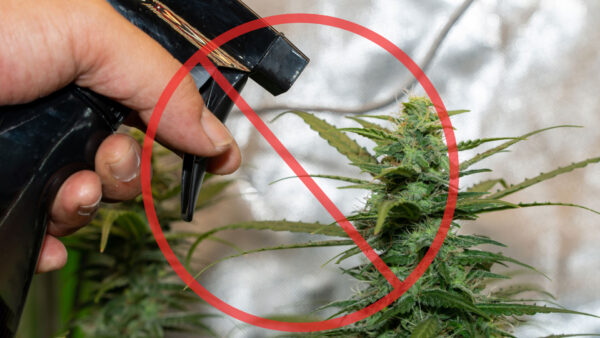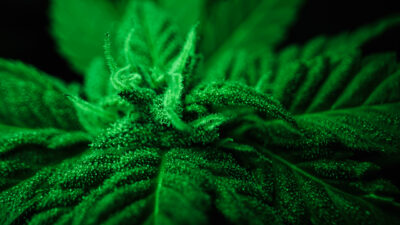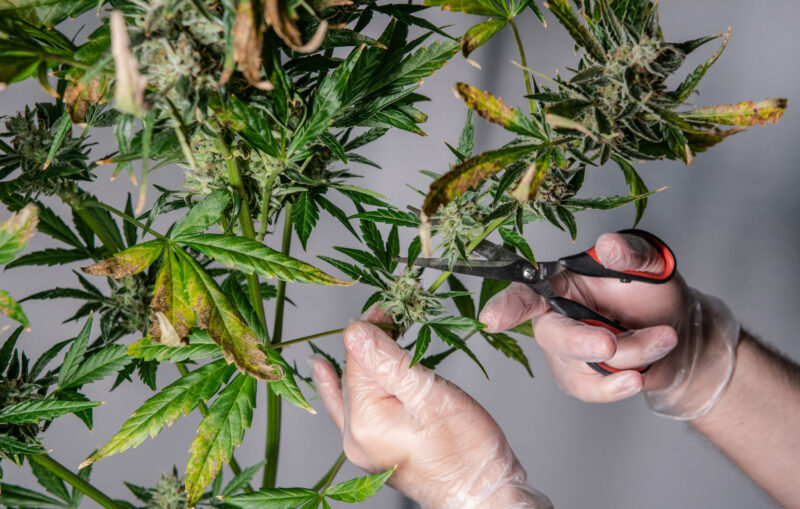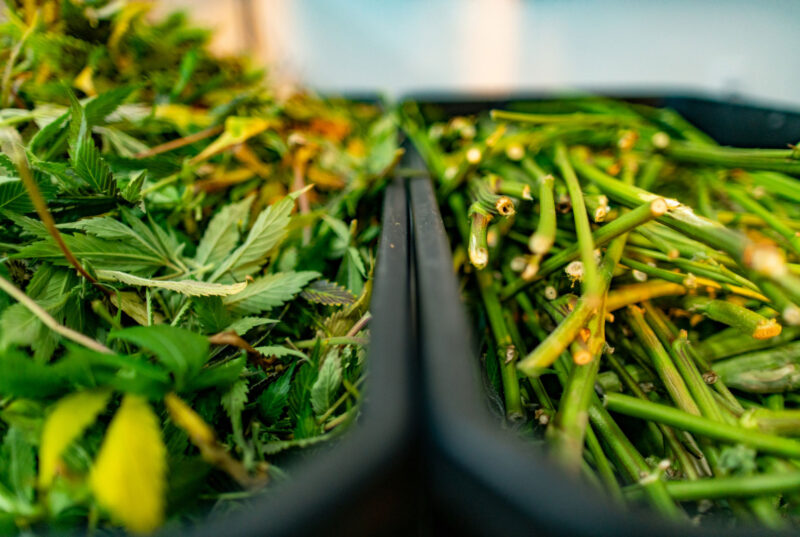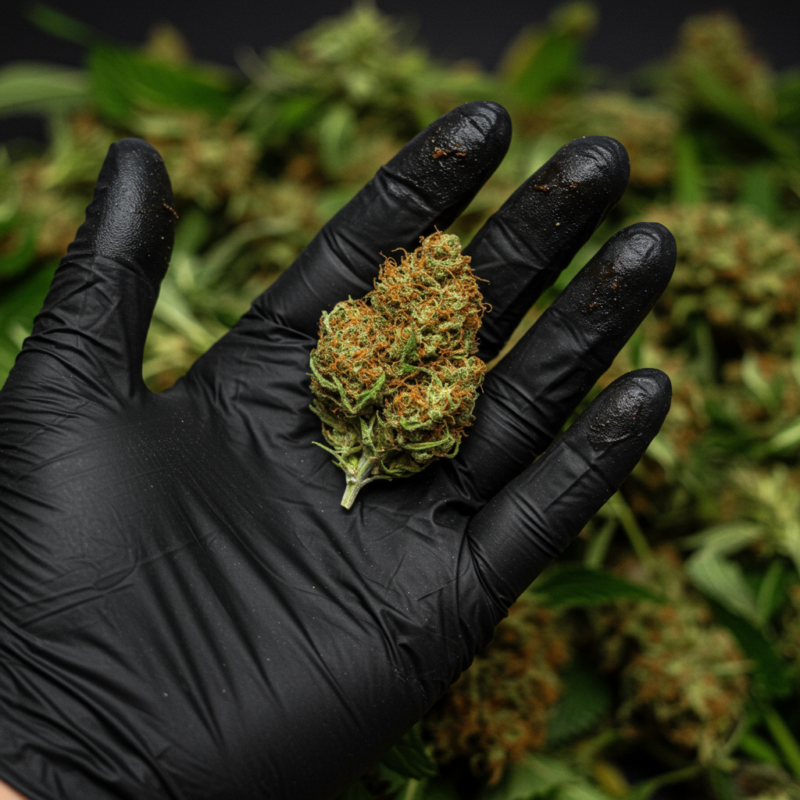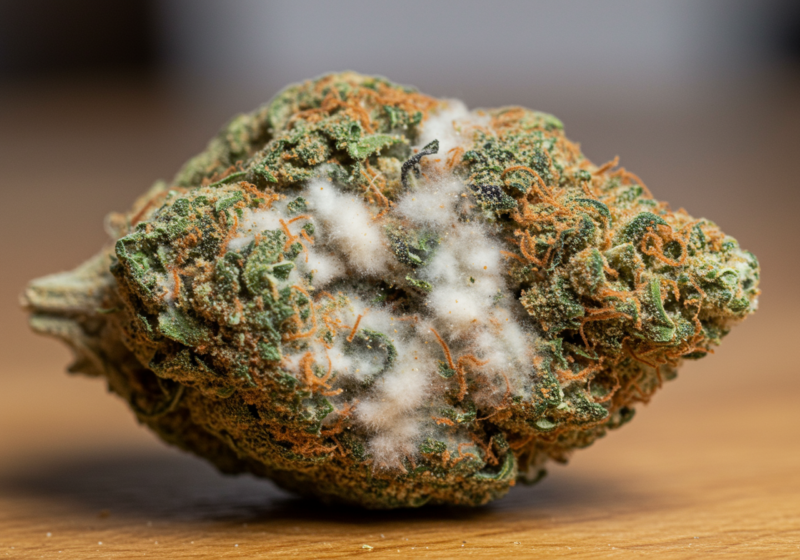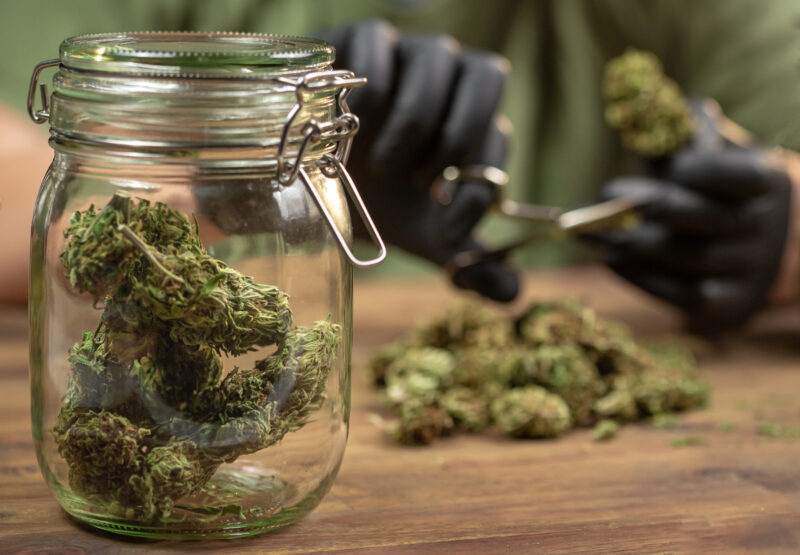- Complete Indoor Cannabis Growing Guide: From Seed to Smoke
- What You Need Before You Start
- Security Checklist
- Seeds and Germination
- Seeds for Indoor Cannabis Grow
- What Are Strains?
- Types of Cannabis Strains
- Recommended Strains for Indoor Growing
- Germination
- Germination Step by Step
- Troubleshooting Common Germination Problems
- Transplanting Seedlings
- Stages of Cannabis Growth
- Vegetative Growth
- Pre-Flowering
- Time to Start Flowering?
- Flowering: The Final Stage
- What is Sinsemilla?
- Feeding During Flowering
- Supplement Advice for Flowering
- Bud Taste
- Lighting for Flowering: 12/12 Light Cycle
- Spectrum and Light Color for Flowering
- Importance of Complete Darkness
- Quick Flowering
- Flowering Timeline
- Improving Bud Quality
- Harvesting
- Complete Indoor Cannabis Growing Guide: From Seed to Smoke
Complete Indoor Cannabis Growing Guide: From Seed to Smoke
Indoor cannabis growing puts the power directly in your hands. You control everything lighting, temperature, humidity, and nutrients. Done right, it gives you the ability to grow high-quality, potent buds year-round, regardless of the weather outside. The best part? No pests, no unpredictable outdoor conditions, and no need for large outdoor space. Just a controlled environment that you can perfect for maximum yields and potency.
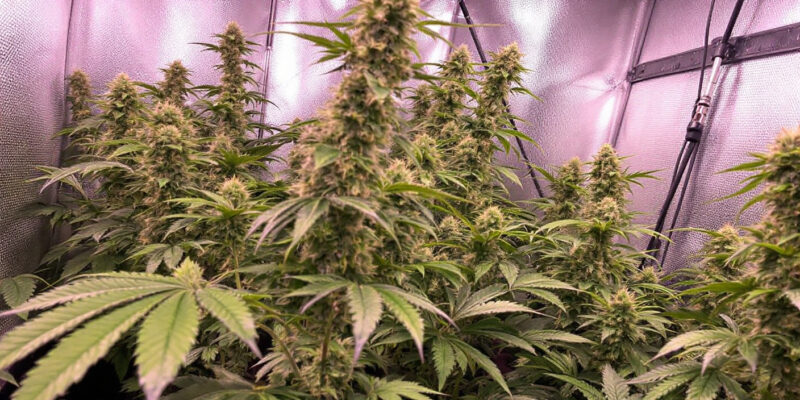
This guide is designed to walk you through the entire indoor growing process, from selecting the right seeds to lighting techniques, and all the way to harvesting and curing those sticky, resinous buds. Whether you’re just getting started or looking to sharpen your skills, you’ll find the tips, techniques, and advice you need to produce a successful crop.
Growing indoors isn’t just about throwing some seeds in dirt and hoping for the best, it’s about mastering an environment that mimics nature but with your own tweaks to boost performance. From germination and plant training to controlling the flowering phase, every stage is important. When you control your grow, you’re not just growing cannabis you’re perfecting your smoke quality.
In this guide, you’ll learn what works and what doesn’t. You’ll find out how to avoid rookie mistakes and maximize your yields. Most importantly, you’ll discover how to get from seed to smoke, with a grow room full of heavy, crystal-covered buds that pack a punch.
Let’s get started.
What You Need Before You Start
Growing cannabis indoors is simple when you follow the basics: secure a space, plant quality seeds or clones, and create the right environment with proper air circulation, lighting, water, nutrients, drainage, and a suitable growing medium. Seeds sprout into seedlings, move through vegetative growth, and eventually show pre-flowers—remove males to focus on potent female plants. Flowering is triggered by a 12-hour light cycle, and within two months, your plants will be ready for harvest. Proper temperature (75°F) and humidity (50–70%) are critical, along with good ventilation to maintain fresh air. Lighting options include CFLs, HID lights, and increasingly popular LEDs. Regular tap water usually works, but hydroponic systems may require more attention. Soil is a clear choice, while hydroponics offers faster growth. Controlling light and the environment allows you to grow multiple crops a year. Using clones allows for faster growth, while keeping a mother plant ensures a steady supply of rooted cuttings ready to flower.
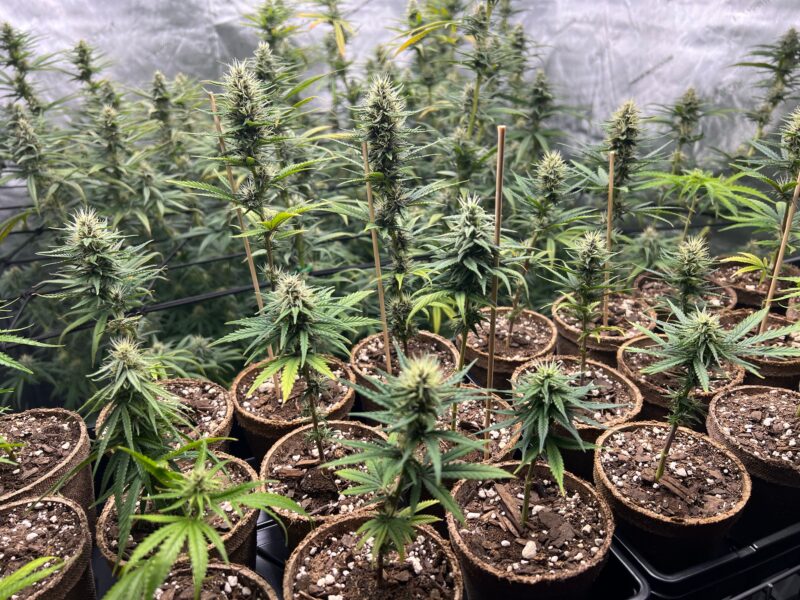
Note: If you don’t know the cannabis basics or you haven’t decided between outdoor or indoor growing, I advise you to start by reading the beginner’s guide.
Security Checklist

Lastly, your security is important. Check it:
- Keep your grow operation private; don’t tell or show anyone.
- Dispose of any grow-related materials discreetly.
- Avoid having seeds or grow products delivered to your home.
- Limit visits to grow stores and avoid risky associations.
- Never steal electricity; ensure all outlets are grounded and inspected regularly.
- Manage electricity use and maintain a clean air environment.
- Use carbon filters or ozone generators to neutralize odors.
- Muffle noise from equipment using insulated ducting and noise-reducing bases.
- Maintain a simple, low-profile lifestyle with a regular job and reason for increased electricity use.
- Be a good neighbor by keeping your property clean and paying bills on time.
Now, Let’s dive into detailed sections;
Seeds and Germination
Strong, healthy cannabis plants start with strong seeds and the right growing conditions. Each seed contains the genetic composition of a plant, carrying traits from both the male and female parents. These genetics determine the plant’s size, resistance to diseases and pests, root strength, leaf production, flower yield, and cannabinoid levels. The seed quality is the most important factor influencing how well the plant will grow and produce under either natural sunlight or artificial light.
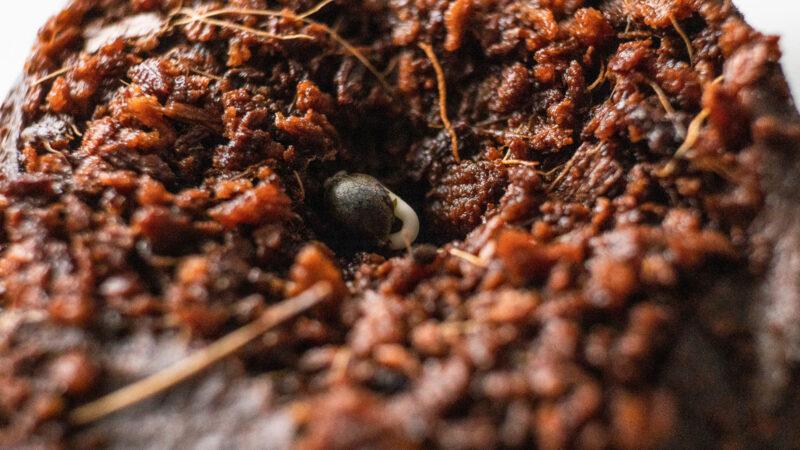
Seeds for Indoor Cannabis Grow
When it comes to growing cannabis indoors, your success starts with the right seeds. The seeds you choose will determine your plants’ size, health, and yield. Each seed contains the complete genetic makeup of the plant, influencing everything from resistance to pests and diseases to the amount of cannabinoids it will produce. And since growing indoors is all about controlling the environment, selecting the best seeds for indoor cultivation is essential.
Understanding Indoor Seeds
Indoor seeds are bred to thrive under controlled conditions like those you’ll find in an indoor grow room or tent. These seeds come from strains that perform well under artificial light, and they’re typically more compact than outdoor strains, which is ideal for smaller grow spaces. Most indoor seeds are from strains that can handle temperature and humidity fluctuations and are generally more resistant to pests—both factors that are easier to manage indoors. Plus, indoor seeds tend to have shorter flowering times, which means more harvests each year.
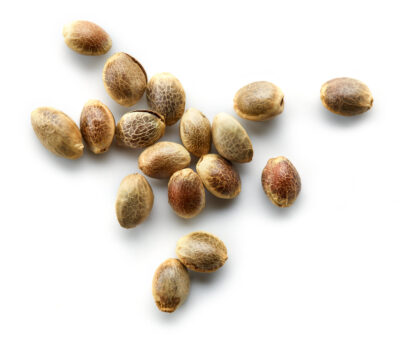
It’s all about choosing the right seeds for the setup you have. Think about your lighting (LEDs, HID, or fluorescent), your space (a grow tent, a closet, or a dedicated room), and your experience level when picking your seeds. You want seeds that match your grow environment.
Why You Need to Choose Carefully
Not all cannabis strains are built for indoor growing. Many strains grow tall and wide or require tons of sunlight, which isn’t always easy to replicate indoors. If you choose the wrong seeds, you might end up with plants that outgrow your space or don’t develop properly under artificial light.
Indoor growing also comes with its own set of challenges. You control everything, the light, the temperature, the humidity, and the airflow. This means you need seeds that will work within these parameters. Some strains are too finicky for indoor setups, and if they need a lot of room or take too long to flower, you could run into issues. The right seeds, however, will flower faster, stay manageable in size, and give you high yields even in small spaces.
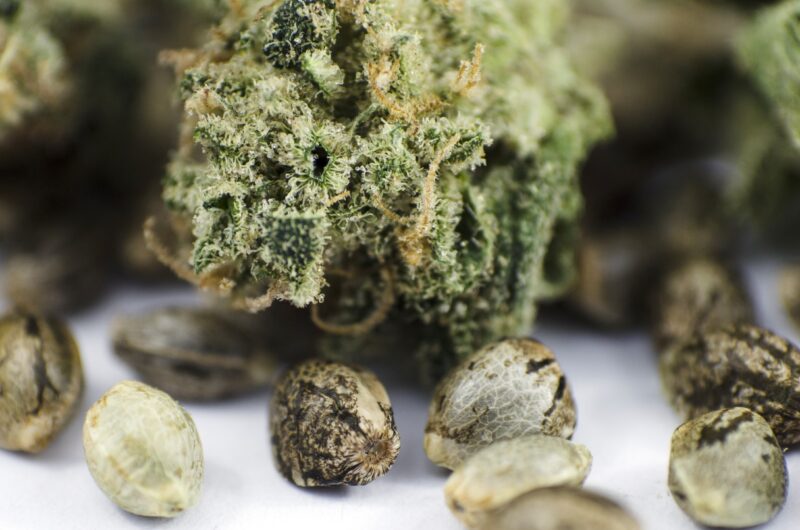
Types of Cannabis Seeds
When planning an indoor grow, it’s essential to understand the different types of cannabis seeds available. Each type comes with its own advantages and considerations, depending on the grower’s goals, experience level, and the specific conditions of the grow environment.
Regular Seeds
Regular cannabis seeds are produced through the natural pollination process between male and female cannabis plants. These seeds have a roughly 50/50 chance of growing into either male or female plants. For indoor growers, regular seeds will require extra attention during the early stages of growth to identify and remove male plants, which are not useful for bud production and can pollinate females, leading to lower-quality harvests.
Feminized Seeds
Feminized cannabis seeds have been specially bred to produce only female plants, which are responsible for producing the highly sought-after cannabinoid-rich flowers. Feminized seeds simplify the growing process and maximize bud production by eliminating the need to identify and remove male plants. This makes them an ideal choice for indoor growers, especially those with limited space or focused on maximizing yields.
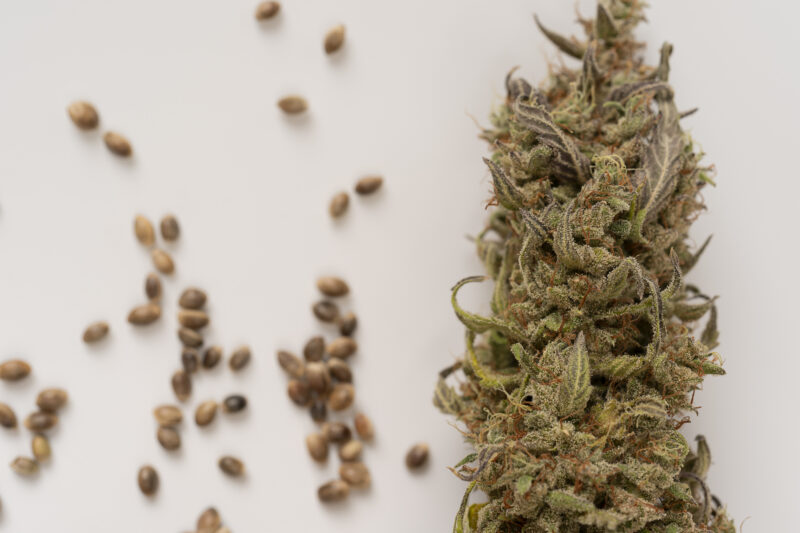
Blue Dream Feminized – A sativa-dominant hybrid loved for ease of growth, high yield, and balanced effects, making it a great option for both new and experienced indoor growers.
Autoflowering Seeds
Autoflowering cannabis seeds are popular because they don’t rely on a change in light cycles to start flowering. Instead, they flower based on age. Typically, they begin to flower just 2 to 4 weeks after sprouting, making them a good choice for growers who want fast results. These seeds are smaller and easier to manage, making them ideal for limited indoor space. However, autoflowers don’t always produce the biggest yields, but they’re a great option if you want a quick and hassle-free grow.
Northern Lights Autoflower – A compact indica-dominant strain with fast flowering times and a relaxing, body-heavy high, perfect for small indoor setups.
Fast Version Seeds
Fast version seeds, also known as “fast-flowering” seeds, are designed to shorten the flowering time of cannabis plants. These seeds are created by crossing photoperiod strains with autoflowering strains, resulting in plants that retain the high yields and potency of traditional photoperiod plants but have a shorter flowering period.
Fast version seeds are beneficial for indoor growers who want to speed up the growing process without sacrificing the quality or quantity of their harvest.
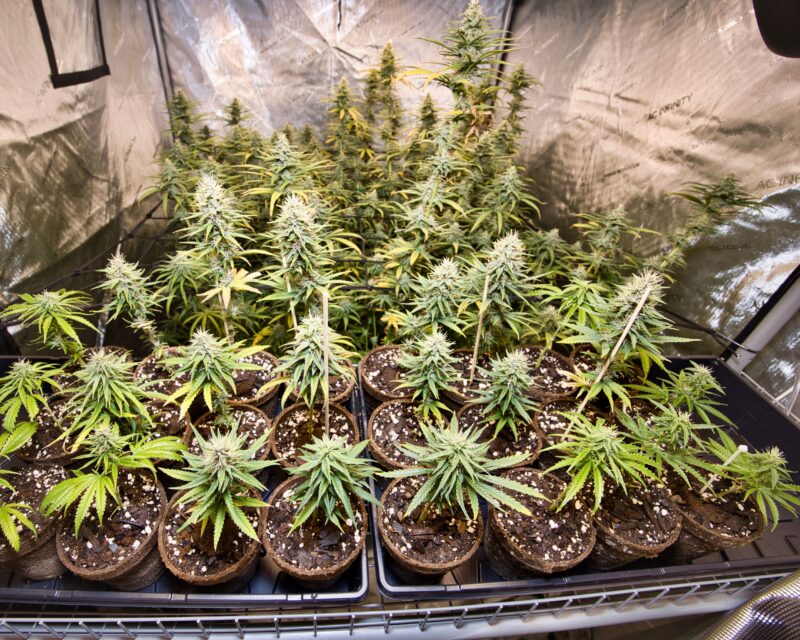
Critical Fast Version – Known for its quick flowering time and high THC content, this strain is perfect for indoor growers looking for a faster turnaround without compromising on potency.
How to Choose the Right Seeds
When it comes to picking the right seeds, you want to match the strain to your grow room. Here’s what to look for:
- Genetics: Genetics is everything. Choose seeds from breeders who are known for producing strains that do well indoors. Indica-dominant strains tend to be more compact, making them easier to manage in small spaces. Sativa strains, on the other hand, can grow taller, so if space is an issue, look for indica or indica-dominant hybrids.
- Flowering Time: In an indoor setup, you want strains with shorter flowering times. Anything between 7 and 9 weeks is a good bet for maximizing harvests.
- Size and Structure: If you’re growing in a smaller tent or room, stick with compact strains that don’t stretch too much during flowering. Indica strains are naturally shorter and bushier, while sativa strains can get tall. You can also train your plants using methods like topping or low-stress training (LST) to control their height.
- Cannabinoid Profile: Know what kind of effect you’re after. If you want a high-THC strain for a strong psychoactive effect, choose seeds bred for high THC content. If you prefer something more balanced with CBD for medical purposes, pick a strain with a higher CBD-to-THC ratio.
- Indoor Suitability: Not all strains are bred for indoor conditions. Look for strains that are labeled as suitable for indoor growing. These strains are usually more resilient and better adapted to artificial light and smaller spaces.
Finding Cannabis Seeds
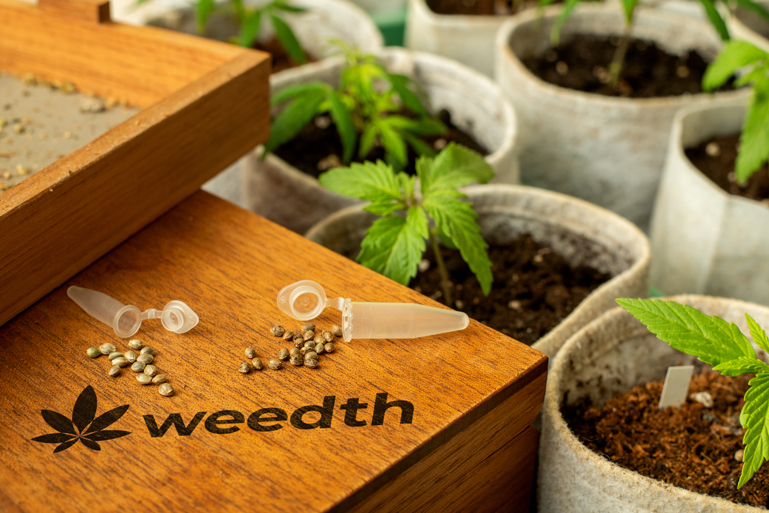
Buying seeds can be tricky, especially with so many unreliable sources floating around. If you’ve got a trusted friend who can hook you up with some quality seeds, that’s your best bet. But let’s be real—not everyone has that option. So, your next best move is to buy seeds online. Now, this is where it gets a little dicey.
There are a lot of sketchy companies out there these days. I’ve heard more horror stories than I can count—people paying top dollar for seeds that never arrive, websites disappearing overnight, phone lines disconnected. Poof! There goes your $250. Buying seeds is not something you want to gamble on. You need to be extremely careful. Don’t just order from anyone. Stick to a reputable, reliable company. You can find good seed banks online, in certain magazines, or even local coffee shops (depending on where you live).
If you’re buying online, make sure you do your homework. Search the seed bank on Google, check reviews, and ask other growers. You want to be absolutely sure they’re legit before sending any money. Only order from seed banks that have a proven track record and take every precaution to ensure your seeds arrive discreetly and securely.
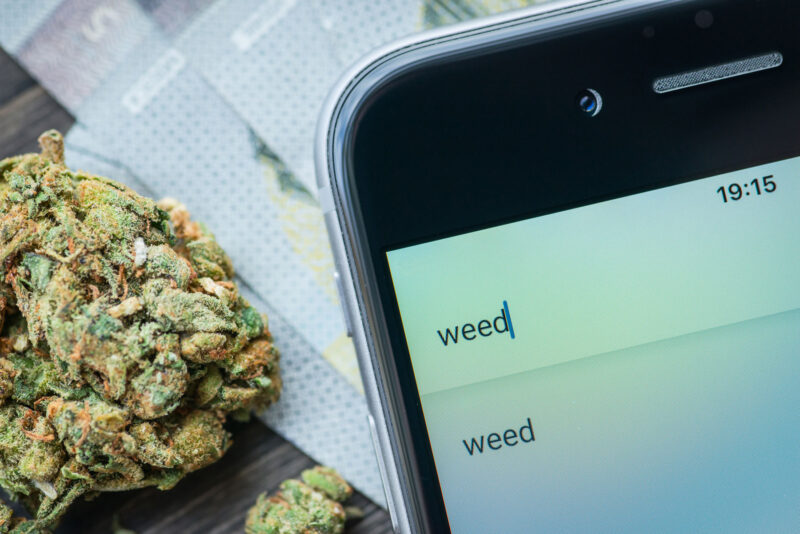
A good rule of thumb? Buy more seeds than you think you’ll need. Even with the best seeds, you might have some germination failures—it happens. And always, always use a safe shipping address. Never, under any circumstances, have the seeds sent directly to your grow site. This is still illegal in many parts of the world, including the U.S., so make sure you know the laws in your area before ordering.
You can find cannabis seeds from a variety of sources, but make sure you’re getting them from a reputable supplier. Here are your options:
- Seed Banks: These are your best bet for finding high-quality seeds. A good seed bank will have a wide variety of strains, including indoor-specific, feminized, and autoflowering seeds. Look for one that provides detailed information about each strain, including flowering times and yield potential.
- Online Seed Shops: Many seed shops operate online, making it easy to browse and buy seeds from the comfort of your home. Always check reviews and feedback from other growers to make sure the seed shop is legitimate.
- Cannabis Dispensaries: In places where cannabis is legal, dispensaries often sell seeds. You can get good recommendations and find seeds that are suited to your specific climate and grow setup.
- Find Seeds in a Bag of Buds: If you’ve ever bought a bag of weed and found a few seeds in there, you’ve got what are known as “bag seeds.” While these seeds can sometimes grow into great plants, they’re a bit of a gamble. You won’t know what you’re getting until you grow them, and the plants may not be stable or as potent as you’d like.
Seed Quantities and Pricing
Most seed banks and shops sell seeds in packs of 5, 10, or 15. Pricing varies based on the strain and whether the seeds are feminized or autoflowering. You can expect to pay anywhere from $3 to $30 per seed. Lower-priced seeds can still produce good plants, but the higher-priced seeds are usually more stable, producing consistent results with better yields and potency.
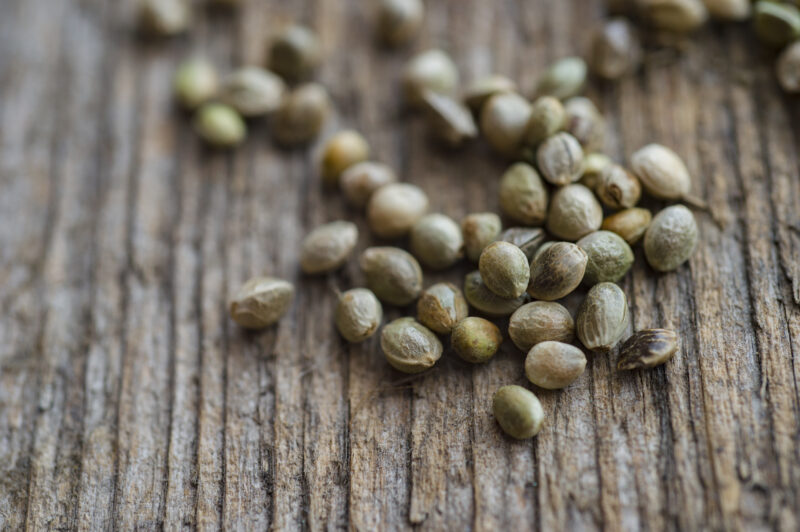
A pack of 5 to 10 seeds is usually enough for personal grows. If you’re growing on a larger scale or for commercial purposes, buying seeds in bulk is more cost-effective.
Receiving Seeds
When your seeds arrive, check them for damage right away. If any are crushed or broken, contact the seller to arrange a replacement. Always store your seeds properly to keep them viable if you’re not planting them immediately.
Storing Seeds
Proper storage is for keeping your seeds viable for future grows. Cannabis seeds are living organisms, and if you don’t store them right, they’ll lose their ability to germinate. Here’s how to store your seeds:
- Temperature: Keep your seeds in a cool place. A temperature range of 35–41°F (2–5°C) is ideal. Many growers store seeds in the refrigerator to maintain a consistent temperature.
- Humidity: Seeds need to stay dry. Humidity can cause them to sprout prematurely or grow mold. Store them in an airtight container with a desiccant (like silica gel) to keep the moisture levels low.
- Light: Light can trigger the germination process, so keep your seeds in a dark place. Use opaque containers or store them in a closet or drawer to protect them from light.
- Labeling: Always label your seeds. Write down the seed names, strain information, and the date you stored them on each container or packet. This way, you can easily keep track of different strains and know how long the seeds have been stored.
If stored correctly, cannabis seeds could last for years. However, the longer you store them, the lower the germination rate, so try to use them within a year or two for the best results.
What Are Strains?
Cannabis strains are the genetic variations within the species, each bred for its unique traits. Think of strains as the DNA for your plants—they determine everything from growth patterns, size, and flowering time to flavor, potency, and effects. Whether you’re growing for medicinal purposes, recreational use, or just looking to maximize your indoor yields, selecting the right strain is a critical step. Choose carefully, because the strain you pick will dictate how well your plants perform in your indoor environment.
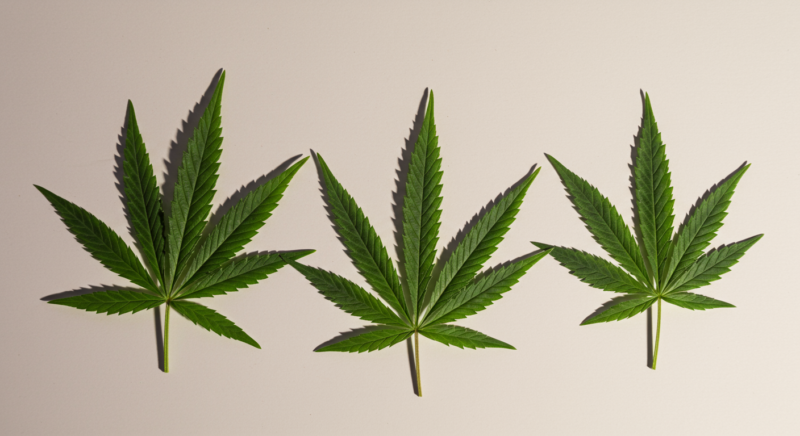
Strains come in three primary types: indica, sativa, and hybrids. Indicas are known for their short, bushy growth, quick flowering times, and deeply relaxing effects. Sativas, on the other hand, are tall and thin, often taking longer to flower but delivering a more energizing, cerebral high. Hybrids combine the characteristics of both, offering a mix of effects and growth traits. Understanding these differences will help you select the right strain for your setup and goals.
Types of Cannabis Strains
Indica strains are typically the excellent for indoor growers. They’re short and stocky, making them ideal for small grow spaces. Indicas originated in harsh, mountainous regions, so they’re naturally hardy and fast-flowering, usually finishing up in 7–9 weeks. They tend to produce dense, resinous buds that pack a powerful, body-heavy high. Indica plants are generally easier to manage indoors because of their compact size, making them perfect for grow tents or closets.
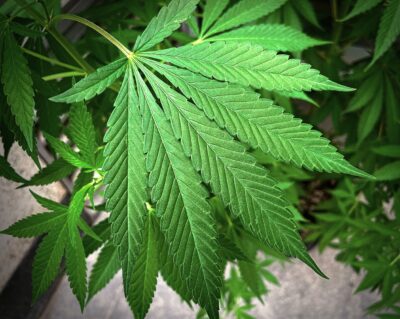
Sativa strains, can be more of a challenge indoors. They’re tall and lanky, sometimes stretching significantly during the flowering stage. Sativas typically take longer to flower—anywhere from 10 to 14 weeks—but their high delivery is worth the wait. Their effects are uplifting, energizing, and more cerebral. Sativa-dominant strains are ideal for daytime use, creativity, and social situations, but you’ll need plenty of vertical space and a bit more patience to grow them indoors.
Hybrids offer the best of both genetics. Hybrid cannabis plants are created by combining different types of strains. These hybrids can have a mix of the effects and characteristics of both indica and sativa plants. This means you can get a balanced combination of the different effects and growing qualities.Indoor growers often prefer hybrid strains for their adaptability to different indoor growing environments. You’ll find indica-dominant hybrids that flower quickly and stay manageable in size or sativa-dominant hybrids that deliver a more uplifting high but without the excessive height of a pure sativa.
Recommended Strains for Indoor Growing
The strain you choose for your indoor grow will depend on your space, experience, and the kind of effects you want from your plants. Here are some solid choices for indoor cultivation:
- Northern Lights: This indica-dominant strain is a tried-and-true indoor performer. It’s fast-flowering, stays compact, and produces dense, resin-covered buds. Its strong, relaxing effects make it perfect for nighttime use or stress relief.
- White Widow: A well-balanced hybrid that produces high yields of potent, frosty buds. White Widow is easy to grow indoors and offers a balanced high that’s both uplifting and relaxing, making it a great choice for any time of day.
- Blue Dream: A sativa-dominant hybrid that’s forgiving to grow and yields large, flavorful buds. Its balanced high makes it popular among both medical and recreational users, and it thrives in an indoor environment with proper care.
- Critical Mass: Known for its massive yields, Critical Mass is an indica-dominant strain that flowers quickly and produces heavy buds. It’s ideal for growers looking to maximize their harvest in a short time frame.
- Amnesia Haze: A long-flowering sativa strain that rewards experienced growers with high yields and a potent, energizing high. If you’re willing to invest the time and have the vertical space, this strain can produce impressive results indoors.
When selecting a strain for indoor growing, it’s all about balancing flowering time, plant size, and the kind of high you’re after. You want a fast, body-heavy indica or a longer-flowering sativa, the right strain can make all the difference in your grow room.

Warning: Make sure the seeds you’re buying match your indoor grow conditions. The last thing you want is a strain that stretches to 10 feet when you’re working with limited space like a grow tent or cabinet. Choose wisely, and stick to strains that stay compact and manageable. Selecting seeds suited to your setup, you’ll avoid a lot of headaches and ensure smooth, potent, and rewarding growth from start to finish.
Germination
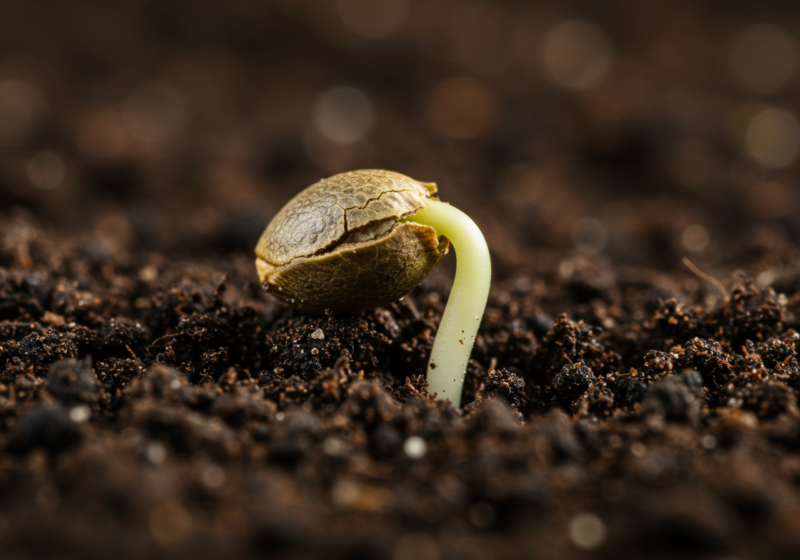
Germination is where it all starts. It’s the most critical phase of your cannabis grow because if you don’t get your seeds to sprout, you’ve got nothing to work with. When you germinate seeds, you wake them up—kickstarting the plant’s life cycle. This process needs the right combination of warmth, moisture, and air. The purpose is to create an environment that mimics the natural conditions a seed would experience in nature but with a bit more control to ensure success.
The first thing to understand is that not all seeds are created equal. Quality genetics are crucial, so make sure you’re working with mature, viable seeds. Good seeds are hard and dark-colored, often with a slight sheen. Immature seeds, which are pale or green, probably won’t germinate or, if they do, will struggle to develop into strong plants. You have to work with fresh seeds stored properly for the best results.
Temperature plays a huge role in the germination process. Seeds need warmth—ideally between 70-85°F (21-29°C). If it’s too cold, the seeds may not germinate or will take longer. Humidity also helps but don’t overdo it. You want to keep the environment moist but not waterlogged. Too much moisture can drown the seeds, cutting off their oxygen supply.
Timing is critical as well. Generally, seeds will sprout within 24-72 hours under the right conditions, but some might take a bit longer, depending on the strain or how old the seeds are. Once the seed cracks and the root emerges, it’s time to transplant it into your growing medium. Handle the seed gently—this is the most delicate stage of the plant’s life, and damaging the taproot will stunt its growth or kill the seedling altogether.
Remember, don’t rush things, be patient. If the seeds are viable, they will sprout. The main focus here is maintaining a stable environment with warmth, moisture, and air. Once the seedling breaks through and starts to develop its first leaves, you’re officially out of the germination stage and on your way to a healthy cannabis grow.
Germination Step by Step
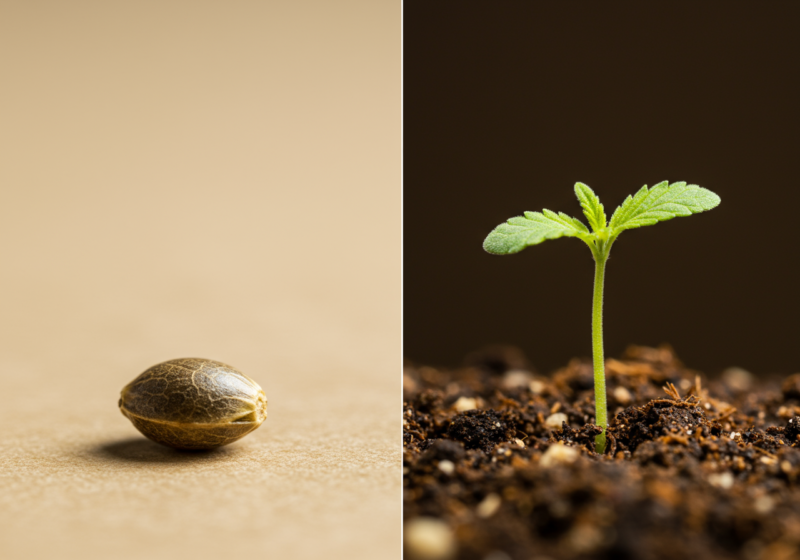
No matter you’re a first-time grower or a seasoned veteran, getting cannabis seeds to sprout is one of the most exciting stage. Proper germination leads to strong, healthy seedlings that form the foundation for a successful grow. Let’s walk through each step of the germination process, along with techniques to maximize your chances of success.
Step 1: Preparing Your Seeds
First things first—make sure you’re starting with quality seeds. Fresh, mature seeds will give you the best results. They should be hard, dark brown with a slight sheen, and free from any cracks or deformities. Green, pale, or soft seeds are likely immature and may not germinate properly. Old seeds may still sprout, but their vigor will be reduced, and you may have lower germination rates.
Step 2: Choosing a Germination Method
There are a few popular methods for germinating cannabis seeds, and each grower may have their preference. Here’s an overview of the most effective techniques.
The Paper Towel Method
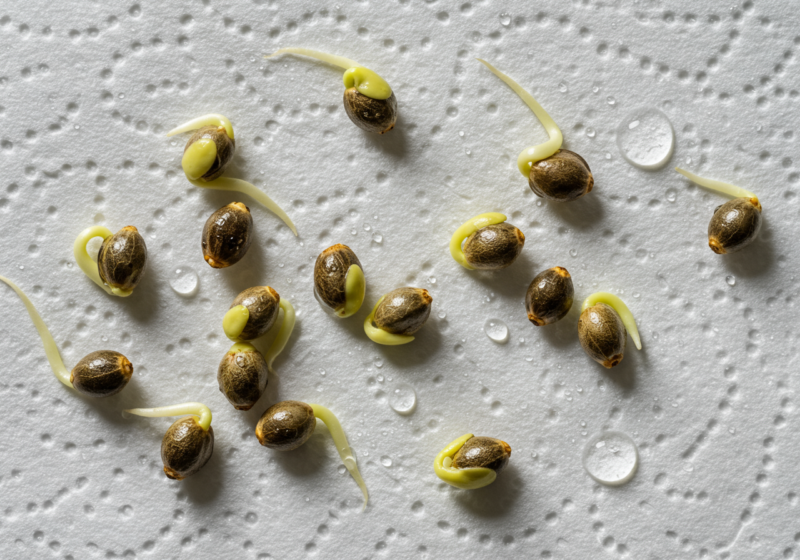
The paper towel method is simple, effective, and widely used. Here’s how it works:
-
- Moisten two clean paper towels with distilled water. You want them damp but not dripping wet.
- Place your seeds between the two moist paper towels.
- Place the paper towels on a plate and cover them with another plate to create a dark, moist environment.
- Keep the plate in a warm place—ideally around 70–85°F (21–29°C). The top of a refrigerator or a cabinet works well.
- Check on the seeds daily, ensuring the towels stay moist. In 24 to 72 hours, you should see the seeds crack open, and a tiny white root (called the radicle) will start to emerge.
Direct-to-Soil Method
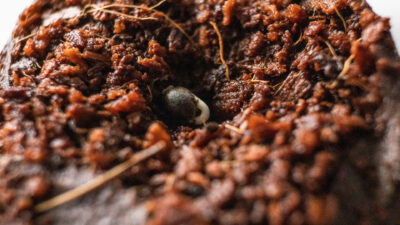
This method mimics nature and is great for growers who prefer to keep things simple. With this method, the seeds germinate directly in the growing medium.
-
- Fill small pots with light, airy soil or a seed-starting mix that drains well.
- Make a small hole about 0.25 inches (6mm) deep and place the seed in it, pointy end down.
- Lightly cover the seed with soil and water it gently with a spray bottle to moisten the area.
- Keep the soil consistently moist (but not waterlogged) and ensure the temperature stays between 70–78°F (21–26°C).
- In about 3 to 7 days, your seed will break through the surface, and a small seedling will appear.
Soaking in Water Method
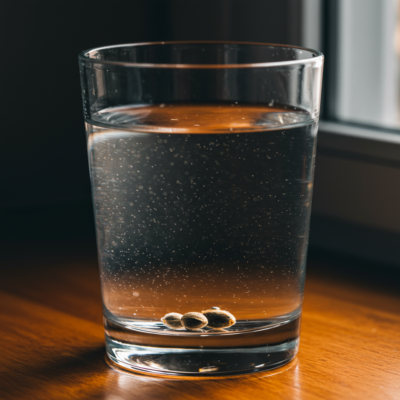
This method helps to speed up the process for older seeds that may have trouble germinating. It softens the outer shell, allowing water to penetrate and activate the seed more easily.
-
- Place your seeds in a glass of room-temperature distilled water.
- Let them soak for 12 to 24 hours. After that time, the viable seeds should sink to the bottom.
- Once you see the seed crack and a small taproot emerge, carefully move the seed to soil, a paper towel, or rock wool.
Rock wool or Peat Pellets
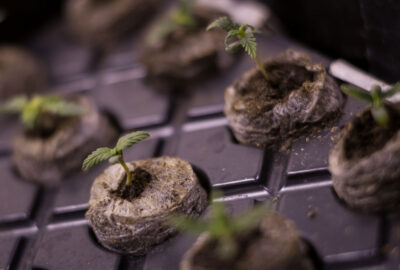
Rockwool cubes or peat pellets are excellent for hydroponic systems or for growers looking for more control over moisture levels.
-
- Soak the cubes in pH-balanced water (about 5.5–6.0 pH) before placing the seed into the hole at the top of the cube.
- Place the cube in a warm, humid environment (you can use a propagator or humidity dome) and keep the temperature steady.
- Within a few days, the seed should sprout, and roots will begin growing through the rock wool or peat pellet.
Step 3: Optimal Conditions for Germination
The key to successful germination lies in maintaining the right environment. Cannabis seeds need warmth, moisture, and darkness to sprout. Here are the optimal conditions for germination:
- Temperature: Keep your seeds in a warm area. The ideal temperature range is 70–85°F (21–29°C). If the temperature drops too low, the germination process will slow down or stop altogether.
- Moisture: Seeds need to stay moist but not soaked. Too much water can drown the seeds and cut off their oxygen supply, while too little water will prevent them from sprouting.
- Humidity: A humidity level of around 70% is ideal. If you’re using a humidity dome or propagator, it will help maintain moisture in the air and keep the seeds from drying out.
- Darkness: Seeds germinate best in the dark, so make sure your growing environment is shaded or covered until the seedlings break through the surface.
Step 4: Advanced Techniques: Scarification for Faster Germination
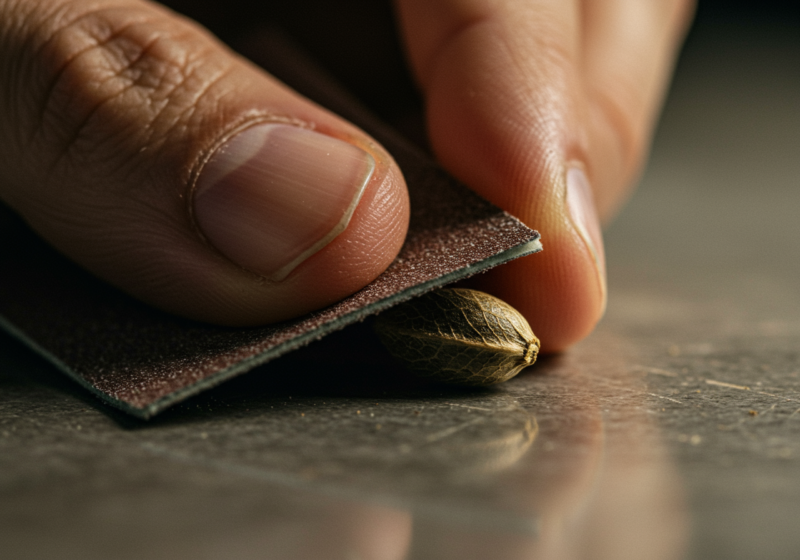
Scarification is an excellent technique for those looking to speed up the germination process or dealing with older, tougher seeds. Scarification is lightly sanding or scratching the seed’s outer shell to make it easier for water to penetrate and activate the seed.
However, if you’re a beginner, avoid this technique—it requires a careful touch, and it’s easy to damage the seed if you’re not experienced. Stick to the more simple methods for now.
Here’s how to scarify your seeds:
- Lightly Sand the Seeds: Take a small piece of fine sandpaper (around 120–150 grit) and gently rub the seed on it, just enough to roughen the surface. You don’t want to damage the seed, only to thin out the hard outer shell slightly.
- Use the Matchbox Trick: Some growers use a matchbox lined with sandpaper for scarification. Simply place your seeds in the matchbox and give it a gentle shake for about 10–15 seconds. This will scar the seeds enough to improve water absorption without risking too much damage.
- Soak After Scarifying: After scarifying the seeds, soak them in water for 12 to 24 hours to kickstart the germination process. The scarification will help the seed absorb water more effectively, allowing the taproot to break through faster.
Scarification can improve germination rates, especially for older seeds or seeds with particularly tough shells. However, this technique should be done carefully to avoid damaging the embryo inside the seed.
Step 5: Transplanting Your Seedlings
Once the seeds sprout and the taproot appears, it’s time to transplant them into their growing medium if you haven’t already planted them directly in soil. Handle the seeds gently, as the taproot is extremely delicate.
If you used the paper towel method, use clean tweezers to move the sprouted seed into its final growing medium. The taproot should point downward, and the seed should be covered lightly with soil.
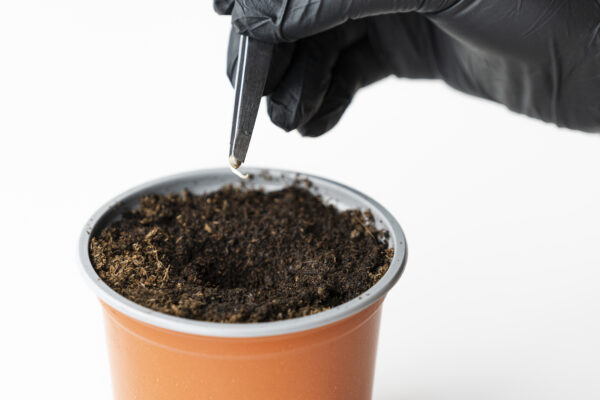
For those using rock wool cubes or peat pellets, you can move the entire cube or pellet into the soil or hydroponic system once the roots begin to poke through.

Step 6: Early Seedling Care
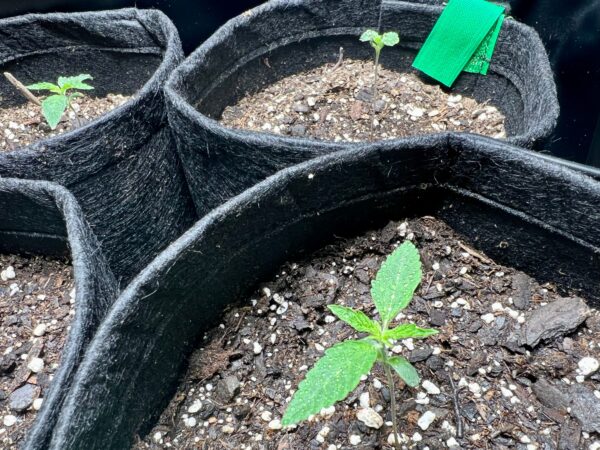
Now that your seeds have sprouted, they will enter the seedling stage. This is when the plant focuses on developing its root system and initial leaves (called cotyledons). Here’s what you need to do to support healthy growth:
- Light: Seedlings need a light source, but not too intense at first. A CFL or LED light placed about 12–18 inches above the seedlings is ideal. Keep the lights on for 16–18 hours per day.
- Watering: Keep the growing medium moist, but don’t overwater. Seedlings are fragile, and too much water can easily damage their roots. Water them lightly with a spray bottle or drip system to avoid disturbing the roots.
- Air Circulation: Ensure there’s good airflow around your seedlings. A small oscillating fan can help strengthen the seedlings and prevent mold or damping-off, a disease that can kill young plants.
- Temperature and Humidity: Keep the temperature between 70–78°F (21–26°C) and humidity around 60–70%. You can gradually lower the humidity as the plant grows.
Troubleshooting Common Germination Problems
Even with the best preparation, problems can arise during germination and early seedling growth. Knowing what to look for and how to fix issues quickly is critical for giving your plants the best chance to thrive. Here are some of the most common problems you might face and how to solve them:
Seeds Won’t Germinate
This is often caused by old or damaged seeds. Seeds that are too old may have lost their viability, and damaged seeds might not sprout at all. Always store seeds in a cool, dry place and use fresh, healthy seeds for the best germination results.
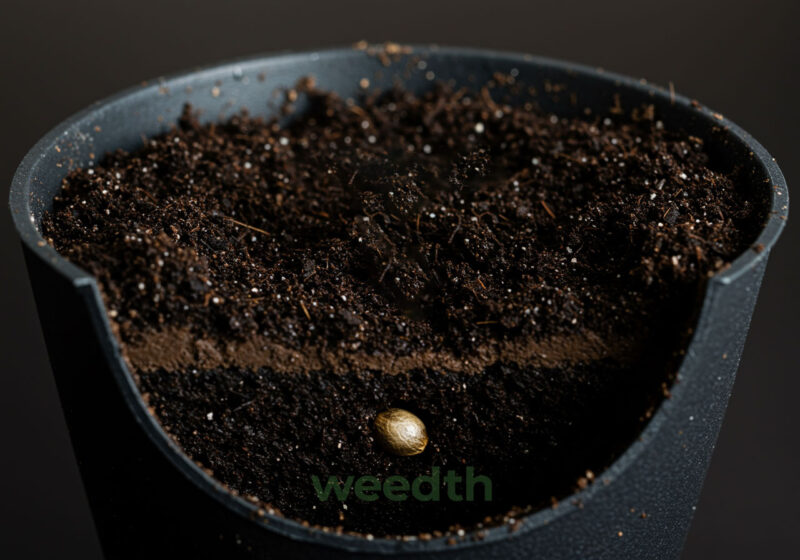
Solution: If you’re having trouble, try soaking your seeds in water for 12 to 24 hours to soften the outer shell and encourage germination. If they still don’t sprout, the seeds may be beyond saving.
Damping-Off
Damping-off is a fungal disease that affects seedlings, causing them to wilt and die quickly, often within hours. It usually happens when seedlings are kept too moist or too warm, creating the perfect environment for fungi to grow.
Solution: Avoid overwatering and keep the growing area well-ventilated. Use sterile soil or growing medium and maintain proper airflow with an oscillating fan. If damping-off occurs, remove and discard affected seedlings immediately to prevent the spread of the fungus.
Weak Seedlings (Stretching)
If your seedlings are growing tall, thin, and spindly, Insufficient lighting is often the cause of this issue. They stretch upward in search of a stronger light source, which weakens their structure and leaves them vulnerable to tipping over.
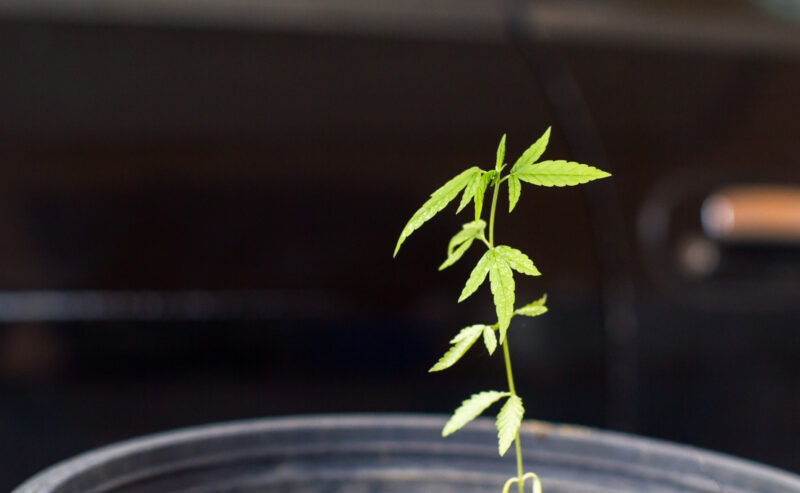
Solution: Move your light source closer to the seedlings. Ideally, keep CFL or LED lights about 12–18 inches above the seedlings. Ensure they get at least 16–18 hours of light daily. You can also use a small fan to gently blow on the seedlings, encouraging stronger stem growth.
Overwatering and Underwatering
Overwatering is one of the most common mistakes growers make during germination. Too much water suffocates the seeds and prevents them from accessing oxygen, leading to root rot and slow growth. On the flip side, underwatering causes the seeds and seedlings to dry out, stunting their growth or killing them altogether.
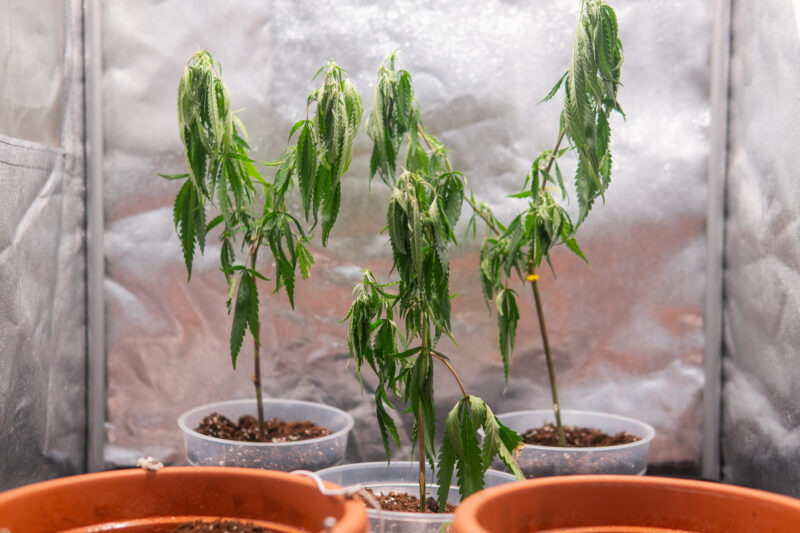
Solution: Keep the growing medium evenly moist but not soaked. A good rule of thumb is to check the surface of the medium—if it’s dry to about 0.25 inches (6mm) deep, it’s time to water. If you’re using rockwool cubes or peat pellets, make sure they are not sitting in standing water. Allow for proper drainage, and adjust your watering schedule based on the depth of the container—shallow trays may need daily watering, while deeper pots can go for three or more days between waterings.
Light Intensity Issues
Too much light can burn delicate seedlings, while too little light leads to poor growth. Cannabis seedlings are sensitive to light intensity, so it’s important to get it right.
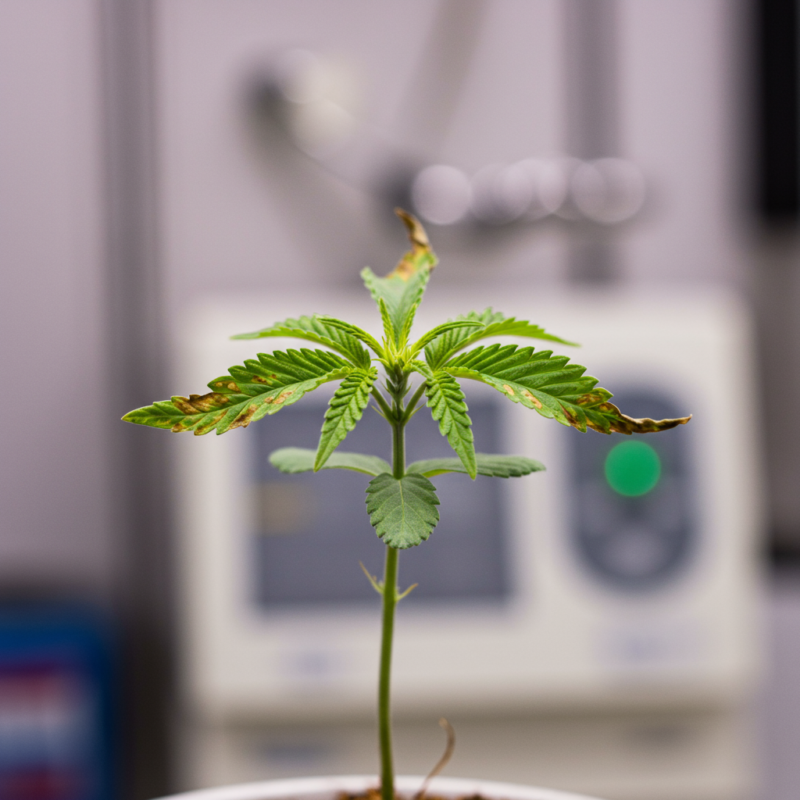
Solution: If you notice leaf burn or curling, move your lights further away (at least 12 inches for CFLs or LEDs). If the seedlings are stretching too much, you may need to move the lights closer or increase the light intensity. Aim for a balanced light environment that supports healthy, strong growth.
Genetic Issues
Sometimes, poor seedling growth can be traced back to genetics. You might encounter “freak” seedlings that grow abnormally due to unstable or poor-quality genetics. These seedlings may show stunted growth, unusual leaf patterns, or mutations like trifoliate leaves (three sets of leaves instead of the usual two).
Solution: Unfortunately, there’s not much you can do about bad genetics. If you notice weak or mutated seedlings, it’s best to remove them and focus your energy on the stronger plants. Always source your seeds from reputable breeders to ensure you’re getting stable, high-quality genetics.
Nutrient Overload
New growers often make the mistake of feeding seedlings too soon. Seeds contain all the nutrients they need for the first few weeks of life, and adding fertilizers or nutrients too early can disrupt the internal chemistry of the seedlings, leading to nutrient burn or stunted growth.
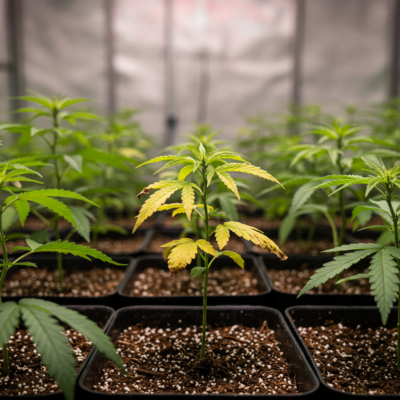
Solution: Avoid giving seedlings any nutrients for the first two to three weeks. Household water contains enough dissolved solids to nourish the seeds during this time. When you do begin feeding, start with a very dilute solution to prevent overloading the young plants with nutrients.
Poor Drainage
If your growing medium doesn’t drain well, excess water can build up, leading to waterlogged roots and poor oxygen absorption. This can cause slow growth or root rot.

Solution: Always use a well-draining soil mix or growing medium. If you’re using containers, make sure they have drainage holes. Setting your planting flats or rockwool cubes on a grate will help improve air circulation and drainage.
Transplanting Seedlings
Once your seedlings have sprouted and developed a strong enough root system, it’s time to transplant them. This is a critical step in the growing process. If done correctly, your plants will thrive in their new environment and continue growing healthy and strong. But if you rush it or mishandle the delicate seedlings, you risk stunting their growth or, worse, killing them.
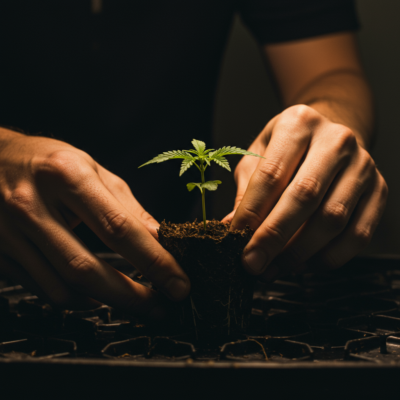
First, you must know when your seedlings are ready to be transplanted. A good rule of thumb is to wait until they have at least two to three sets of true leaves (those first round cotyledon leaves don’t count). At this point, the roots should be well-established but not yet root-bound. You’ll want to handle the seedlings gently, especially the roots, which are fragile at this stage.
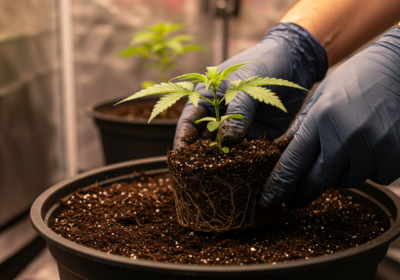
Before you start transplanting, make sure your new containers are prepped. Choose pots that allow the roots to expand and develop. Typically, moving seedlings into 1 to 2-gallon pots is a safe bet, but if you’re working with a faster-growing strain or aiming for larger plants, you might go bigger. Fill the pots with your growing medium—soil, coco coir, or another substrate—and ensure it’s well-aerated and drains properly.
Here’s how you do it:
- Water Before Transplanting: Give your seedlings a light watering before you transplant. This helps keep the root ball intact and makes it easier to remove the seedling from its current container without damaging the roots.
- Prepare the New Pot: Make a hole in the center of your new pot that’s big enough to accommodate the seedling’s root ball. You should transplant it into a hole just deep enough so that the plant sits at the same depth it was growing before.
- Gently Remove the Seedling: Be careful here. If your seedling is in a small plastic pot or tray, gently squeeze the sides to loosen the root ball. If it’s in a peat pellet or rockwool cube, you can transplant it directly, but still handle the plant with care. The taproot is sensitive, and rough handling can set your plant back.
- Place and Cover: Place the seedling into the hole in its new container, making sure the roots are spread out slightly. Lightly fill the surrounding area with your growing medium, and gently press it down to eliminate air pockets, but don’t pack it too tightly.
- Water In: After transplanting, give the seedlings a good watering to help them settle into their new environment. Make sure the water penetrates deep enough to reach the roots, but don’t drench them. Keep an eye on your plants for the first few days after transplanting, as this is a sensitive time for them.
Now that your plants are transplanted, they’ll need a bit of time to adjust to their new surroundings. Don’t be surprised if they seem a little droopy for the first day or two—it’s normal for them to experience a bit of transplant shock. Just keep the environment stable, and they’ll bounce back quickly.
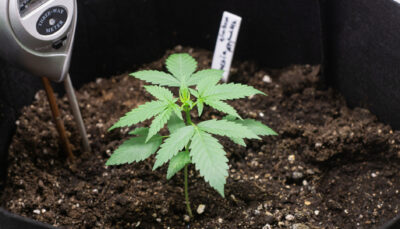
Remember, successful transplanting is all about minimizing stress on the plant. Be gentle, keep the root ball intact, and make sure the new pot offers plenty of room for root growth. Done right, this step will set the stage for strong, vigorous plants that will reward you down the line.
Stages of Cannabis Growth
Understanding the life cycle of cannabis is essential for any successful grow. Like most plants in nature, cannabis goes through several distinct stages of growth. It’s an annual plant that completes its entire life cycle in one growing season. If you plant a seed in the spring, it will grow vigorously through the summer, hit the flowering stage in the fall, and produce seeds before dying off. Those seeds then sprout the following year, continuing the cycle.
Cannabis has three main stages of development: germination/seedling, vegetative, and flowering (or budding). You can control these stages in an indoor setup to fit your grow schedule, but the natural process stays the same.
The growth stages follow this order:
Germination -> Seedling -> Vegetative -> Pre-flowering -> Flowering.
Each phase plays a critical role in the plant’s development. During germination, the seed comes to life and becomes a seedling. Then, during the vegetative stage, the plant focuses on building strong roots, stems, and leaves. Finally, once flowering is triggered by a change in light cycles, the plant puts all its energy into producing buds.
Cannabis plant completes its life cycle in one season in nature, but when grown indoors, you can control the environment. This allows you to harvest multiple crops a year if you time everything right. You must understand that each growth stage is important for successful growth—knowing when to transition from one stage to the next will ensure your plants are healthy and productive from seed to harvest.
Vegetative Growth
After four to six weeks of seedling growth, cannabis enters the vegetative growth stage—arguably the most important phase for establishing a healthy plant. During this stage, your plants focus all their energy on building a solid foundation: developing thick stems, sturdy branches, and plenty of lush green leaves. The stronger and healthier the plant is in the vegetative phase, the more potential it has for a heavy harvest when flowering begins.
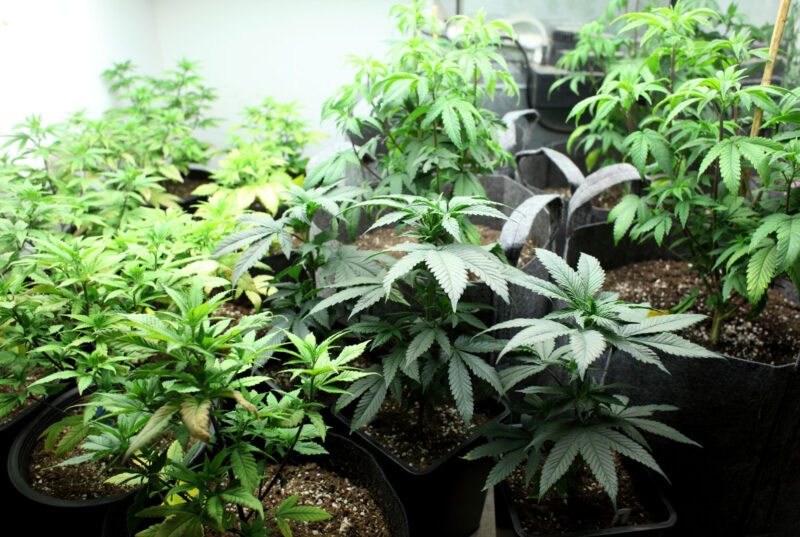
The vegetative stage can last indefinitely indoors, provided your plants receive enough light. Cannabis remains in vegetative growth with 16–24 hours of light per day, and the more light your plants get, the faster they will grow. Some strains can continue vegetative growth for over a year, theoretically forever, as long as they receive consistent light. This is especially useful for mother plants that you want to keep in vegetative growth for cloning.
The Importance of Strong Vegetative Growth
Healthy vegetative growth is crucial for future yields. During this phase, plants can grow 1–2 inches per day under optimal conditions, developing thick stems and branching out. The faster your plant grows in the vegetative phase, the more robust it will be during flowering. A plant that’s stunted or weak now will produce much less during flowering, so avoid rushing it into the next stage. If your plants seem weak or small, hold them back and give them time to build strength before inducing flowering.
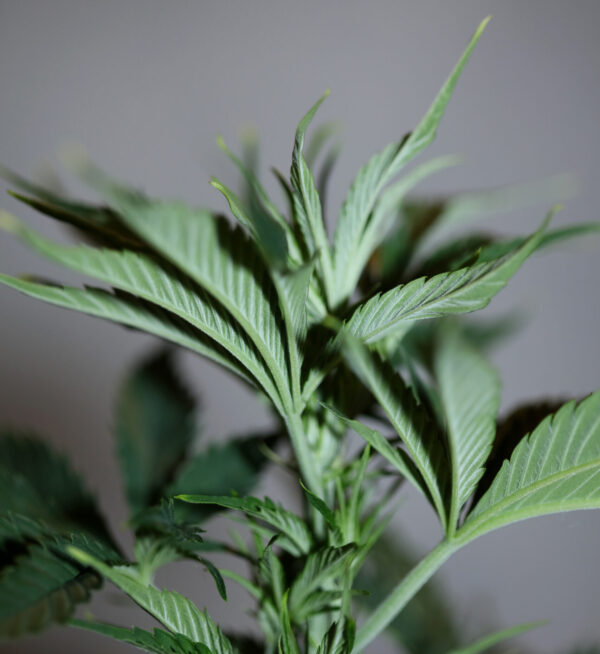
Nutrient uptake is critical in this stage, and plants will use water and nutrients more rapidly as they grow. Nitrogen is particularly important for vegetative growth, as it fuels stem and leaf development. A balanced nutrient solution with trace elements like potassium, phosphorus, sulfur, magnesium, and calcium will help your plants grow strong and healthy. Be sure to follow the manufacturer’s recommended dosage and adjust based on how your plants respond.
Managing Light During Vegetative Growth
Light is one of the most critical factors during the vegetative stage, and getting it right will make a huge difference in how quickly your plants grow. Aim to provide 18–24 hours of light per day to keep your plants in continuous vegetative growth. Some growers prefer to give plants a dark period during vegetative growth, usually with an 18/6 light/dark cycle (18 hours of light and 6 hours of darkness). This approach mimics the natural sunlight cycle and gives the plants time to rest, allowing the stomata (the tiny pores on the leaves) to open fully and improve gas exchange. The dark period also helps to manage temperature and energy use in your grow space.
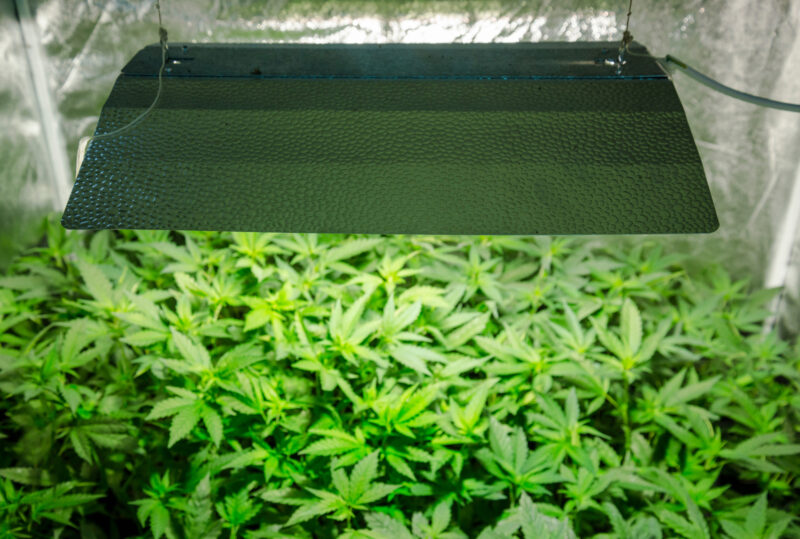
However, many experienced growers prefer to leave the lights on for 24 hours a day during vegetative growth. Cannabis plants do not require a dark period in this stage, and continuous light can speed up growth by about 30%. Without a dark period, plants photosynthesize continuously, which means they’re constantly producing energy for growth. This is particularly effective for fast-growing strains or growers looking to shorten the vegetative stage.
The choice between 18/6 and 24-hour light cycles is up to you. If you notice your plants thriving with a dark period, keep it. If not, try leaving the lights on continuously. Both methods work, but the key is to remain consistent. Sudden changes in light cycles can stress the plants, so once you pick a schedule, stick to it.
The same principles apply to mother plants, which you want to keep in vegetative growth for an extended period. A mother plant needs 18–24 hours of light daily to stay in the vegetative phase and prevent flowering. Most growers stick to 18 hours of light for mother plants, as this helps conserve energy and keeps the plant healthy without pushing unnecessary growth. Since mother plants are primarily used for cloning, the goal is to keep them alive and thriving without overstimulating them.
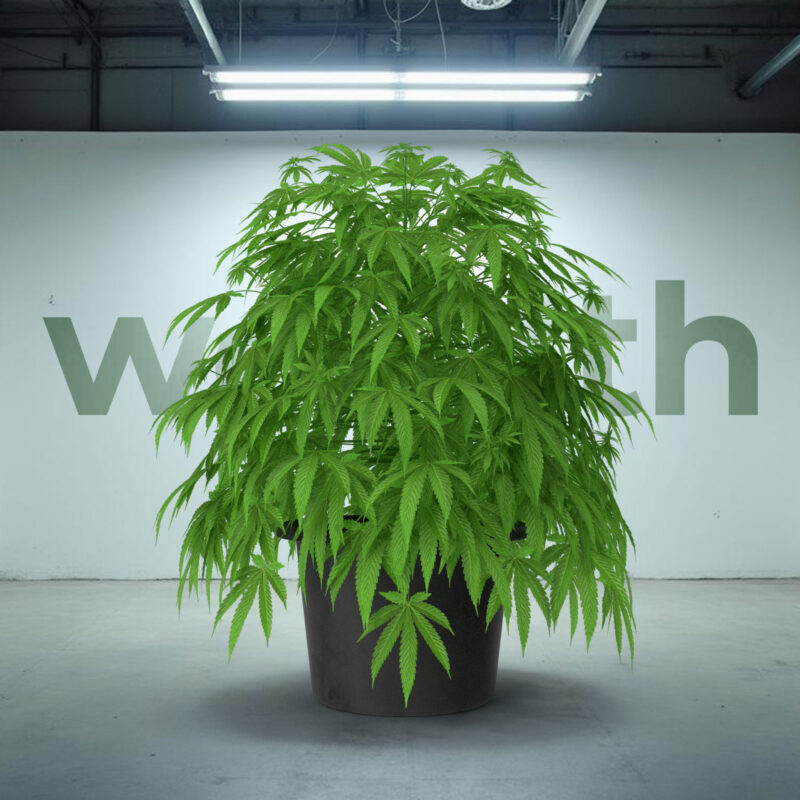
When managing light for mother plants, make sure to focus on keeping the plant healthy and stable. They should be kept in a consistent environment with even lighting to ensure they produce healthy, vigorous clones. Maintaining a steady light cycle for mother plants is crucial—any interruptions or inconsistencies can trigger unwanted flowering, which can reduce the viability of clones.
The intensity of your light source is just as important as the light cycle. There are several lighting options for indoor growers, each with pros and cons depending on your setup. HID lights, particularly metal halide (MH), are a solid choice for vegetative growth due to their strong light intensity, which drives fast, vigorous development. If you’re after rapid stem and leaf growth, this is your go-to, but keep in mind that HID lighting generates a lot of heat, so proper ventilation is critical. CFLs (compact fluorescent lamps) are great for smaller setups or when plants are still young. They’re affordable and don’t run as hot but lack the intensity needed to push larger plants. LED lights are ideal if you’re looking for energy efficiency and versatility. They offer customizable light spectrums, less heat, and are becoming a popular choice for all stages of growth.
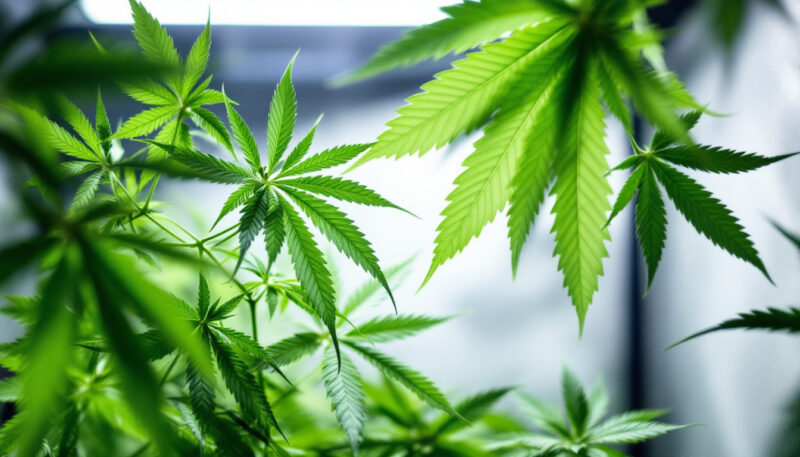
The type of light isn’t everything; spectrum, color temperature, lumens, and wattage are equally important. For vegetative stage, focus on lights with a cooler spectrum, around 4000K to 6500K. These lights emit more blue wavelengths, which help promote strong, bushy growth. Blue light encourages compact, sturdy plants rather than tall, stretched-out ones. Never use orange or red light during the vegetative stage because they are for the flowering stage. You also want to pay attention to lumens, which measure light output. Aim for at least 2,500 lumens per square foot of grow space to support healthy vegetative growth. The higher the lumens, the better the light penetrates the canopy. In terms of wattage, this will depend on your setup. 400–600 watts is common for mid-sized grows, while smaller setups can get away with 250 watts. Keep in mind that higher wattage equals more heat, so adjust your distance between the plants and lights accordingly.
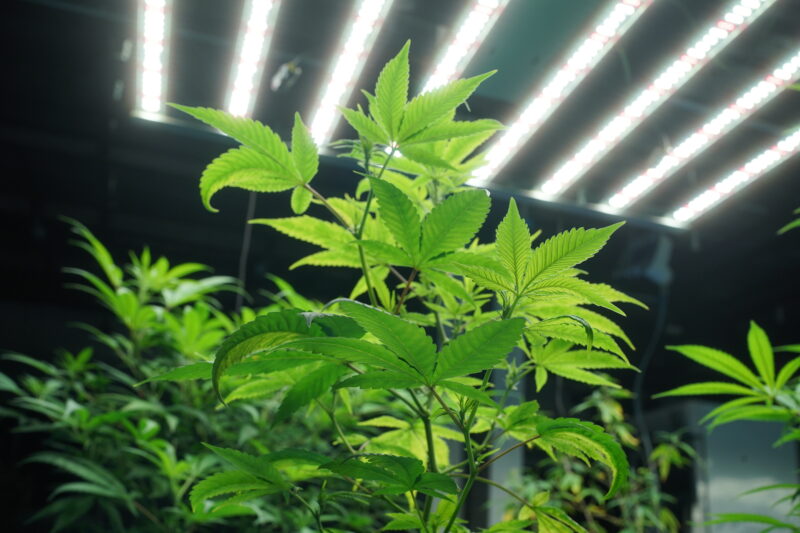
Regarding light height, you’ll want to start around 18–24 inches above the canopy for HID or LED lights, then adjust as the plants grow. You can go closer to 6–12 inches for CFLs because they don’t generate as much heat. Watch your plants closely and adjust the light distance based on their reactions. If the plants stretch too much, the light is too far away. If they show signs of heat stress like curled or burnt leaves, move the lights higher.
Managing light properly means constantly monitoring how your plants respond. If you see them stretching, they’re not getting enough light and are trying to reach for it. On the flip side, if the leaves start to curl or show burn marks, the lights are too close and need to be raised. The goal is to find that sweet spot where the light intensity is optimal for growth without causing stress.

Note: Your goal is to provide intense, blue-spectrum light during vegetative growth to maximize photosynthesis and support strong, stocky plants. Whether you go with HID, CFL, or LED, the key is managing intensity, distance, and spectrum to give your plants the best possible start. As your plants grow, keep adjusting the light height and monitor their reaction—this is a process of fine-tuning that ensures healthy development through the vegetative stage.
Nutrients and pH Management During Vegetative Stage
During the vegetative phase, your plants will demand more nutrients, especially nitrogen. Nitrogen drives the development of stems, leaves, and roots—everything green that will support the plant later in flowering. A common nutrient solution for this phase is something balanced like a 20-20-20 fertilizer with trace elements, whether you’re growing in soil or hydroponically. As the plant expands, secondary nutrients like magnesium, calcium, and sulfur will also be needed.These elements are crucial for photosynthesis and overall plant metabolism. Many growers add Epsom salts (for magnesium and sulfur) to their watering routine to prevent deficiencies that can slow growth.
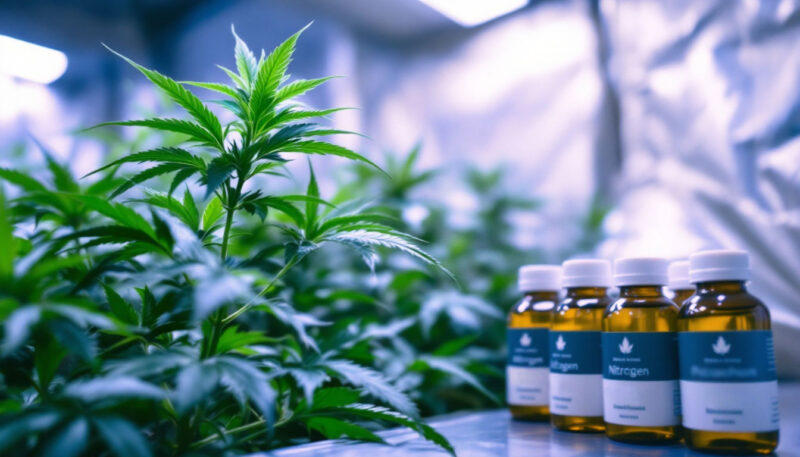
While nutrients are essential, they’re useless if your pH is off. If the pH is too high or too low, your plants won’t be able to absorb the nutrients properly, leading to deficiencies even when everything else seems right. In soil, aim for a pH range of 6.0–7.0, and for hydroponics, keep it tighter at 5.5–6.5. Always test the pH of your water or nutrient solution before feeding your plants. Adjust the pH with “pH up” or “pH down” solutions if it is out of range. An imbalanced pH can lock out nutrients and cripple your plants, stunting their growth or causing yellowing and weak stems.
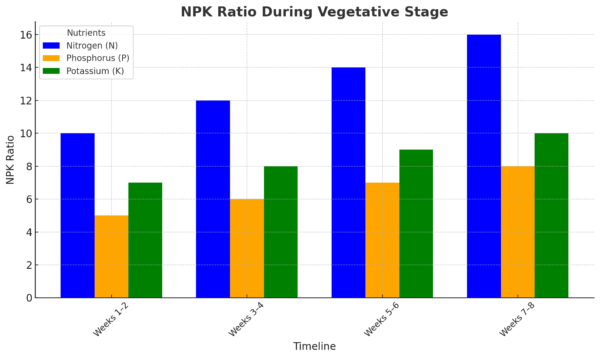
Nutrient requirements can vary between strains, so keep an eye on how your plants react. Sativa-dominant strains tend to need less fertilizer compared to their indica counterparts. Indicas, being more robust, can often tolerate higher nutrient levels, but even they can suffer from overfertilization if you’re not careful. Learn your strain’s nutrient tolerance by starting with lower doses and increasing as needed.
Photosynthesis and Plant Development
During vegetative growth, photosynthesis works overtime to drive your plant’s rapid expansion. The leaves take in CO2 from the air, water, and light, converting it into carbohydrate energy and oxygen through the chlorophyll in the leaves. For this process to be efficient, you need to keep the leaves clean and free of dust or buildup that could block the stomata—the tiny pores on the underside of the leaves. These stomata regulate moisture levels and allow oxygen and water vapor to flow out of the plant. Proper airflow around your plants also helps keep these pores functioning properly, ensuring maximum photosynthesis and growth.
In this phase, the plant’s root system also strengthens and expands. A healthy root system is very important to absorb nutrients and water efficiently, which in turn supports strong stem and branch growth. This is when your plants really start to look like cannabis plants—thicker stems, broader leaves, and more branching.
Pre-Flowering
Cannabis is a dioecious plant, meaning it’s either male (producing pollen) or female (producing seeds and buds). However, hermaphrodites can develop both male and female flowers, often due to stress or genetics. This is something you avoid because hermaphrodites can pollinate your female plants, leading to seed production and reducing bud quality. Our main goal is to grow sinsemilla buds, which are seedless female flowers. These buds are highly valued because the plant channels all its energy into producing THC-rich, resinous flowers instead of seeds, producing more potent, high-quality buds. This enhances potency and improves the smoke quality, making a smoother, more enjoyable experience.
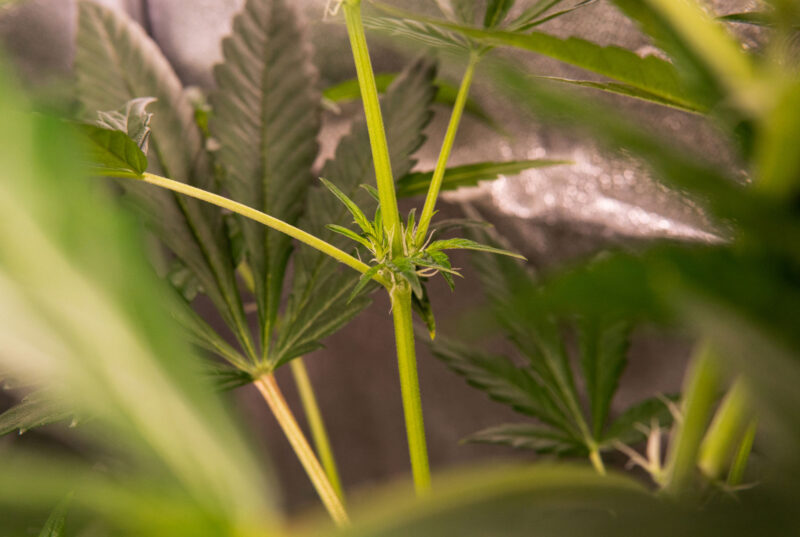
During the pre-flowering stage, your plant will begin to show its sex, and this is the critical time to spot and remove males or hermaphrodites to ensure an all-female crop of sinsemilla. Pre-flowers emerge at the branch internodes, where the branch meets the main stem, usually about six to eight weeks into vegetative growth, around the fourth to fifth internode. This is a crucial point in the plant’s life cycle because identifying the plant’s sex now allows you to either keep your females or remove males and any hermaphrodites before they can pollinate the crop.
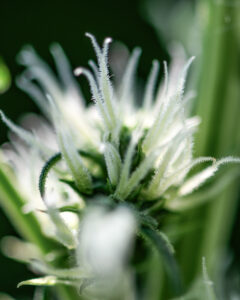
While pre-flowers are often visible to the naked eye, using a 10x to 30x magnifier will help you see them more clearly and determine the plant’s sex. Pre-flowers typically appear earlier in plants grown under an 18/6 day/night light cycle than those under a 24-hour light cycle. Once you’ve identified the sex, you’re ready to move forward with flowering, which requires switching to a 12/12 light cycle—12 hours of uninterrupted darkness and 12 hours of light.
Male Pre-Flowering
Male plants usually reveal themselves around six to eight weeks into growth, with pre-flowers appearing at the fourth or fifth internode. These male pre-flowers look like small ball-shaped structures, which will eventually turn into pollen sacs. If not removed early, these sacs will burst and pollinate any nearby females, ruining your sinsemilla crop. Remove male plants as soon as you confirm their sex to prevent accidental pollination.

Female Pre-Flowering
Female pre-flowers appear as tiny calyxes with white pistils sticking out. These pistils are the key indicators that you have a female plant, and this is the plant you want to keep. Female pre-flowers typically show up after six to eight weeks of growth and are a clear sign that the plant is ready to transition into the flowering phase.
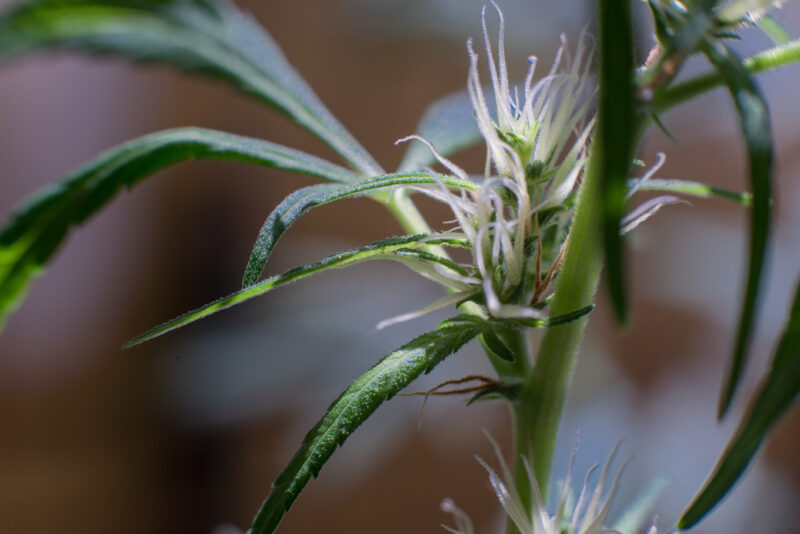
Pre-flowering occurs regardless of the light cycle—it’s a natural sign of sexual maturity. However, once you’ve confirmed that your plant is female, you can switch to a 12/12 light cycle to initiate full flowering.
Intersex or Hermaphrodite Flowers
Intersex or hermaphrodite plants are a major concern during the pre-flowering and flowering stages. These plants develop both male and female reproductive organs, often due to environmental stressors like light leaks during the dark cycle, nutrient issues, or irregular watering. When a hermaphrodite forms male pollen sacs alongside female flowers, it can pollinate itself or other females in the grow room. This leads to seed production, which detracts from the quality and potency of your buds.
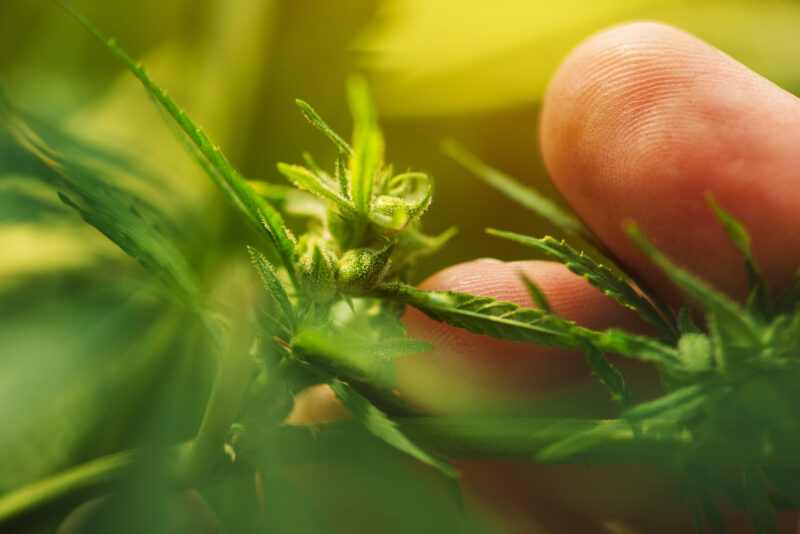
To avoid this, monitor your plants closely for any signs of intersex traits, especially if they’ve been stressed. Hermaphrodites should be removed immediately to protect the rest of your crop. Identifying and eliminating these plants early will prevent seed formation and keep your buds focused on resin production.
Time to Start Flowering?
After your plants have shown pre-flowers, the big decision comes: Should you begin flowering now or let the plant keep growing in the vegetative stage? It’s a critical choice, as the timing of flowering directly impacts the size and yield of your plants. However, it’s important to note that the amount of bud your plants produce isn’t necessarily tied to how big they are at the time of flowering. The number of nodes, the growing environment, and the strain’s genetic potential all play bigger roles in determining bud production.
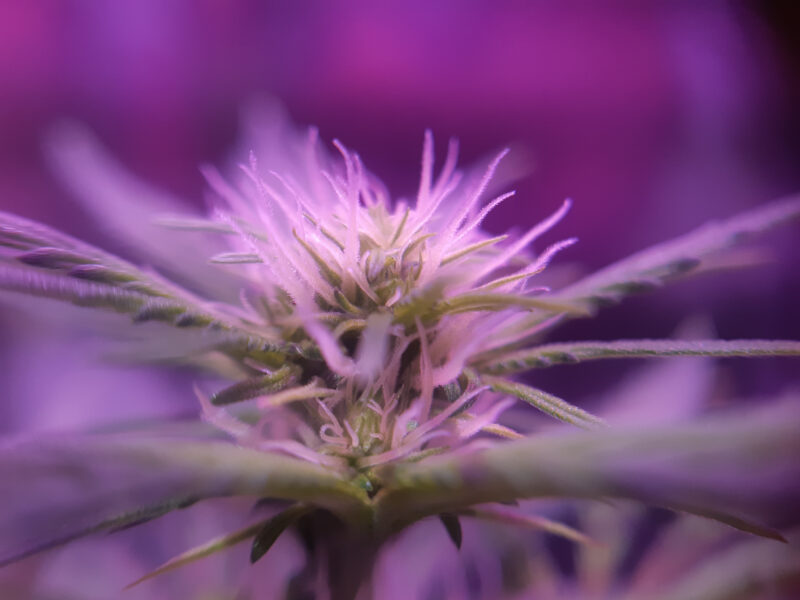
You can successfully get good yields from smaller plants if they’re healthy and well-cared for. Bud quality won’t suffer just because the plant is shorter. On the other hand, bigger plants don’t automatically translate to better buds. The key is how well the plant was grown and the conditions it’s in during flowering.
If you choose to flower early, remember that sativa-dominant strains can double or even triple in size during the flowering stage. This stretch needs to be considered, especially if you’re working with limited space. Flowering smaller plants can help keep them more manageable indoors, allowing for faster turnover of crops and potentially more harvests per year.
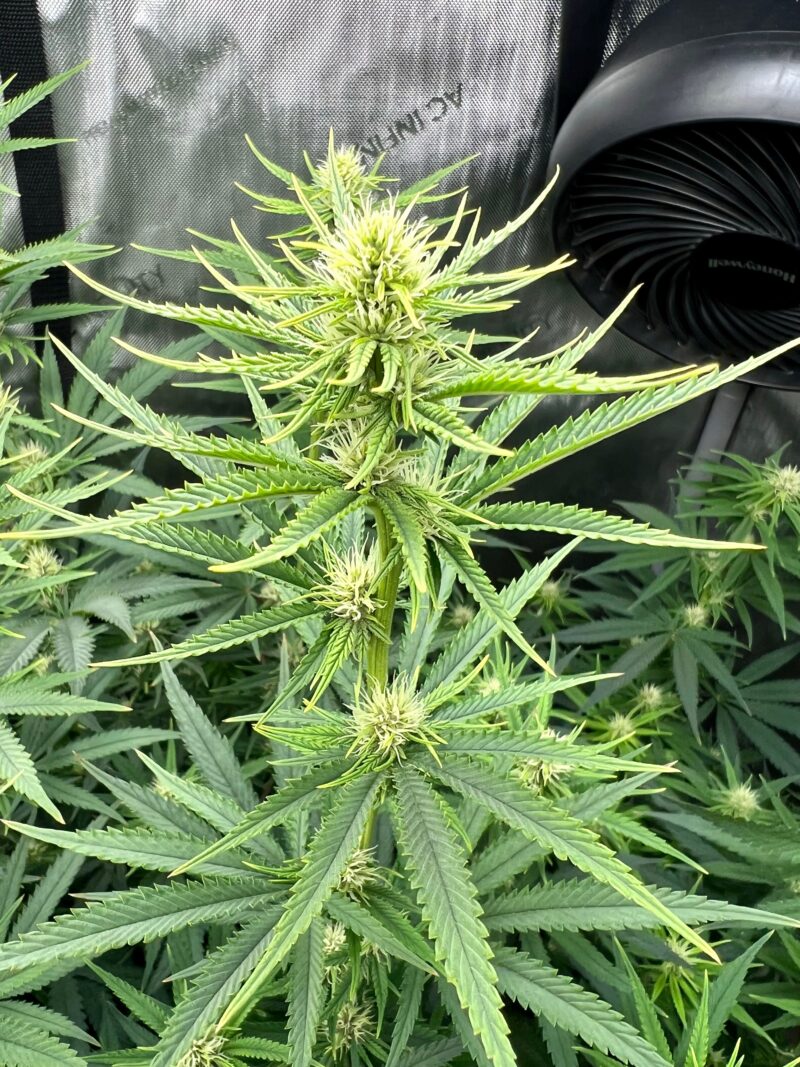
Alternatively, if you’re aiming for a larger yield, you can keep your plants in the vegetative stage until they reach your desired height. A good sign that a plant is ready for flowering is when it begins to develop alternating nodes—this indicates that it’s fully mature. This usually happens for plants grown from seed after several weeks of vegetative growth, while clones taken from mature plants can be flowered as soon as they’ve rooted.
Making the Decision
Finally, deciding to switch to flowering depends on how large you want your plant to be at harvest. If space is an issue, you can start flowering when your plants are as small as six inches tall with at least four sets of leaves. This typically takes two to four weeks in most hydroponic setups.
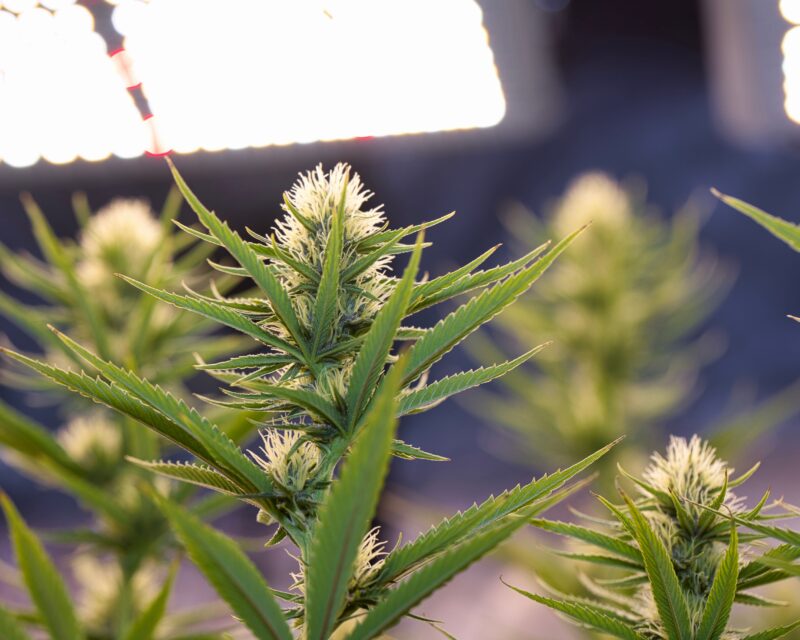
For growers who want to maximize yields, extending the vegetative phase allows the plant to grow larger and develop more bud sites. However, keep in mind that sativa-dominant strains will stretch significantly, sometimes growing two to three times their vegetative height, so you’ll need to make sure your grow space can accommodate their full size.
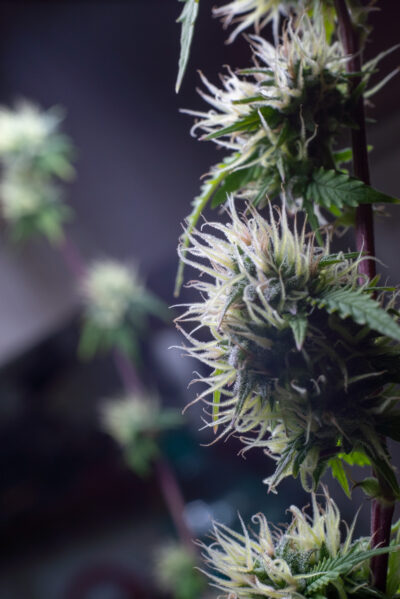
Once you decide, remember that during the flowering phase, the plant shifts its energy to bud production, and the faster you manage this transition, the sooner you’ll be harvesting. Healthy pre-flowering management sets the stage for a successful harvest.
Flowering: The Final Stage
The flowering stage is where cannabis transitions from vegetative growth into full bud production. During this phase, the plant redirects its energy from height and leaf production to bud formation. You’ll notice a significant reduction in vertical growth as the plant focuses on developing THC-rich buds. This is normal—your plant is now concentrating on producing the potent, resin-covered buds you’ve been working toward.
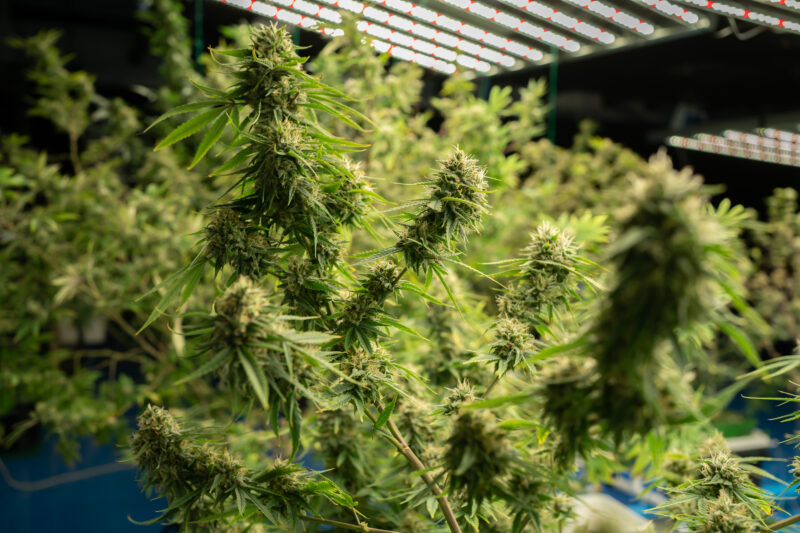
In the first two to four weeks of flowering, plants may continue to stretch, especially if they are sativa-dominant. After this period, the plant’s energy shifts entirely to flower production. Indica-dominant strains typically flower faster and produce dense, compact buds, while sativas take longer but reward growers with larger colas. As flowering progresses, the growth of new shoots and leaves slows, and the plant redirects everything toward bud development and resin production.
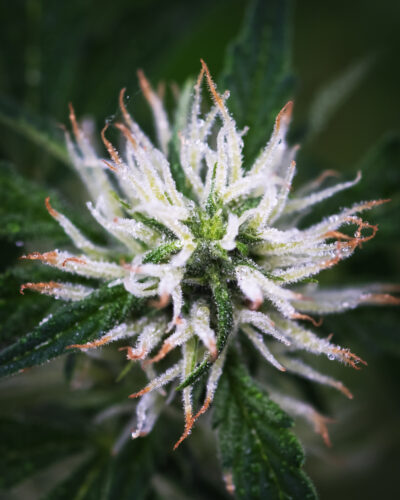
As your plant flowers, the pistils (white hairs) will begin to change color, transitioning from white to orange, red, or brown, depending on the strain. This is a clear sign that your plant is nearing maturity. While each strain has its own flowering time, indicas usually take around 6–8 weeks, and sativas may take up to 10–12 weeks or more. Keep a close eye on your plants, as flowering times can vary even within the same strain.
What is Sinsemilla?
The goal during flowering is to produce sinsemilla buds—unpollinated female flowers that remain seedless. The term sinsemilla comes from the Spanish words “sin” (without) and “semilla” (seed). Unpollinated female plants will continue to flower longer and concentrate their energy on producing THC-rich, resin-coated buds rather than seeds.
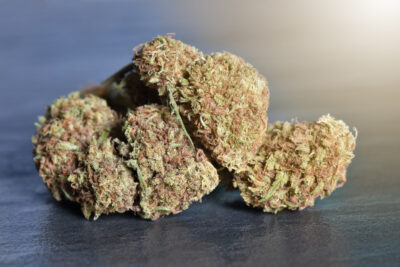
Sinsemilla buds are highly valued for their potency and smooth smoke. Because the plant isn’t focused on seed production, it puts all its energy into producing more resin and cannabinoids, resulting in superior-quality buds. Sinsemilla buds are also richer in terpenes, which enhance the flavor and aroma. To ensure your crop remains sinsemilla, remove all male plants early in the pre-flowering stage and stay vigilant for hermaphrodites, which can release pollen and compromise your seedless harvest.
Growing sinsemilla offers one of the most significant advantages: improved smoke quality. Seeded buds tend to produce a harsher smoke, while sinsemilla buds offer a smoother, more flavorful experience. Maintaining a sinsemilla crop also results in higher THC content, making the buds ideal for both recreational and medicinal use.
Feeding During Flowering
As your plants enter the flowering stage, their nutrient needs shift considerably. During the vegetative stage, cannabis relies on high levels of nitrogen to support leafy growth, but in the flowering phase, the plant’s focus turns to phosphorus (P) and potassium (K) to develop buds. It’s essential to switch to a bloom fertilizer with a lower nitrogen ratio and higher phosphorus and potassium content. A common ratio for flowering is 5-50-17 or 10-20-10.
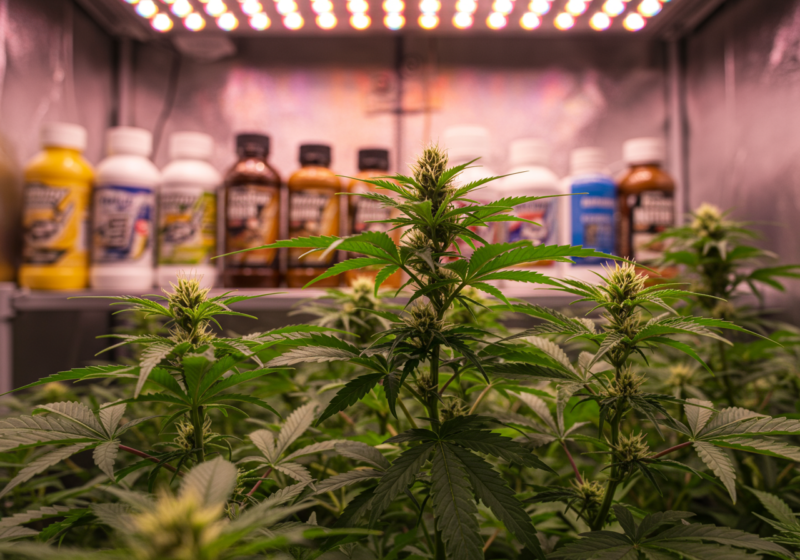
During the early weeks of flowering, continue feeding your plants with every watering to ensure they have enough nutrients to support bud formation. However, as your plants approach the final weeks of flowering, gradually reduce nutrient strength to prevent nutrient lockout or burn. Overfeeding in the later stages can lead to salt buildup, which negatively affects both the health of the plant and the taste of the buds. Reducing the nutrients to quarter strength toward the end of flowering will help your plants finish strong without stress.
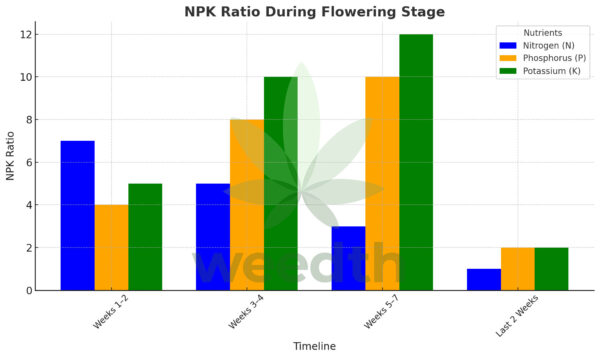
Phosphorus is crucial for flower formation, helping the buds grow larger and denser, while potassium ensures the plant has the strength to support the heavy buds as they develop. Keep an eye out for signs of deficiency—if the older leaves begin to turn yellow or purple, this is often a sign that the plant is naturally redirecting nutrients from the lower foliage to support the developing buds. However, if newer leaves begin to yellow or curl, this could indicate a nutrient imbalance.
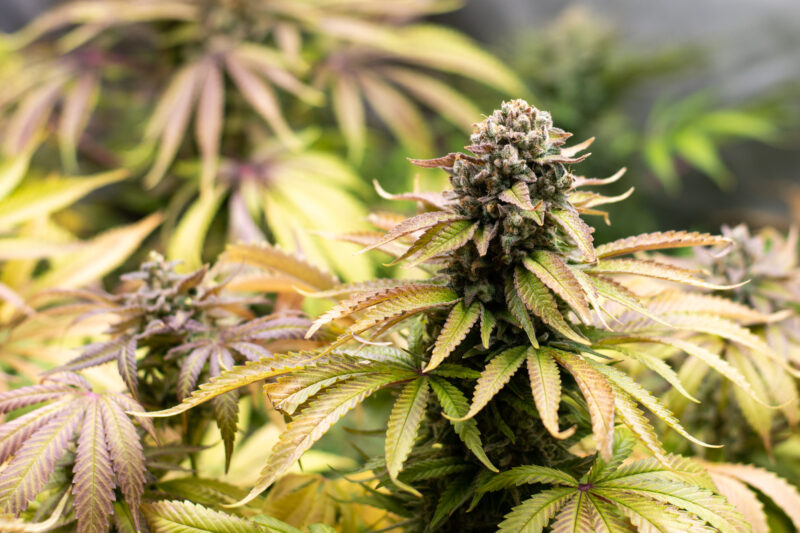
Warning: Never spray your plants with bug spray during flowering. If you do, harmful chemicals will end up in your buds, and when smoked, they can seriously poison you. The residue from pesticides can make the buds toxic, leading to severe health risks. Always avoid spraying anything on your plants during this crucial phase.
Supplement Advice for Flowering
To enhance both yield and bud quality, many growers use additional supplements during the flowering phase. Here are a few supplements to consider for boosting the health of your plants and improving bud production:
- Sugar Supplements: Additives like molasses feed beneficial microbes in the soil, promoting healthier roots and better nutrient absorption. Sugar-based supplements improve the microbial life in organic soils but should be stopped during the final flush period to avoid affecting the taste of the buds.
- Calcium and Magnesium (Cal/Mag) Supplements: Cal/Mag is crucial during flowering to prevent deficiencies that can hinder bud development. Calcium strengthens cell walls, while magnesium is essential for chlorophyll production and energy transfer within the plant. Cal/Mag should be used throughout flowering to maintain healthy plant growth and dense bud formation.
- Amino Acids and Enzyme Supplements: These supplements aid nutrient uptake and improve the plant’s overall health. They help break down organic material in the soil, making it easier for the plant to absorb the nutrients it needs during flowering.
- Terpene Enhancers: Terpene-boosting supplements encourage the plant to produce higher levels of terpenes, the compounds responsible for the aroma and flavor of your buds. This results in more aromatic and flavorful buds essential for producing top-quality cannabis.
- Hormone Supplements: Products containing natural plant hormones, such as kelp or algae extracts, can stimulate more flowering sites, increasing overall bud production. These supplements can be particularly beneficial for larger grows where maximizing yield is important.
- Bud Boosters: Specialized bud boosters are designed to increase bud density and resin production. These supplements are typically used in the later stages of flowering to help bulk up the buds and improve resin content. Use them carefully to avoid overfeeding your plants.
Bud Taste
Bud flavor affects the quality of your cannabis. Whether your buds are smoked, vaped, or used in edibles, improving the taste enhances the entire experience. Here are some strategies to improve bud taste during the flowering phase:
- Flush Before Harvest: Flushing your plants with clean water during the last 1–2 weeks of flowering is crucial for improving flavor. Flushing removes excess nutrients and salts from the growing medium, ensuring they don’t leave a harsh, chemical taste in the final product. If you skip flushing, your buds may have a less desirable flavor when consumed.
- Organic Nutrients: Using organic fertilizers like bat guano, compost tea, or fish emulsion during flowering can improve the natural flavors of your buds. Organic nutrients encourage the production of terpenes, which contribute to the aroma and flavor of cannabis. More terpenes mean more flavorful buds.
- Temperature Control: Keeping the grow room temperature in check, especially during the last few weeks of flowering, helps preserve terpenes, which degrade at higher temperatures. Aim for daytime temperatures of 70–75°F (21–24°C) and slightly cooler temperatures at night to enhance flavor.
By paying attention to these details, you’ll not only increase the quality of your buds but also enhance their flavor for smoking or consumption in edibles.
Lighting for Flowering: 12/12 Light Cycle
In nature, cannabis flowers when the days grow shorter and the nights become longer. Indoors, we simulate this by switching the light cycle to 12 hours of uninterrupted darkness and 12 hours of light. This shorter day length signals the plant to begin flowering and producing buds.
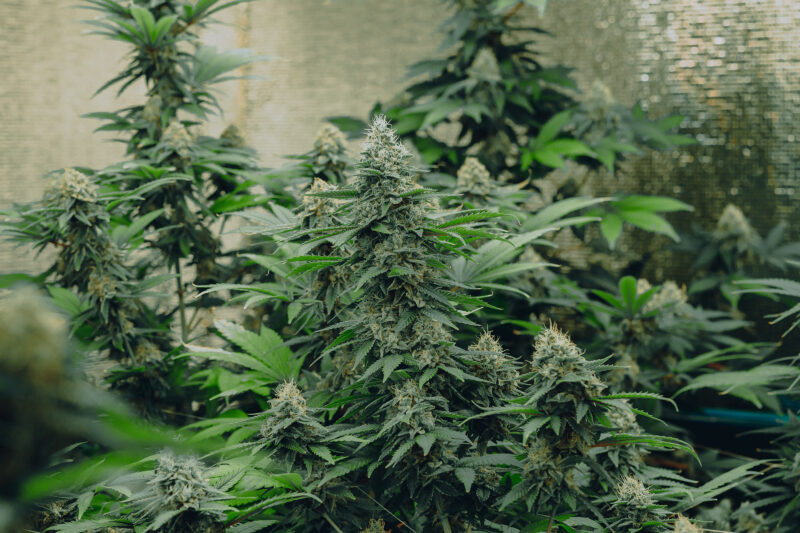
The 12/12 light cycle is essential for triggering flowering. Any interruptions during the dark period can cause the plant to revert to vegetative growth or develop hermaphroditism. Maintaining a completely lightproof grow room is critical during this phase. Even small light leaks from LEDs, cracks, or nearby light sources can disrupt the plant’s hormonal balance and delay flowering. If you need to enter the grow room during the dark cycle, use a green light, as cannabis plants do not react to this wavelength.
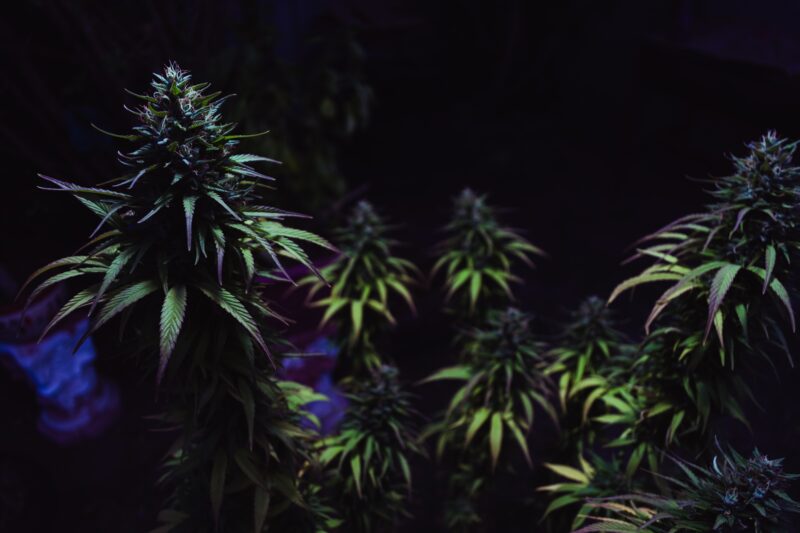
Some growers experiment with adjusting the light cycle, such as using 13 hours of light and 11 hours of darkness to increase flower size. However, this can interfere with the plant’s flowering process if not done carefully. In the final weeks of flowering, some growers extend the dark period to 14–18 hours to speed up ripening, but this can reduce overall yield if done for too long.
Spectrum and Light Color for Flowering
The spectrum and color temperature of your lights are critical for flowering. During the vegetative stage, plants thrive in the blue spectrum, but during flowering, they need more of the red spectrum (around 2700K to 3000K) to encourage bud production.
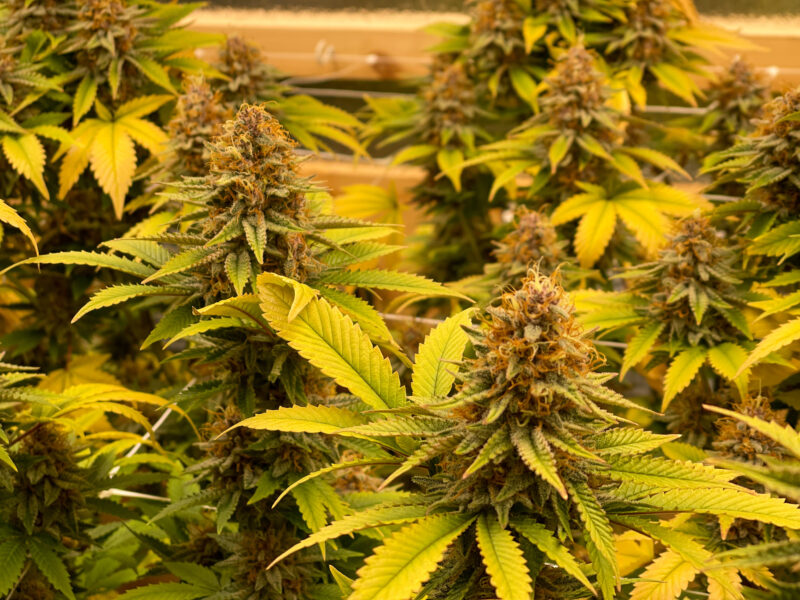
If you’re using HID lights, it’s important to switch from metal halide (MH), which is used for vegetative growth, to high-pressure sodium (HPS) lights during flowering. HPS lights emit more red light, which promotes flowering and helps plants produce larger, resinous buds.
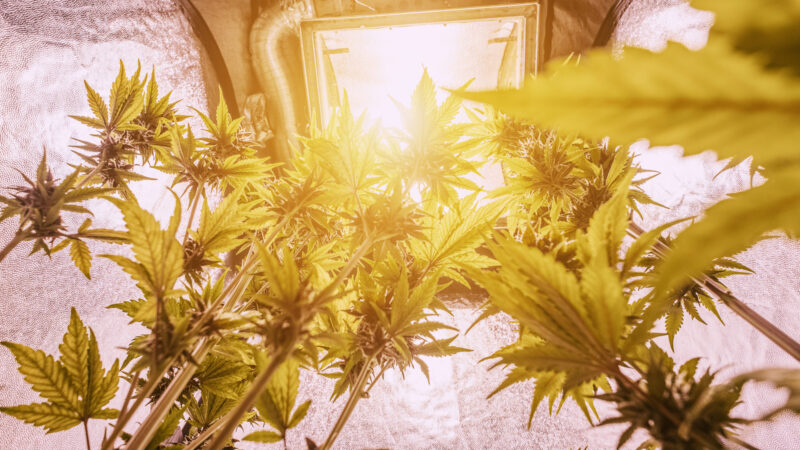
LED or CFL growers, if you’re using white or blue daylight lights from the vegetative stage, now is the time to switch to red or orange lights in the 2700K–3000K color temperature range to promote flowering. If your LED grow light has a vegetative and flowering mode, don’t forget to switch to the flowering mode at this stage to ensure the plant receives the correct spectrum for bud development.
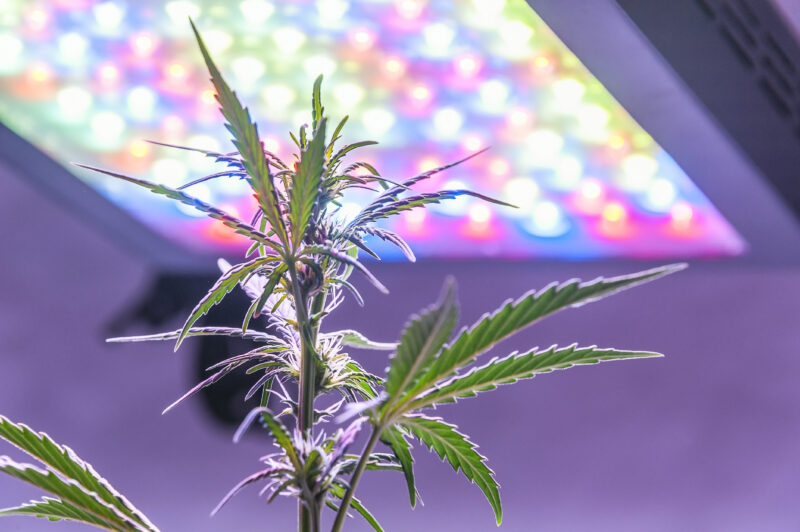
Light intensity is also crucial. Keep your lights at the correct distance from the canopy to avoid light burn while ensuring that all bud sites receive adequate light. As your plants grow, adjust the lights accordingly to maximize bud development without causing stress.
Importance of Complete Darkness
Complete darkness during the 12-hour dark cycle is critical in the flowering stage. Cannabis plants rely on the dark period to produce florigen, the hormone responsible for triggering and maintaining flowering. Exposure to light during the dark cycle disrupts this process and triggers the production of antiflorigen, which can cause the plant to revert to vegetative growth or develop hermaphroditic traits.
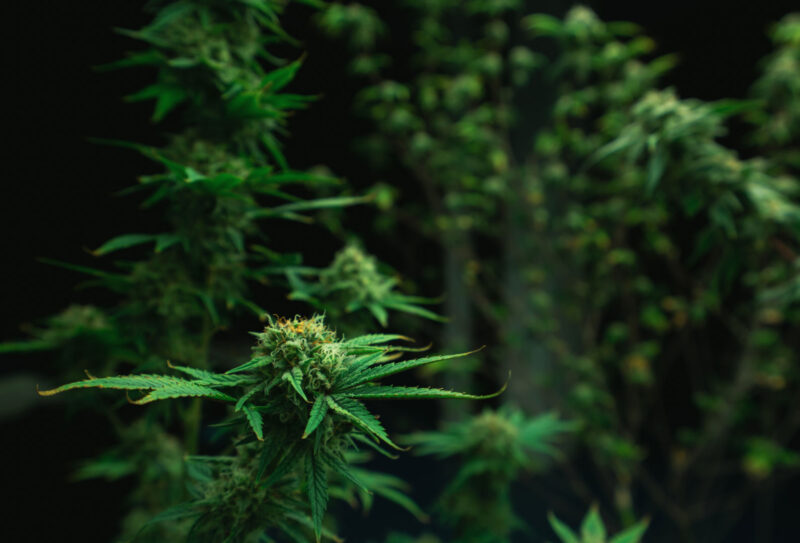
Make sure your grow room is completely sealed and lightproof to avoid this. Even minor light leaks from LEDs or small gaps can interfere with the plant’s flowering cycle.
Note: If you must enter the grow room during the dark period, use a green light, which won’t disrupt the plant’s photoreceptors. However, it’s best to avoid disturbing your plants during the dark cycle unless absolutely necessary.
Quick Flowering
If you need to speed up the flowering process, there are ways to shorten the cycle, though they come with some trade-offs. Reducing the light cycle to 14 hours of light and 10 hours of darkness can help your plants flower more quickly, but it may reduce the overall size of the buds, as the plant has less time to develop.
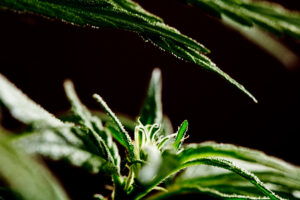
Another option is to increase the dark period to 18 hours of darkness and 6 hours of light during the final weeks of flowering. This can push the plant to ripen faster but may result in lower yields. Use these techniques carefully, as rushing the flowering phase can impact both the size and quality of your final harvest.
Flowering Timeline
Each strain has a unique flowering timeline, but the general process remains the same. Here’s what to expect:
- Weeks 1–2: The plant will stretch significantly as it transitions into flowering. You’ll see the first signs of flower formation at the internodes.
- Weeks 3–4: Buds begin to develop more noticeably, though they may appear light and airy at first. The plant continues to stretch while focusing on creating new flower sites.
- Weeks 5–7: The plant shifts all its energy to bud production, and the buds will swell significantly. You may notice yellowing leaves as the plant pulls nutrients from older foliage to support flower development. This is normal—there’s no need to remove leaves unless they turn brown and die.
- Last 2 Weeks: In the final two weeks, stop feeding nutrients and flush your plants with clean water to remove any residual fertilizer salts. This will enhance the flavor and smoothness of your final product.
- Final 72 Hours: Many growers choose to turn off the lights completely for the last 24–48 hours before harvest. Since THC is light-sensitive, keeping the plants in darkness helps preserve potency and improve flavor. The plant also uses up any remaining sugars during this period, resulting in a cleaner smoke.
Improving Bud Quality
If you want to produce quality buds, you’ll need to pay close attention to several key factors, including nutrient management, lighting, and environmental control. Here are a few tips to ensure your buds develop to their full potential:
- Lower Humidity: Reduce the humidity in the grow room to around 40–50% during the flowering stage. High humidity can promote mold and mildew, especially as buds grow denser. A dehumidifier can help maintain the right moisture levels, ensuring your buds remain healthy and free from rot.
- Increase Airflow: Proper airflow is essential during flowering. It helps prevent mold and strengthens the branches to support the weight of the growing buds. Oscillating fans are ideal for keeping air moving evenly around the plants.
- Boost Light Intensity: Ensure your plants are receiving adequate light to support bud development. Whether you’re using HID, LED, or CFL lights, make sure the intensity is strong enough to penetrate the canopy and reach all bud sites. The better the light distribution, the denser and more resinous your buds will be.
Harvesting
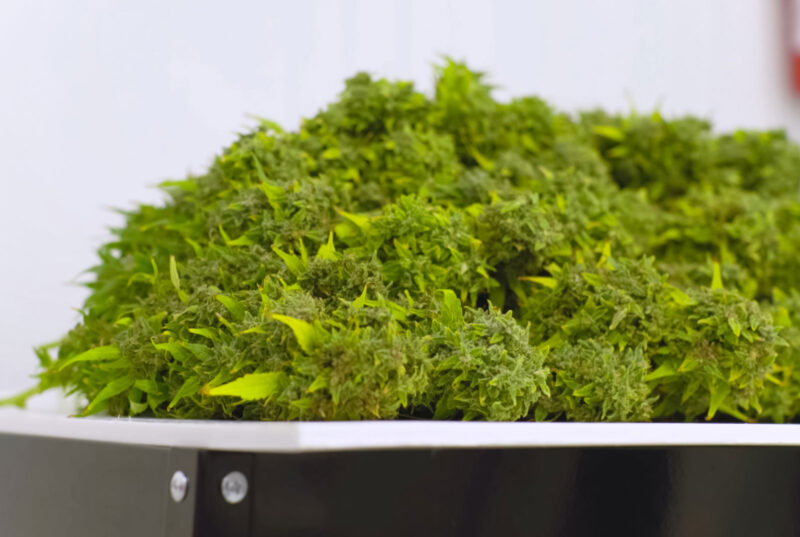
We did it! A big harvest is the best reward for all the hard work, research, and risks you took while growing your garden—not to mention the long and patient wait. A well-executed harvest is crucial to ensuring the best quality cannabis.
When to Harvest
Timing is everything. Harvesting at just the right moment will maximize bud growth and THC production. After a certain point, THC begins to degrade, which means lost potency and diminished quality.
Several factors come into play when deciding the perfect time to harvest your crop. These include differences between indoor and outdoor plants, the unique flowering times of Sativas and Indicas, and whether you prefer an early or late harvest depending on the desired effects—whether a head high or body high. Additionally, the ripeness of the plant is determined by its chemical state at harvest, directly impacting the final product.
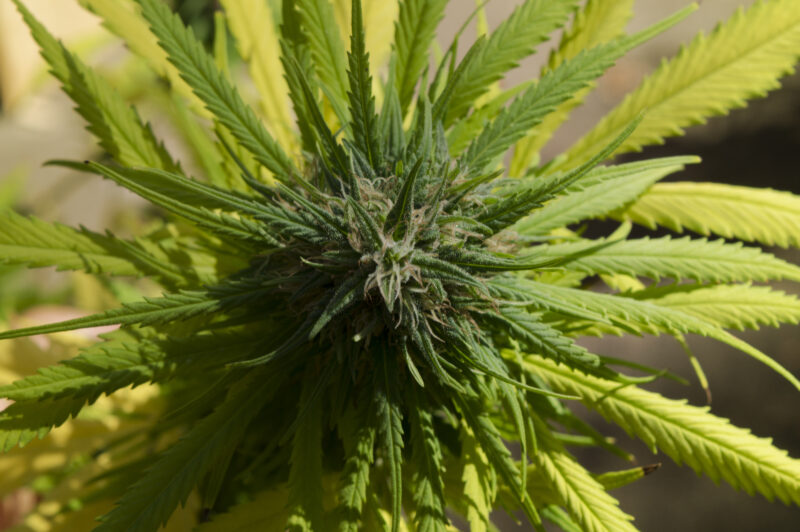
Many growers believe harvest timing can be a matter of personal preference. When the glandular trichomes are clear with minimal coloration, THC levels are at their peak, while CBD and CBN are still low, minimizing their sedative effects. On the other hand, some growers prefer a more sedative effect, allowing the resin glands to turn cloudy and even amber, which enhances the overall cannabinoid content. The maturation of trichomes doesn’t happen all at once; they develop and mature at different times. Finding the right balance for harvesting depends on the grower’s preference for effect and overall flavor profile.
Knowing when to harvest your indoor cannabis plants is crucial for achieving the best potency and yield. For most Indica strains grown indoors, it takes about eight weeks from switching to a 12/12 light cycle for the plants to fully mature. During this time, your plants will reach their peak THC levels, and waiting too long can lead to a breakdown in potency.
Sativas generally take longer to mature, sometimes up to thirteen weeks indoors. By paying close attention to your plants’ development and understanding the timing for each strain, you can ensure a successful and potent harvest.
Choosing Your High: Head or Body?
One of the key decisions when harvesting cannabis is the type of high you’re aiming for—whether it’s a cerebral, head-focused high or a deep, relaxing body high. A head high often creates an uplifting, sometimes psychedelic experience, influencing mood and creativity. On the other hand, a body high leans more toward a sedative, “couch-lock” effect, often used for relaxation or pain relief.

In general, Sativa strains and early harvests will deliver more of that energetic, mind-bending head high, perfect for those looking to boost their mental state. Indicas, especially when harvested later, tend to provide a heavier body high, ideal for those who want deep relaxation.
For those who want a blend of both effects, experimenting with late-harvested Sativas or early-to-mid harvested Indicas is a great way to find that sweet spot—a balanced high that offers both mental clarity and physical calm.
Trichomes: The Key to Timing Your Harvest
When it comes to the quality of your cannabis and the type of high it produces, the trichomes play a significant role. These tiny, resin-filled glands are where the magic happens. Found along the surfaces of the flowers (calyxes), bracts, leaves, and stems, trichomes begin developing around the fourth week of flowering. As your plant matures, more trichomes appear, and their density directly affects the potency of your final product.
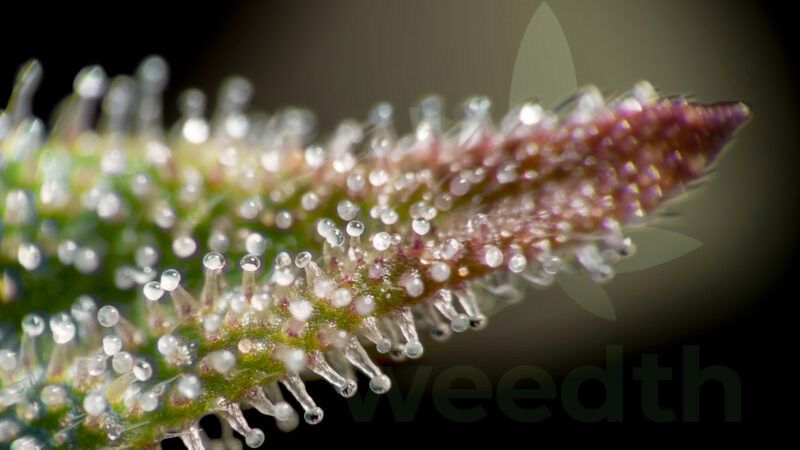
Monitoring the maturity of the trichomes is the most reliable way to determine the right time to harvest. These stalked trichomes have a bulbous head at the Tip, and this part reveals the plant’s maturity. In the early stages, the trichome heads will be clear, indicating that THC levels are still developing. Over time, the heads will turn cloudy, and eventually amber. The ratio of cloudy to amber trichomes gives you an idea of the kind of high you can expect.
Cloudy trichomes tend to produce a more uplifting, mental high, while amber trichomes deliver a heavier, body-focused stone. Professional growers often recommend harvesting when about 30-50% of the trichomes have turned amber, but it’s generally agreed not to go beyond 75% amber.
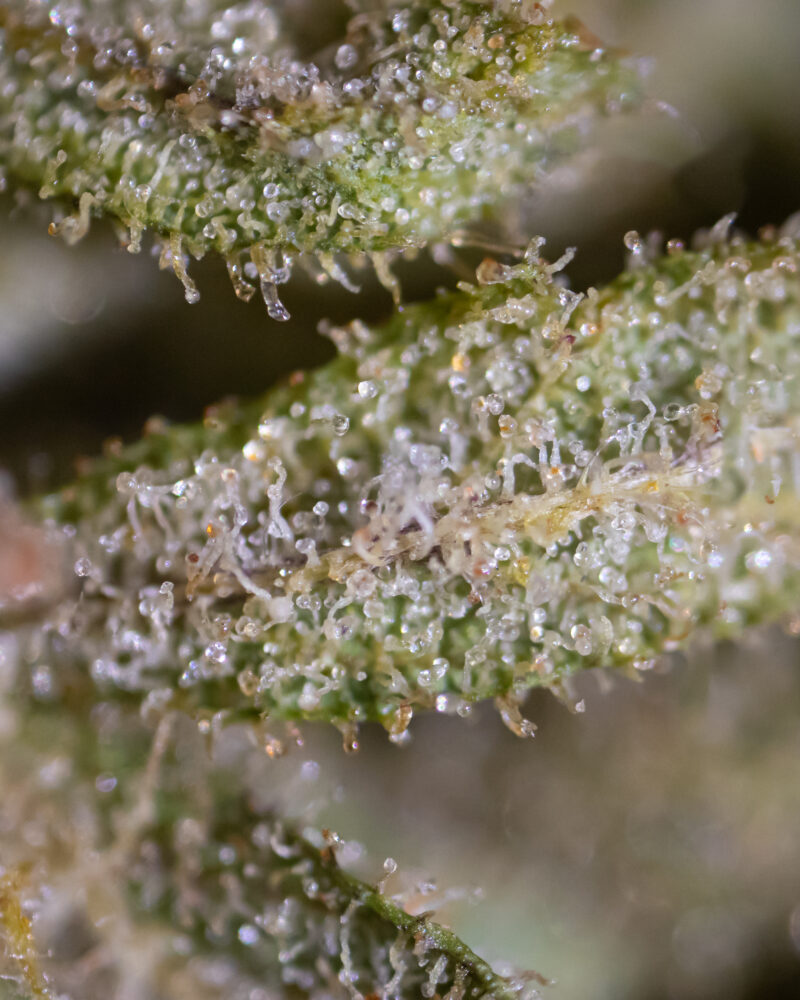
Initially, trichomes start out clear, then turn milky, and finally amber or light brown. This amber stage is what gives mature buds that “red hair” appearance, as the gland holding the THC swells, making the trichome look like a tiny mushroom.
For first-time growers unsure of when to harvest, a general guideline is to wait until 50-80% of the white pistils (hairs) have turned dark—usually brown or red—and around 50% of the trichomes have started to turn amber.
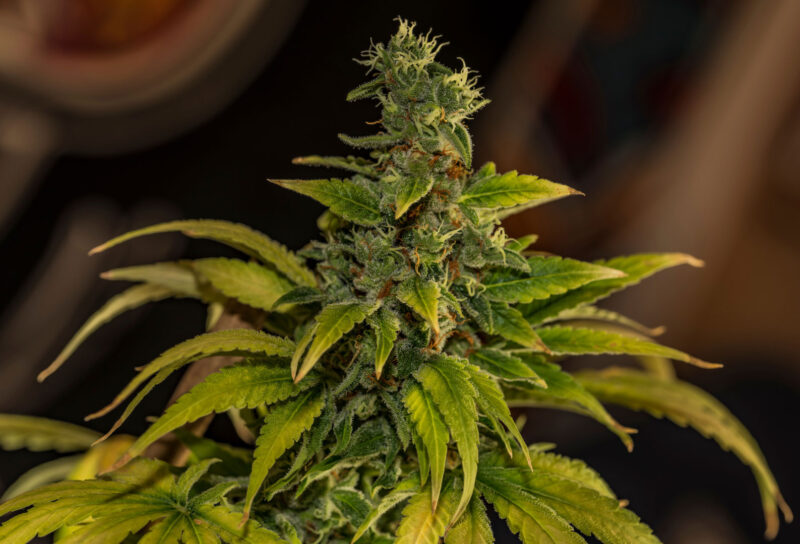
Warning: Almost all cannabis strains will show trichomes that change color, but some growers report encountering strains where the trichomes do not follow this pattern. Keep an eye on your plant’s overall health and condition to gauge readiness.
Trichome Development Stages:
- A few weeks in: Trichomes begin turning a milky color.
- A couple more weeks: Most trichomes will be fully milky.
- Later stages of flowering: Trichomes turn amber or light brown.
The amount of time required to reach these stages depends on the strain and growing conditions.
Other Signs of Harvest Readiness:
- Your plant stops producing new crystals.
- Resin production ceases.
- Fan leaves and lower leaves turn yellow and begin to drop off.
- The smell reaches its peak.
- Bud mass stops increasing.
Indoor Harvest Timeline:
For indoor growers, most cannabis strains will be ready for harvest within 7-12 weeks after starting the 12/12 light cycle (12 hours of light, 12 hours of darkness). Indica-dominant strains usually mature within 7-9 weeks, while Sativa-dominant strains can take up to 12 weeks to reach full maturity.
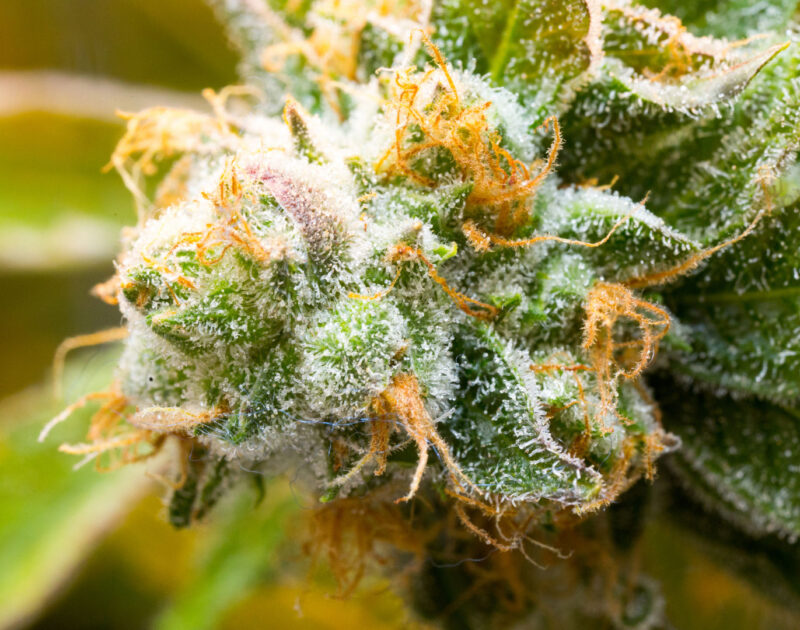
By the third stage of floral maturity, with fully formed trichomes, you can assume most strains have reached their final weight.
Guidelines for Trichome Harvesting:
- Clear Trichomes: These give a cleaner, more energetic high with less sedative effect. This window is best for heavy Indica strains.
- Cloudy or Milky Trichomes: This is typically the ideal time to harvest most hybrid strains. The high is balanced, offering both mental and physical effects.
- Amber Trichomes: When 30% or more of the trichomes have turned amber, this is ideal for late-maturing Sativa strains. This is also the best window if you plan on using the plant for hash production.
Viewing Trichomes
Examine trichomes accurately then you’ll need a magnifying tool. A handheld illuminated magnifier or pocket microscope with at least 60x magnification is ideal. These tools allow you to closely monitor trichome development, helping you time your harvest perfectly.
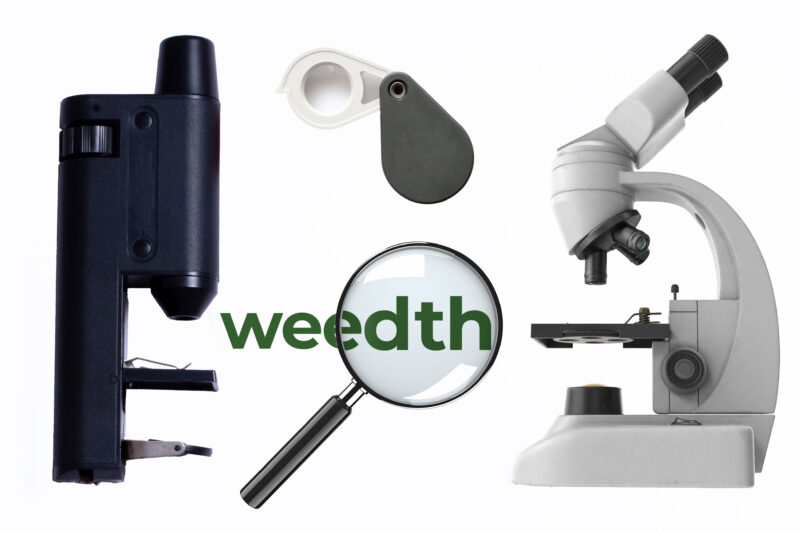
A magnification tool like this gives you a detailed view of how trichomes transition from clear to cloudy to amber. This visual detail is essential for harvesting at the right time.
If you want an even closer look, a 100x magnifier will offer incredible detail of the trichomes, providing enhanced insight into the resin gland condition and development.
Tip: Harvesting early, before the trichomes turn too amber can prevent THC from degrading into more sedative cannabinoids, which is key if you prefer a more energetic high.
Harvesting Based on Pistils
Some growers also use the pistils’ color (hairs) as a guide for harvest timing. When about three-quarters of the pistils have turned from white to brown or red, your plant is likely ready for harvest. Clear pistils indicate that the resin hasn’t reached its full potency yet, while brown pistils suggest the resin has peaked and will soon begin to degrade.
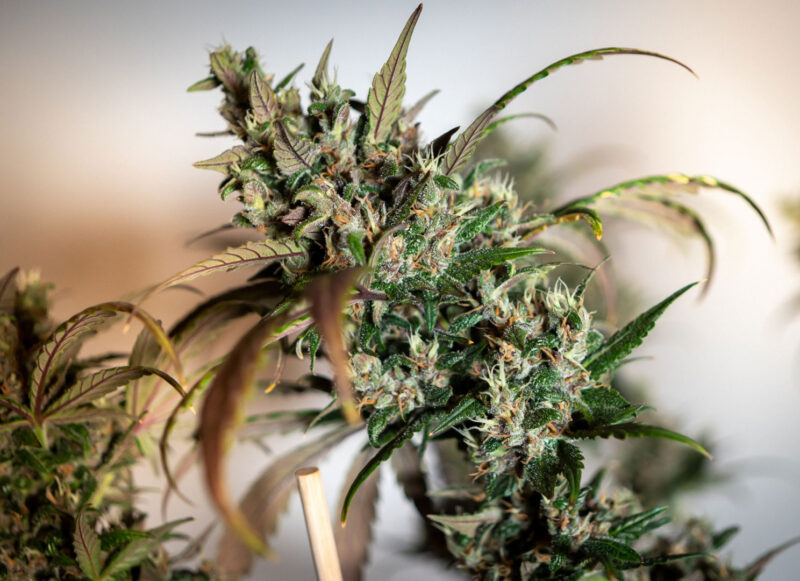
Warning: Handle your buds carefully. Avoid touching the buds directly, as this can damage the delicate THC crystals. If you need to inspect your plant, try only touching the larger fan leaves to preserve potency.
Maturity and Frosty Buds: Timing for Peak Harvest
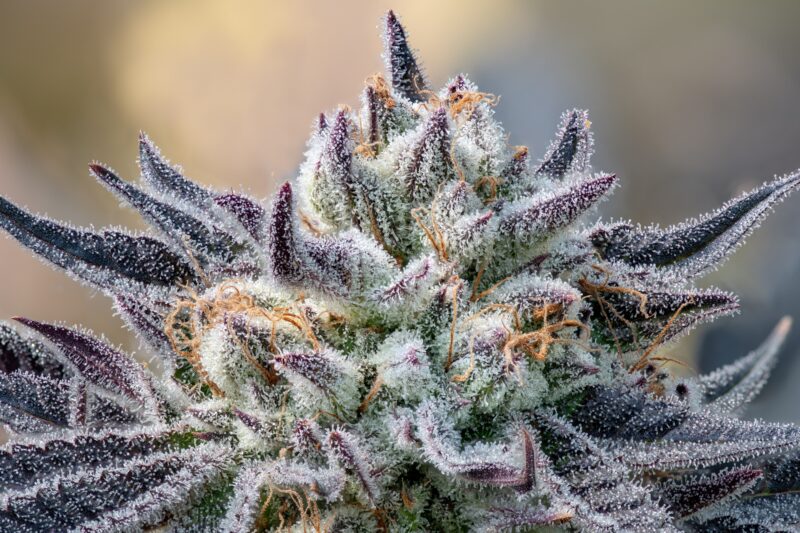
Around the third or fourth week of the flowering cycle, you’ll start to see those beautiful, glandular stalked trichomes forming along the surfaces of your leaves, flowers, bracts, and stems. This is when the magic happens, as more and more trichomes develop, signaling the potency that’s building up. As your plant progresses, you’ll notice the flowers—also known as calyxes—begin to cluster together, creating those dense buds that we all aim for.
In the early stages, the pistils of these young flowers will be bright white, eventually transitioning to a reddish-brown hue as they mature. These flowers typically ripen from the bottom of the bud to the top, with the lower pistils being the first to darken. For most Indica strains, this process usually begins by the sixth week of flowering.
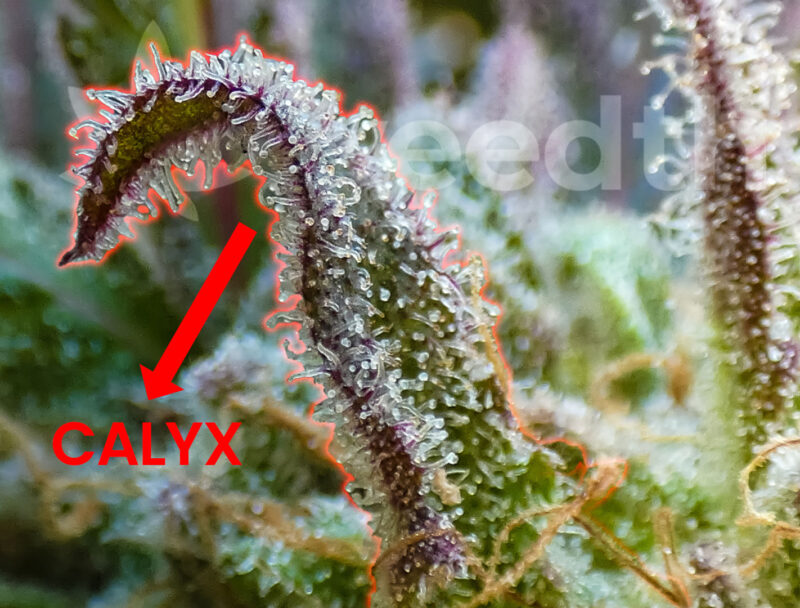
One of the best indicators of maturity is the swelling of the calyxes. When you see this swelling happening, it’s a clear sign that your buds are reaching their peak. The oldest calyxes at the bottom of the plant will swell first, with the swelling working its way up to the younger flowers at the top. By the time your Indica is in full bloom, around 90% of the calyxes will look so plump they almost appear seeded. This happens around the seventh week of flowering for basic Indica strains, and about three-quarters to 90% of the pistils will have turned that signature reddish-brown color.
By the eighth week, the majority of the calyxes will have fully swollen, and you’ll see a surge in trichome development. These last stages are crucial, and patience is key to ensure your buds reach their maximum potential.
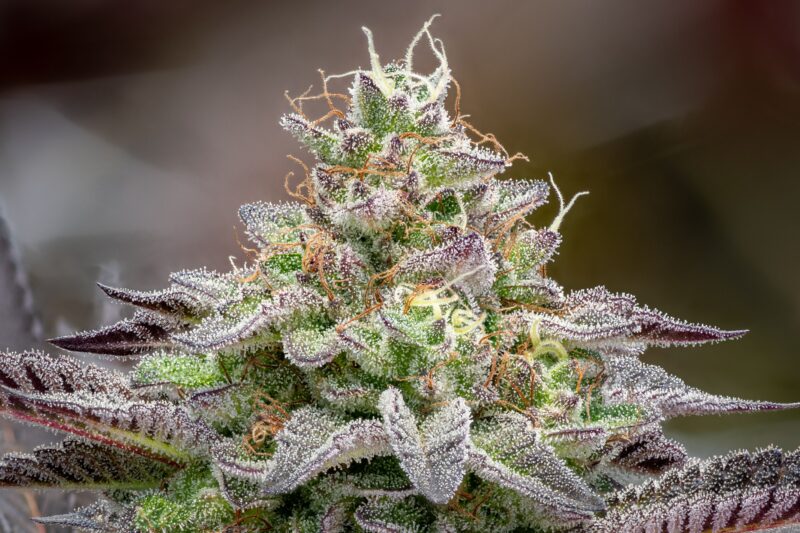
For Sativa strains, the ripening process is quite similar but often extended over a longer period. Some Sativa plants will have windows of peak harvest that can open and close, meaning that they may show signs of full maturity one week and then enter a growth spurt the next. These growth spurts can sometimes lower the trichome-to-fiber ratio, temporarily affecting potency. However, these spurts are often followed by an increase in trichome production. Again, experience and timing are everything when it comes to harvesting at the perfect moment.
Mastering these subtle ripening cues will allow you to harvest frosty, potent buds that are coated in resin, packed with flavor, and brimming with cannabinoids. Time and experience are your best guides through this process, and learning to watch for these signs will ensure that your buds are harvested at their absolute best.
Chemical Changes During Maturation
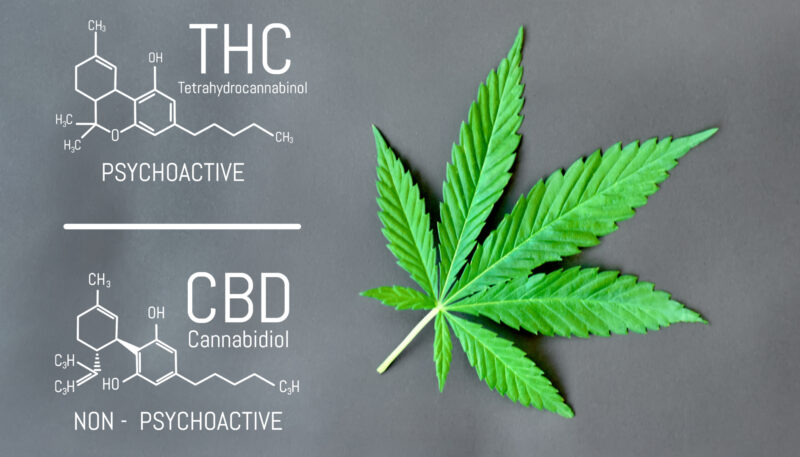
As your cannabis plant gets closer to harvest, its chemical composition changes, especially in the final growth stages. Cannabinoid transformation is start to this process, with THC gradually breaking down into CBN and CBD. This shift directly influences the effects your cannabis will produce, making harvest timing crucial to achieving the high or relief you’re looking for.
Harvest timing ultimately comes down to your preferences and desired effects. If you harvest early when THC levels are at their peak, You’ll experience a more thoughtful and uplifting feeling that’s great for socializing, sparking creativity, or enjoying during the day.On the other hand, allowing your plants to mature longer creates a more narcotic, body-relaxing effect, which is particularly strong in Indica strains. This is ideal for evening use or for those seeking medicinal relief from stress or pain.
As the plant matures, THC starts to degrade and the nature of the high evolves. What was once a euphoric, energetic high shifts towards a calming, sedative experience as CBN levels increase. This natural breakdown can be managed to match your desired effects. For growers, this means observing and understanding these subtle changes so that you can harvest at the right time to achieve your preferred outcome.
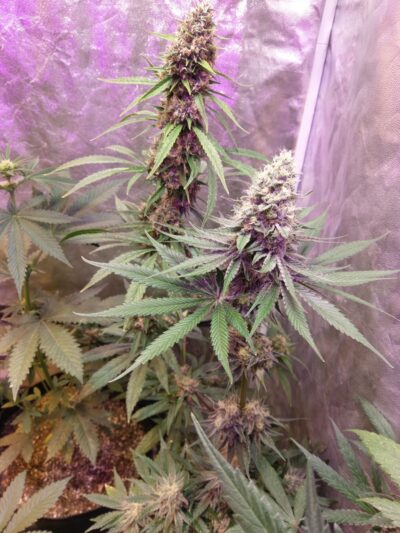
There’s no “right” time to harvest for everyone—it’s a personal choice, influenced by what kind of experience you want from your cannabis. The key is keeping a close eye on the plant’s trichomes and pistils to monitor maturity. Through observation and experience, you’ll find what works best for your individual needs.
The final touch comes with proper curing. After harvesting, careful drying and curing ensure the full development of terpenes and cannabinoids. This post-harvest process locks in the aroma, flavor, and potency, enhancing the chemical profile of your buds and delivering a product that’s not only potent but also flavorful. By paying attention to the details during curing, you can preserve and even boost your harvest’s quality, making the result truly exceptional.
The Best Time to Harvest
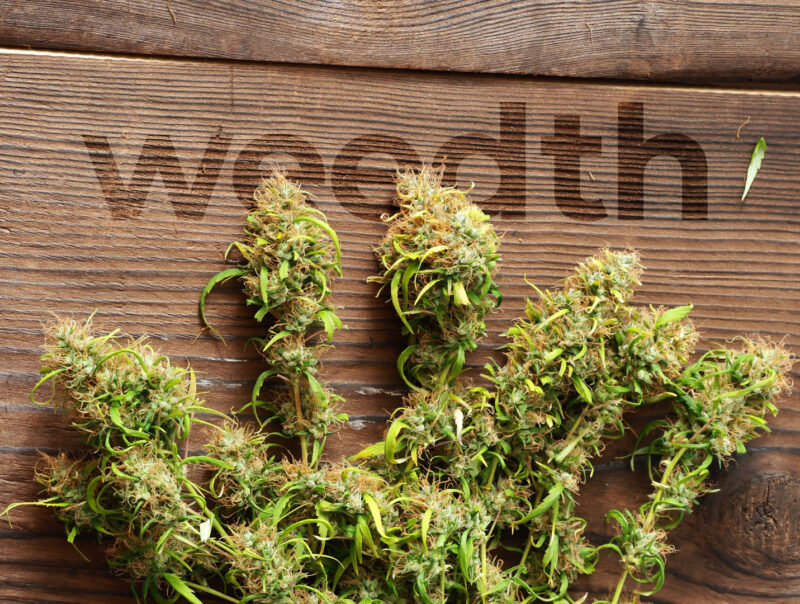
Finally, the moment every grower waits for harvesting time. After months of nurturing your plants, the reward for all the effort is about to be realized. Harvesting cannabis at the perfect time can be a hard, especially for new growers but experience and observation are your greatest teachers. With time, you’ll hone your ability to determine when your buds are at their peak potency.
Maturity and THC
A common misconception is that bigger plants equal mature plants. But when it comes to cannabis, the true measure of maturity lies in the THC levels. Most growers aim to harvest their plants when THC is at its peak, but measuring THC precisely requires lab equipment that most growers don’t have access to. Instead, growers use visual cues and observation to gauge the plant’s maturity.
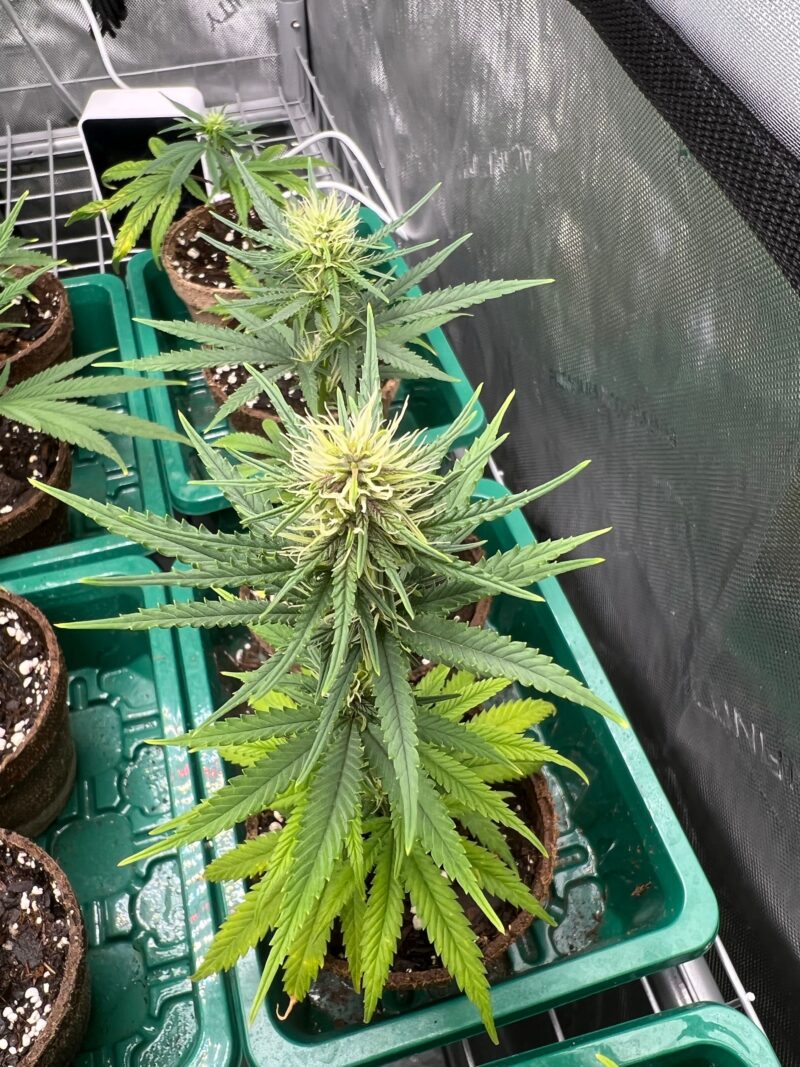
As a cannabis plant grows, each new pair of leaves contains more THC than the last. The highest concentration of THC will always be found at the budding tips. Both male and female plants contain THC, but females are prized for their resinous buds. Some growers like to take samples of shoots before peak THC is reached to gauge the plant’s development.
Plant Size
Mature cannabis plant doesn’t need to be tall to produce potent buds. Some indoor plants can be under 18 inches (0.5m) and still be ready to harvest. Don’t let the size fool you—size is not an indicator of maturity, especially when growing indoors where space is limited.
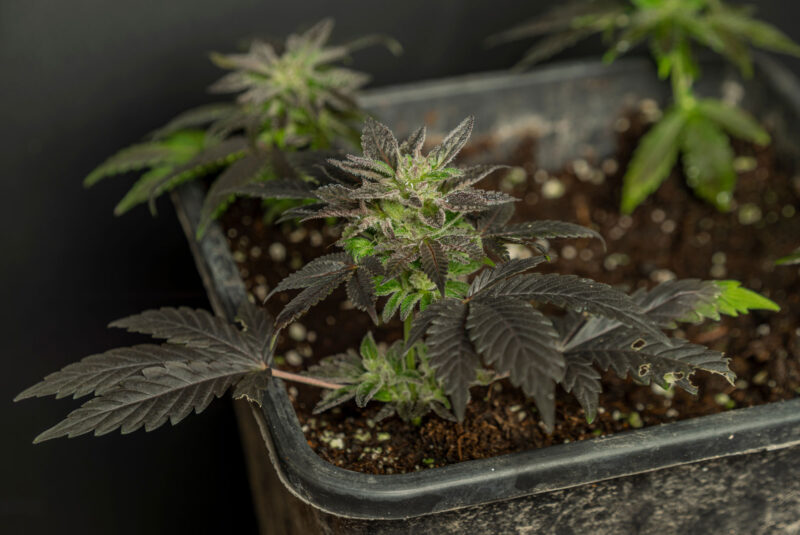
Photoperiod and Maturity
Maturity in cannabis plants is not determined by age alone but by the photoperiod the amount of light they receive each day. The plant will transition from vegetative growth to the flowering stage when the light cycle is reduced to less than 12 hours a day. As a rule of thumb, plants need to be at least 60 days old before they’re mature enough to respond to the light cycle change. Some growers report that clones can bloom earlier because they are taken from mature plants.
For indoor growers, when to change the photoperiod often depends on the available space and the desired size of the plant. Some growers force their plants to flower earlier, while others let them grow larger before inducing flowering.
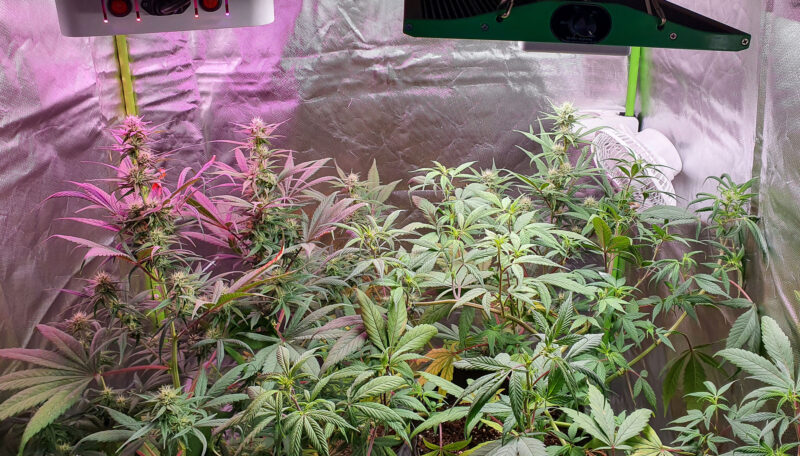
Male vs. Female
One important observation, male flowers tend to show before female buds. As soon as you spot the males in your garden, you’ll know that female buds are just around the corner, usually within 1-2 weeks.
Variety and Maturity
Different cannabis varieties mature at different rates. Narrow-leafed Sativas, for example, tend to take longer to finish flowering compared to wide-leafed Indicas. Under some conditions, Sativas can require an additional month or more to mature fully, whereas many Indicas are ready in 7-9 weeks. Knowing your strain and its average maturation time will help you plan your harvest more accurately.
Monitoring Buds
The best way to tell if your plant is ready for harvest is by carefully observing the buds. Look at the pistils and stigmas—the white hairs in the center of the female bud—and the calyx, the pod that would surround a seed if fertilized. Experienced growers often harvest individual buds as they reach peak maturity rather than harvesting the entire plant at once.
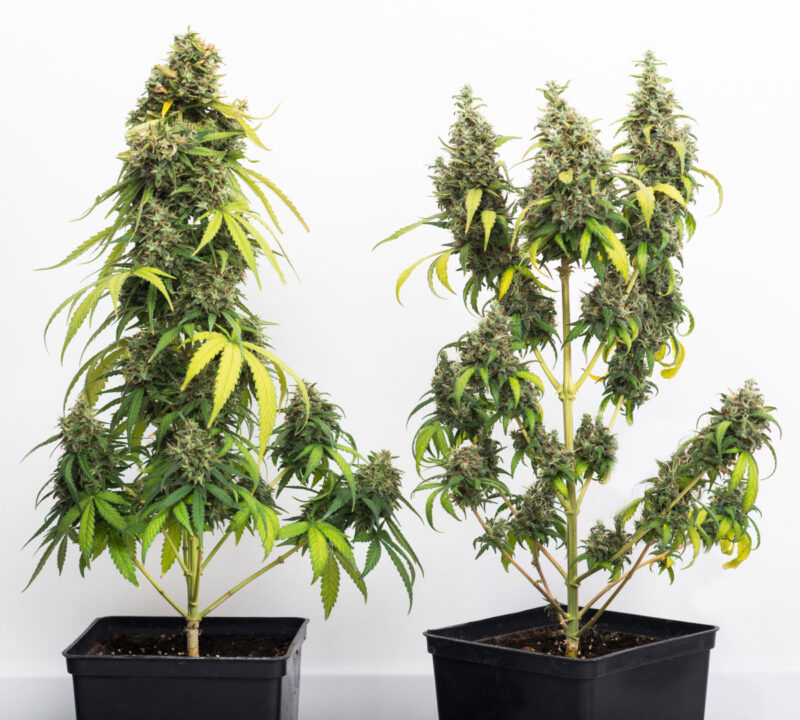
A common guideline is to harvest your plants when about half of the pistils have withered. As the resinous qualities of the plant become more apparent, the bracts and small leaves may swell. However, if left in the ground too long, the buds may become harsher to smoke.
Pistils and Glands
As the pistils turn from white to red or brown, and the glands begin to swell, the bud is nearing readiness. Some growers prefer to harvest at this stage for a clear, cerebral high, while others wait longer for a more sedative effect.
Harvesting Indoor Buds
When growing indoors, buds usually mature from the top down, especially under artificial light. To ensure maximum quality, it’s best to harvest buds as they mature, starting from the top of the plant. The flowering cycle lasts for a specific period, and after it ends, the plant will not continue to produce new buds at the same rate. While it is technically possible to return the plant to a vegetative light cycle for regrowth (a process known as "re-vegging"), this method is not commonly practiced due to the significant stress it places on the plant, the time required, and the likelihood of reduced yields in subsequent harvests. Most growers prefer to start with new seeds or clones after harvesting to ensure optimal plant health and productivity.
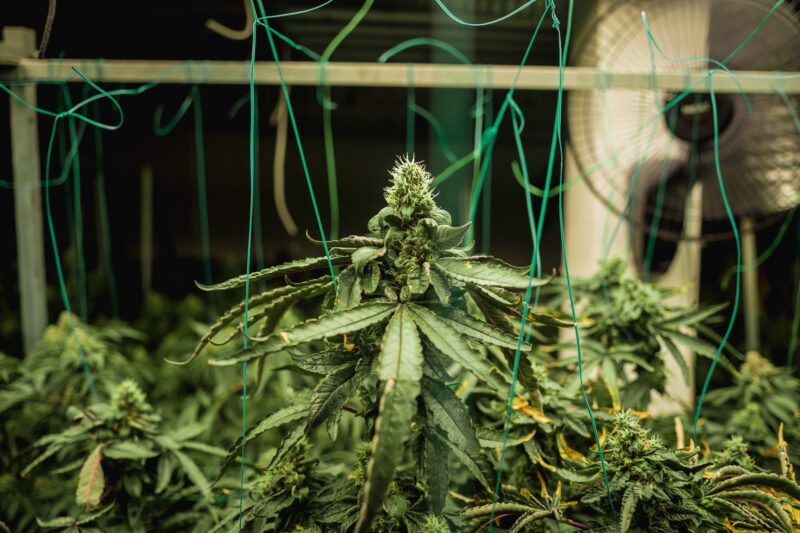
Experience
If you’re new to harvesting cannabis, don’t worry. Over time, you’ll develop an instinct for when your plants are ready. Keep an eye on the pistils, trichomes, and the general health of the plant. With each harvest, you’ll gain experience and improve your ability to determine the perfect time to cut your crop. And remember, you can always ask about the average harvest time for your particular strain when you get your seeds. Experience is the best teacher and each grow means you’ll get better at perfecting your harvest timing.
Harvesting Your Buds
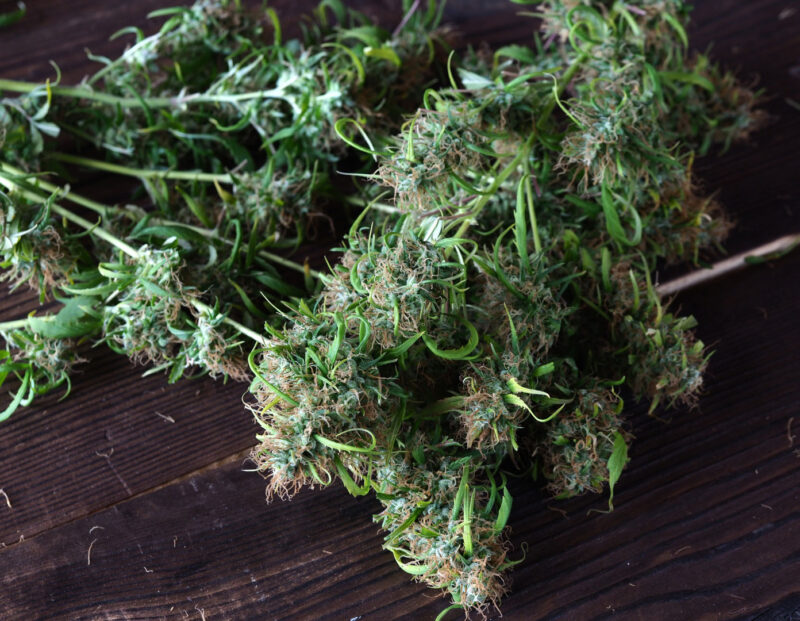
Welcome to the most exciting part of the cannabis growing process harvesting! This is the moment when you finally get to see the results of your hard work. Harvesting is about carefully cutting down your plants and preparing them for the drying and curing stages, ensuring you get the highest quality buds possible. But, before we dive into the process, be prepared: harvesting can release a strong, pungent odor that will spread quickly, so if discretion is important, plan ahead.
When it’s time to harvest, don’t just rush in and start cutting. You’ll need to carefully cut the plants at their stems, just below the lower leaves, using a sharp, clean knife or hacksaw. This ensures a clean cut and prevents unnecessary damage to the plant.
For smaller gardens (with fewer than 15 plants), expect the harvesting, trimming, and hanging process to take several hours. It’s a time-consuming task but you can’t cut corners here. Set aside a steady 6 hours for your first small harvest or plan for a full day if you have a larger garden (more than 50 plants). Remember, this is a key moment in producing top-quality buds, so take your time and be methodical.
Flushing
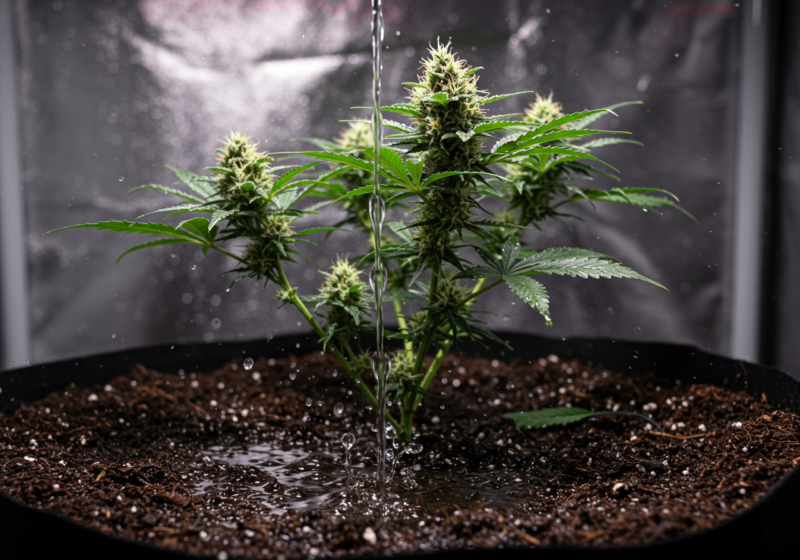
Before you get to cutting your plants down, there’s an essential step is flushing. Flushing is the process of feeding your plants plain water with no nutrients to clear out any excess fertilizer or nutrient buildup in the plants and the growing medium. This step is critical to ensure your buds are clean, smooth-smoking, and free from harsh or chemical tastes.
- Hydroponic Growing: In hydroponic systems, start flushing your plants about 7 days before harvest. To do this, simply change the nutrient solution and use only distilled water or water treated with reverse osmosis. Many growers even change the water multiple times during this period to ensure that all nutrients are fully flushed from the medium. This step helps prevent the buds from tasting harsh or chemically after drying and curing.
- Soil Growing: For soil-grown cannabis, begin flushing 14 days before harvest. Just like with hydro, use only pure water to feed the plants—no nutrients. Avoid slow-release fertilizers, as they can be difficult to remove. If you’ve been using slow-release fertilizers, switch to regular nutrients for the last month before flushing begins.
Master Advice: If you’re growing in soil, stop watering the plants 2 days before harvest. This helps to speed up the drying process once the plants are harvested.
WARNING: Never stop watering hydroponic plants before harvest. If you cut off their water supply, they will wilt and begin to die within hours, severely impacting the quality of your harvest.
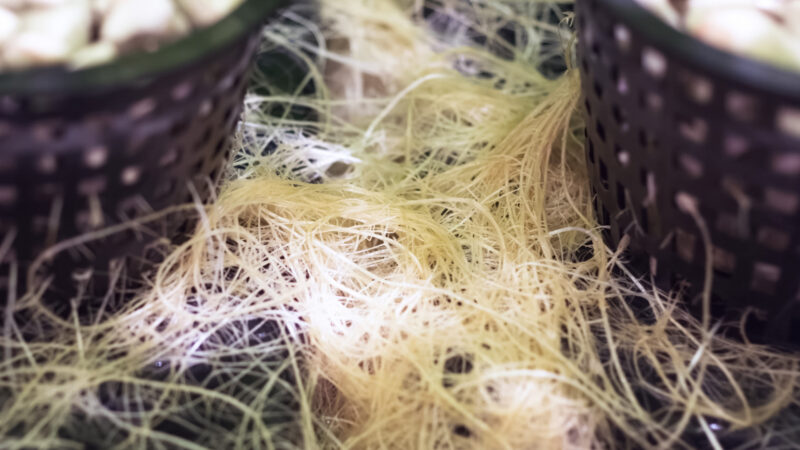
Keeping as many leaves green as possible until weeks 5 or 6 of flowering is also a good practice. During the final 2 to 3 weeks, allow the plants to metabolize their remaining minerals. This helps improve the flavor, smell, and burn quality of your buds. In hydroponics, maintain the total dissolved solids (TDS) in the flushing solution between 400-500ppm. Going lower than this can shock the plants and affect their final quality. The plants will use their stored nutrients to finish photosynthesis during the flush, resulting in smoother, cleaner buds when harvested.
To ensure the best flushing results, make sure to use high-quality water.
Note: Tap water tends to have lots of chemicals like antibiotics, anti-convulsants, mood stabilizers, and sex hormones. It is best to use distilled/purified water or water treated with reverse osmosis for this purpose.
This will help prevent the plants from absorbing any unwanted chemicals or impurities as they flush.
Flushing is a crucial step for producing smooth, flavorful cannabis, so take the time to do it right. Whether you’re growing in soil or hydro, proper flushing ensures that your buds will taste clean, burn evenly, and provide the best possible experience once dried and cured.
Where to Start Cutting?
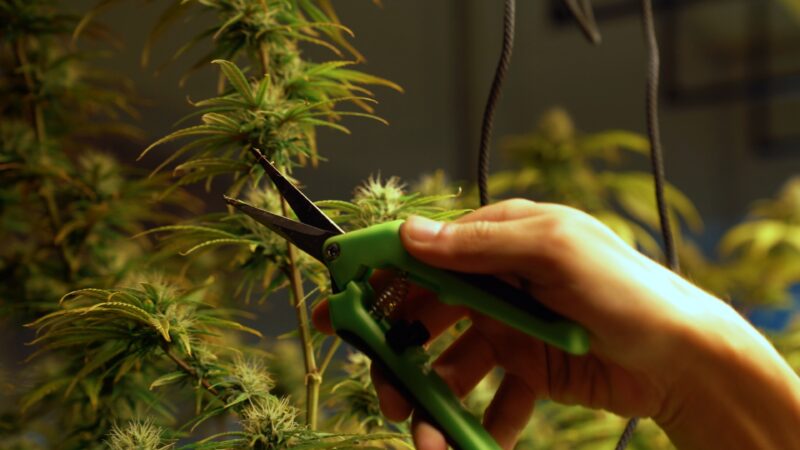
Well, it’s finally harvest time! But you might be wondering, “Where do I start?” Don’t worry—this part of the process is largely based on personal preference. The most important thing to keep in mind is to handle the flowers as little as possible to avoid damaging those delicate trichomes. You’re potentially reducing their potency every time you touch the buds, so minimal handling is important.
One safe way to manage the plants during trimming is to leave them in their pots (keeping them more or less intact) and spread out a couple of newspapers for easy cleanup. Toss the large sun leaves onto one sheet, and do your small bud trimming over the other.
Start by trimming off the large sun leaves first, and then move on to the smaller ones. By removing the bigger leaves first, you’ll have less clutter in the way as you work your way toward the buds. Leave the buds on their stems for now—this will make handling easier during drying.
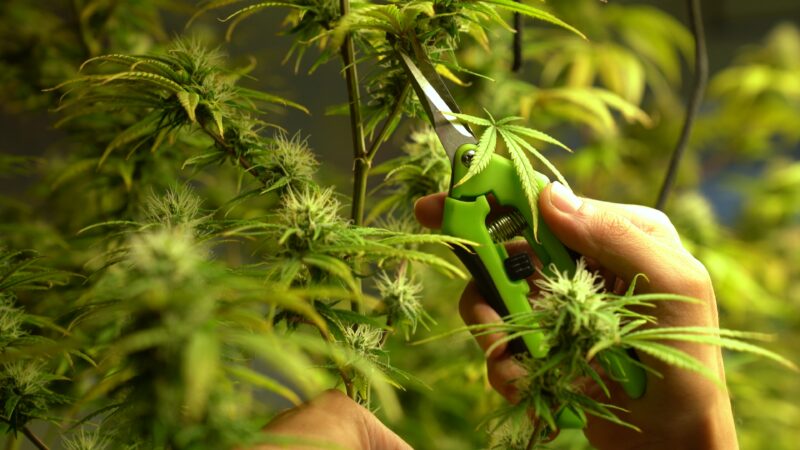
When trimming the buds, begin with the tiny “popcorn” buds at the lower part of the plant. These lower buds usually aren’t as developed as the top colas but don’t throw them away. Set these aside where you’ll store your trim; they’ll still have plenty of resin and can be used to make hash, oil, or butter.
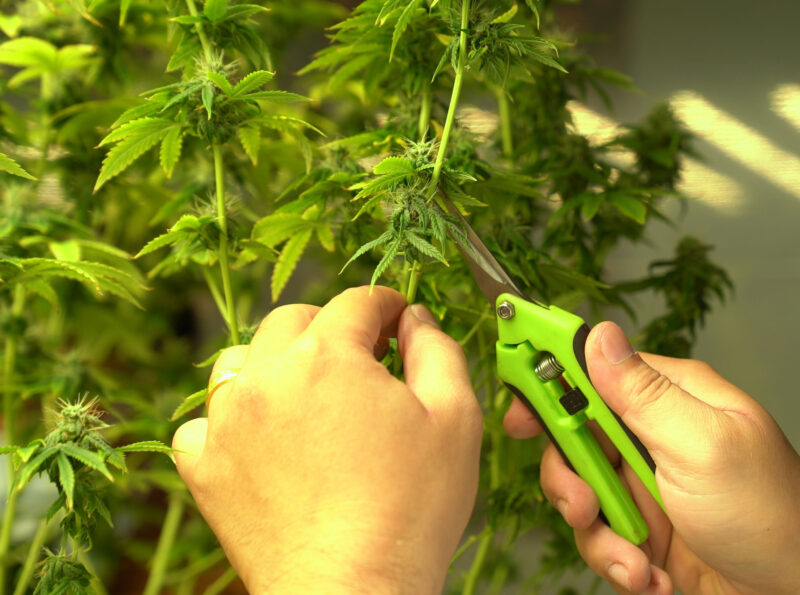
Next, start working on the leaves that are actually on the buds. These leaves are often coated with trichomes and should also be saved for later use. Clip off the stem part of the leaf, and then trim in a circular motion around the bud until you reach the sugary coating. Trimming beyond that point is unnecessary and wasteful. Don’t worry if the buds look a little fluffy or leafy at this stage if you’ve done everything right, they’ll dry and cure into those dense, sticky buds everyone loves.
Once you’ve trimmed all the bud leaves, you should be left with your buds attached to a nice, thick stem network. This setup is perfect for most drying and curing processes. Some growers choose to clip at the main stem and hang the entire plant upside down to dry, while others prefer to break the plant down into smaller sections for drying. It’s all about what works best for you.
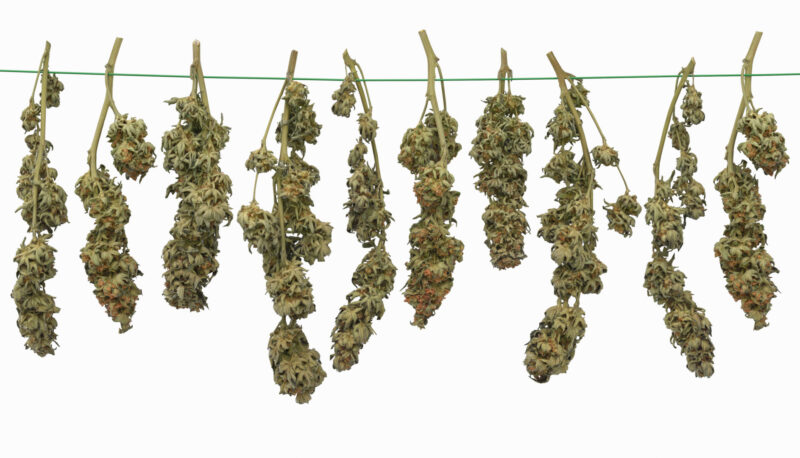
When cutting, be sure to leave enough stem on the buds to easily handle them during the drying process. While you’ll likely trim the stems down further once they’ve dried, having that extra bit of stem now will make things much easier. And remember, dried stems don’t weigh much, so they won’t affect your final yield in any significant way.
It’s often best to leave the large top buds in one solid piece if you can. You can always trim them down one node at a time once the drying process is complete.
At this point, your plants are in their most vulnerable condition when it comes to mold. Mold can be disastrous, spreading from the inside of the buds and often remaining invisible until it’s too late. Mold can destroy your entire crop overnight, so be sure to maintain low humidity levels during the final weeks of maturity to reduce the risk of a mold invasion.
Cutting
Harvesting via Cutting
You’ll need to gather a few key tools before you start, sharp pruning shears, sturdy scissors, and something to hang the plants on, like a clothesline setup. You’ll also need a cool, dry, smell-proof room for drying. Those tiny trichomes are pure gold, so don’t let them go to waste!
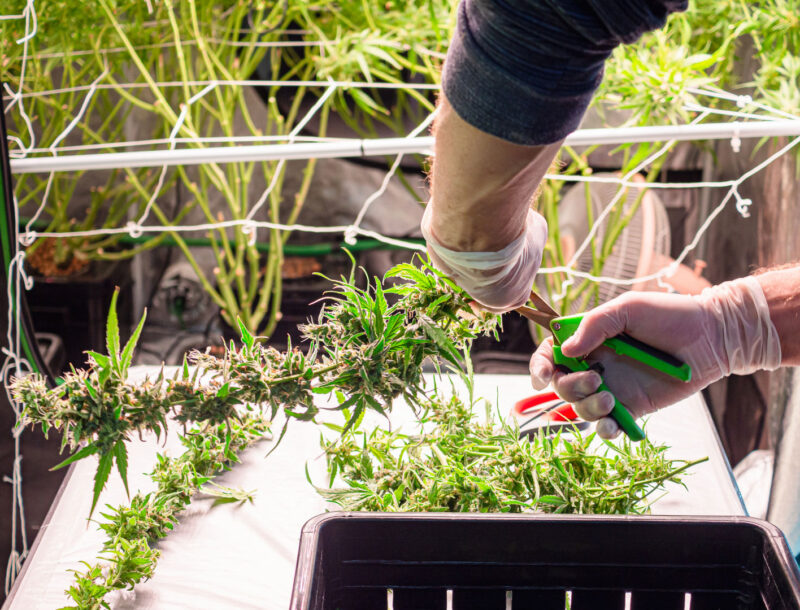
Let’s begin, you can harvest the entire plant at once by cutting it down at the base of the stem, just above where it meets the soil or hydroponic medium. You can use a clean, sharp pair of scissors, a knife, or even a hacksaw—whatever tool gets the job done efficiently. If you prefer, you can also harvest each branch individually as it matures. This method allows you to get the absolute most out of your plant if different parts are maturing at different times.
Helpful Tip: Leave a few inches of stem at the base of each bud. This extra stem will make it much easier to hang the buds for drying later on.
The methods for harvesting Indica and Sativa plants are a bit different, so we’ll go over the specifics for each in the next steps.
Harvesting Indica: Step-by-Step
Step 1: Start by cutting your 1-4 foot plant at the base. Once cut, turn it upside down and hang it in a cool, dark room with plenty of fresh air circulating. Light exposure at this stage can degrade THC, so complete darkness is key.
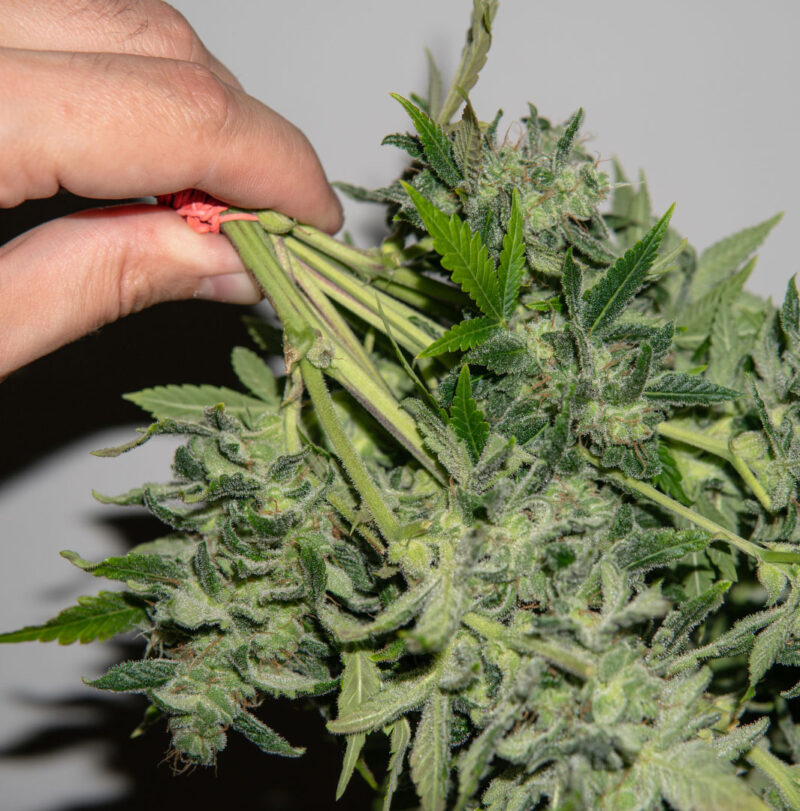
Step 2: Use a pair of clippers to remove as many fan leaves as possible. If you prefer, you can strip the larger leaves by hand—just be gentle to avoid damaging the trichomes.
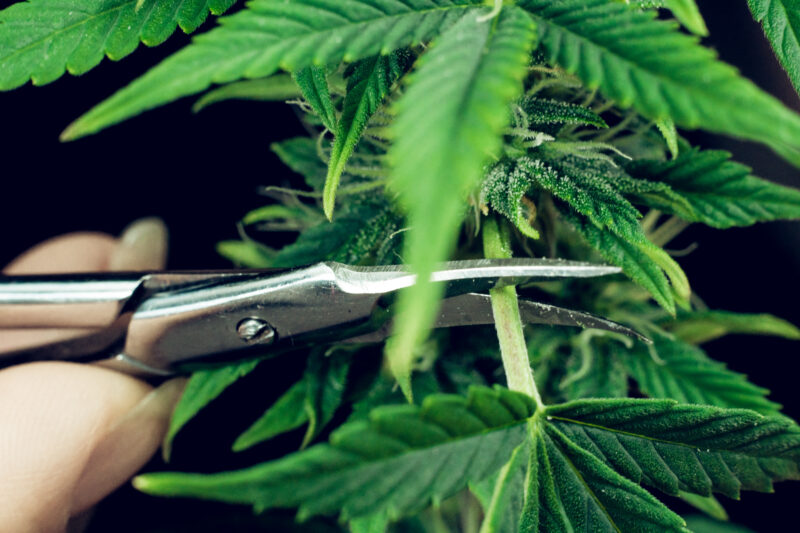
Step 3: After removing the fan leaves, move on to the smaller secondary leaves around the tops of the plant. Set these aside in a separate pile for later use, as they contain resin.
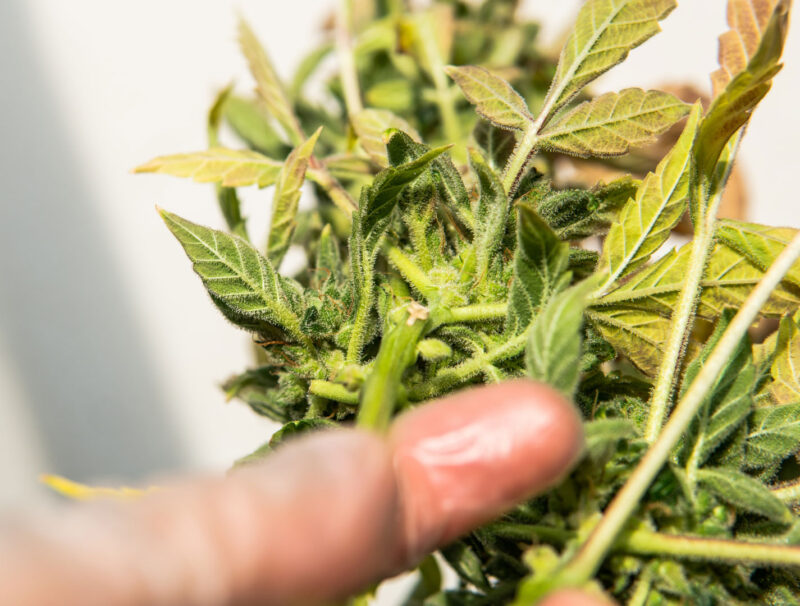
Step 4: Now it’s time to trim the leaves directly surrounding the buds—often called “trim”—which are covered in resin. These tiny leaves are valuable for making hash or edibles, so don’t toss them out!
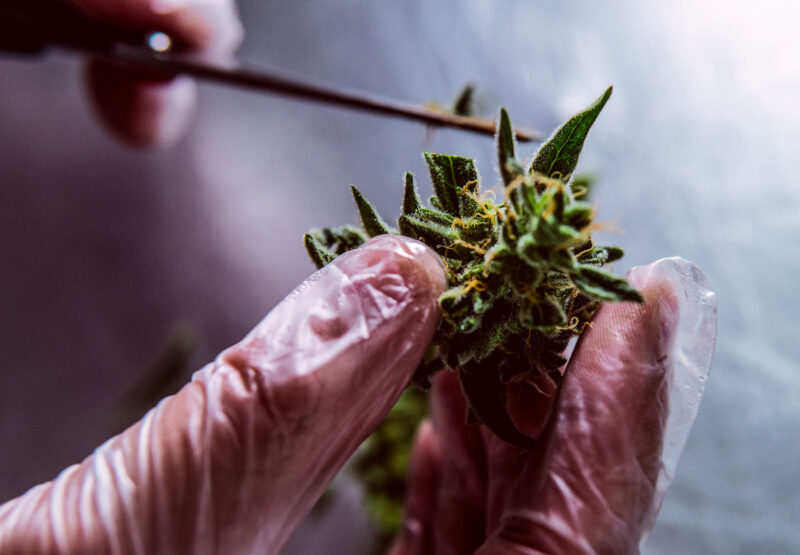
That’s it! Once you’ve trimmed the plant, it’s ready to dry and cure.
Harvesting Sativa: Step-by-Step
Harvesting Sativa plants is similar to Indica, but it can be a little trickier due to their bushier nature and longer flowering time. However, the extra effort pays off!
Step 1: Just like with Indica, start by cutting the plant at base. Hang the entire plant upside down in a cool, dark room with good airflow. Keeping the room dark is especially important here, as exposure to light can quickly degrade the THC levels in Sativa strains.
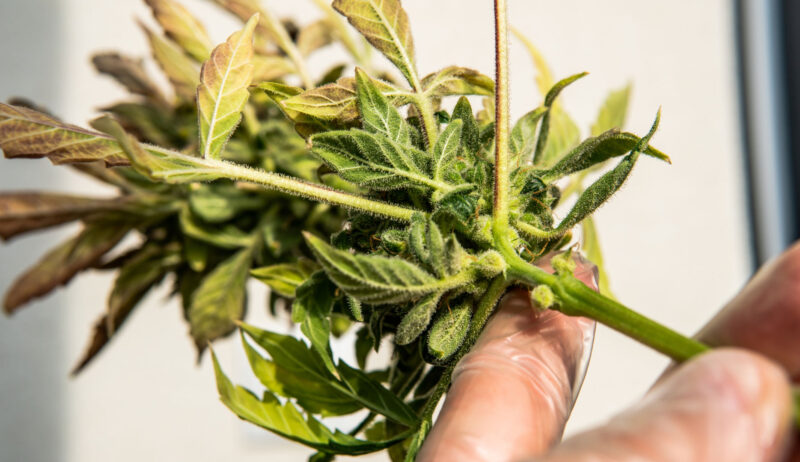
Step 2: Grab your clippers and start removing the leaves. You can also remove the larger leaves by hand if you prefer. Sativa plants are typically bushier than Indicas, so this step may take a bit longer. You may also need to cut branches separately to hang them for drying.
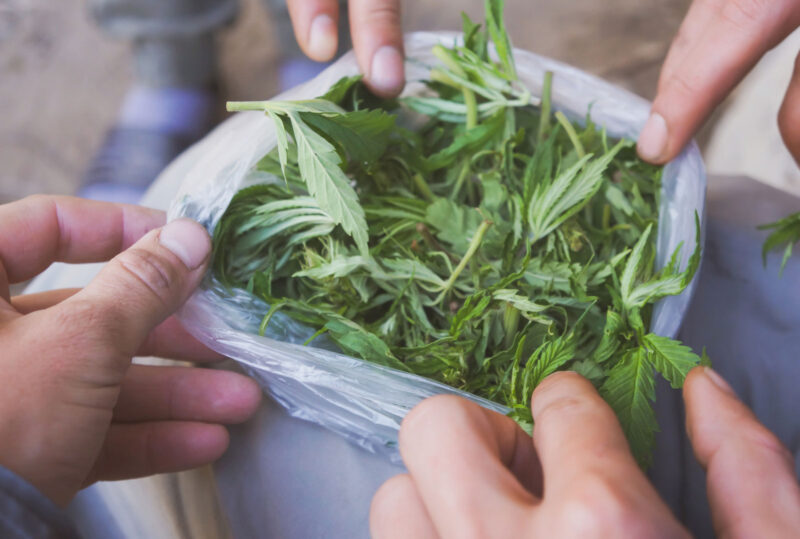
Note: Be careful to avoid exposing your harvest to direct light, as it can degrade THC and impact the potency of your buds.
After harvesting, the next steps in the process are manicuring and drying. Leave the plant as is until you can easily snap a branch between your fingers—once you can do that, the buds are ready for curing.
Manicuring Marijuana Buds
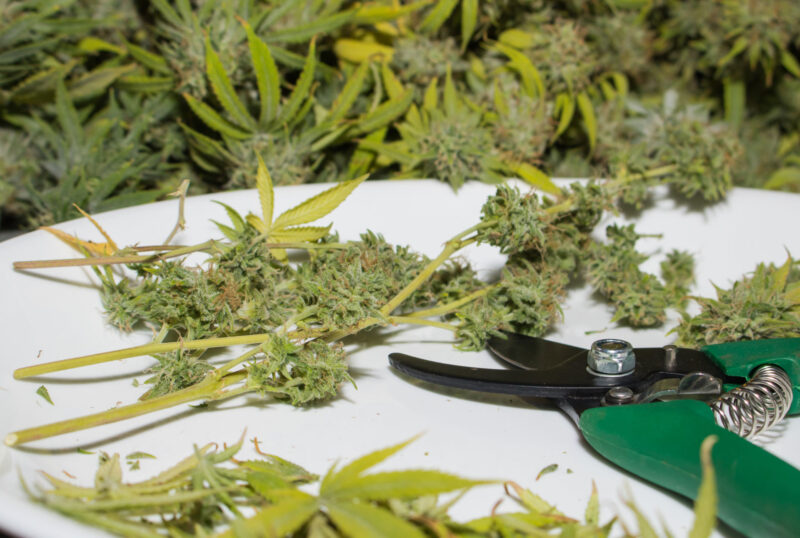
Once you’ve harvested your cannabis plants, the next crucial step is manicuring—trimming away excess leaf material from your buds. This process involves removing the leaves that surround the buds, leaving behind just the resin-rich flowers. Manicuring should be done right after harvest when the leaves are still soft and easy to trim. Doing this while the plant is fresh makes the job a lot smoother, especially compared to trying to trim dry, brittle leaves later on.
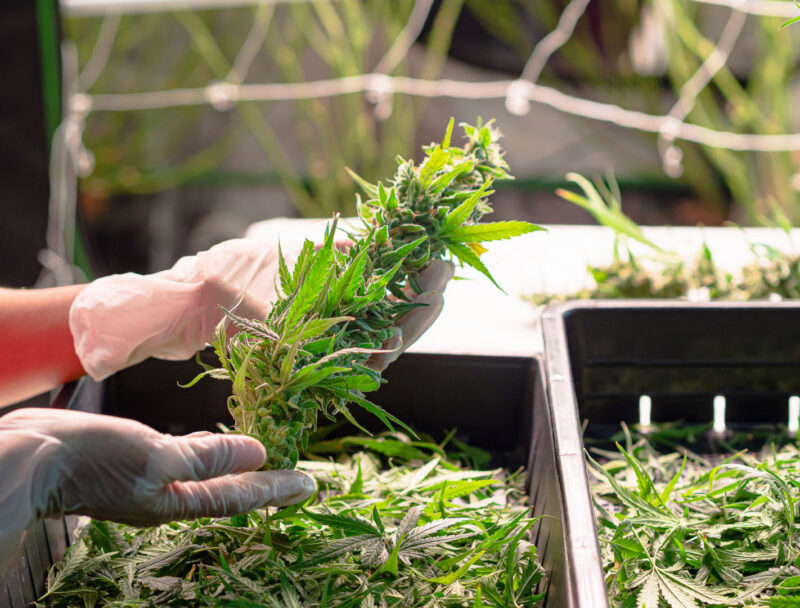
Trimming right after harvest can also help speed up drying times. When we talk about manicuring, it’s all about removing the large fan leaves that don’t contain much THC. These leaves are what you want to trim away before you hang your buds to dry. It’s a time-consuming process, but if done properly and with care, you’ll have more potent, less leafy, and much better-looking buds. You can choose to manicure either before or after drying, but you’ll find it’s much easier to do before the drying stage.
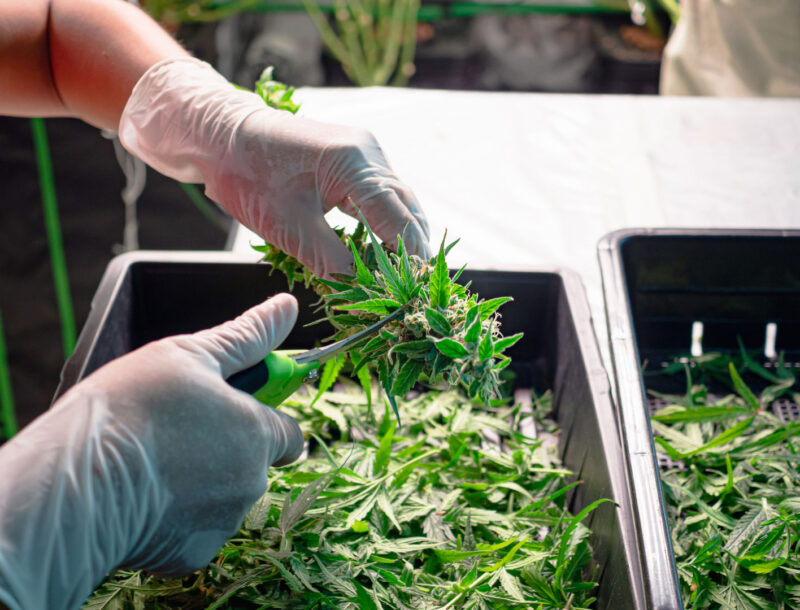
WARNING: Make sure to remove the entire leaf stem. If you leave the stem intact, it can trap moisture and encourage mold to form, which is the last thing you want at this stage.
When trimming, avoid touching the buds too much. Trichomes, which contain most of the plant’s cannabinoids, can easily break off when handled excessively. A great selling point could be “buds never touched by human hands,” so keep contact to a minimum! Continue trimming away any leaf tips protruding from the buds. The level of trimming is really a personal choice, but the key is to leave a smooth, clean bud with no unnecessary foliage.
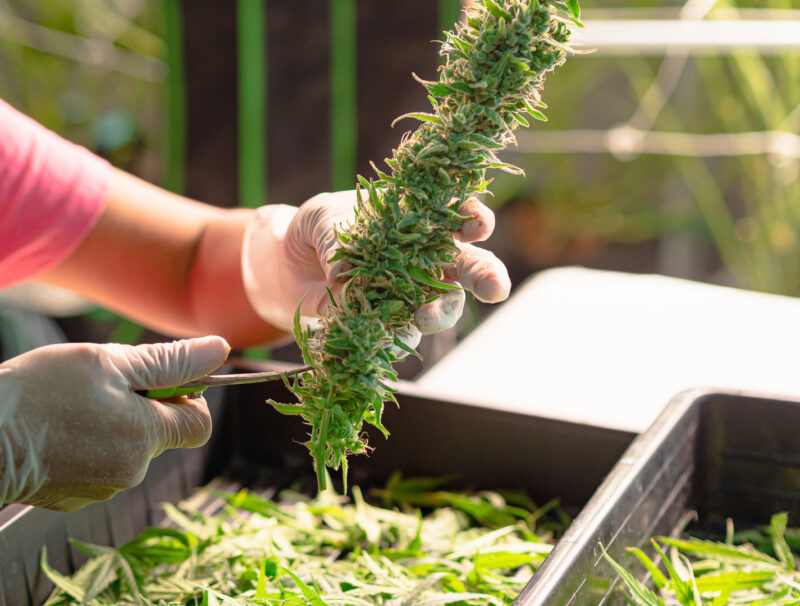
A good rule of thumb is to start manicuring when the plants are almost dry, but not completely. When the plants are too dry, many of the valuable resin glands will fall off during handling. When there’s still a bit of moisture left, those glands are more likely to stay intact.
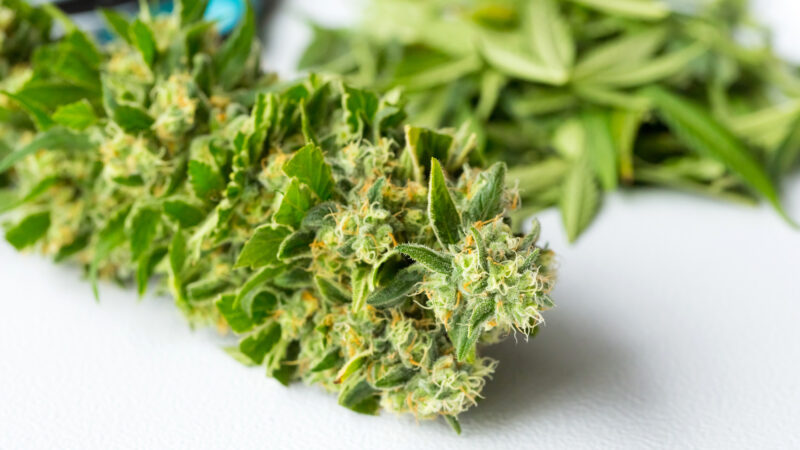
Work on a smooth surface, like a glass table, so you can easily collect any material that gets trimmed away. While the trim doesn’t have as much THC as the buds, don’t throw it away! You can use it to make hash oil, edibles, or other cannabis products.
The Right Tools for Manicuring
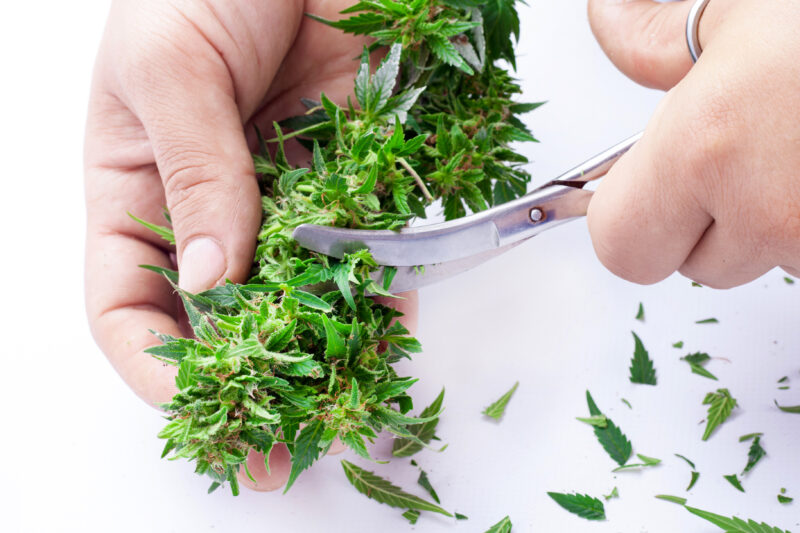
Make sure you’re using scissors with small, sharp blades so you can reach the hard-to-get leaves tucked within the buds. If you’re dealing with a small crop, you can trim by hand, but for larger gardens, it’s a good idea to wear powder-free latex gloves to keep your hands clean and to avoid damaging the buds.
Bonus Tip: After trimming, if you want to collect the resin, pop those latex gloves into a bag and freeze them for a couple of hours. Once they’re cold, you can peel off the trichome resin and enjoy it like hashish!
If you absolutely must, you can postpone manicuring but keep in mind that it will take even longer if you choose to wait. Manicuring right after harvest also has the added benefit of speeding up the drying process considerably.
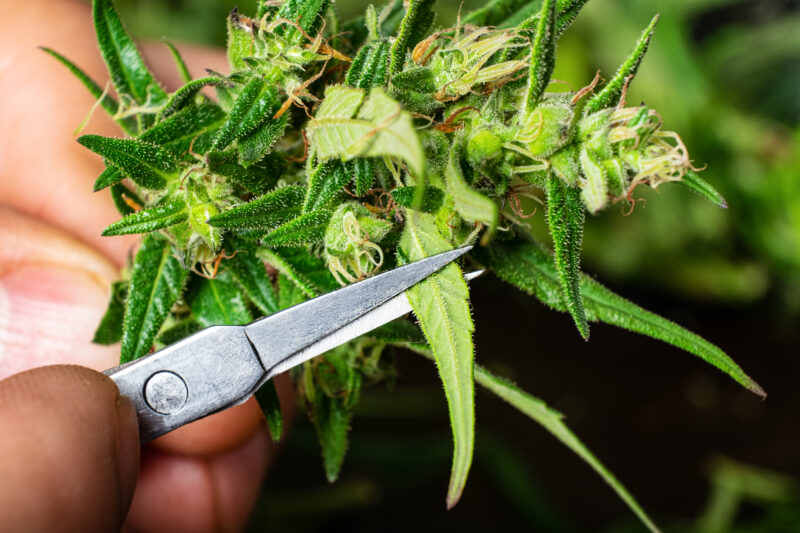
Your buds should still be slightly moist, especially on the inside. While you may be tempted to start smoking them right away, resist the urge! Drying and curing will enhance the aroma and flavor, and the buds will burn much smoother. Many novice growers rush this step, but trust me, it’s worth the wait. And whatever you do, don’t even think about throwing your freshly harvested buds in the microwave to speed up drying—that’s a surefire way to ruin all your hard work!
Dry and cure your buds properly for the best possible taste and potency. Patience is key!
Drying Your Buds
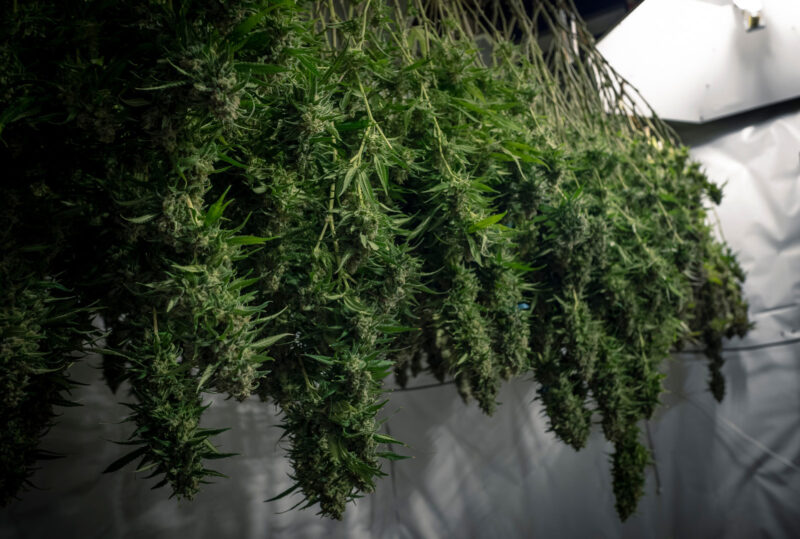
Now that trimming is done, it’s time to move on to the all-important drying phase. Drying and curing marijuana properly is critical—this stage is where you can make or break the flavor, aroma, and potency of your final product. If you rush or mishandle it, you’ll end up with harsh, weak-tasting buds. But if you do it right, you’ll preserve (or even enhance) all the things that make your cannabis truly special.
The drying and curing process allows the plant to purge sugars and, if desired, get rid of that grassy chlorophyll taste. However, some people actually enjoy the taste of chlorophyll, so that’s a matter of personal preference. The key point is improperly dried or cured marijuana can lose nearly all of its potency and believe me, once you’ve messed this up, there’s no turning back.
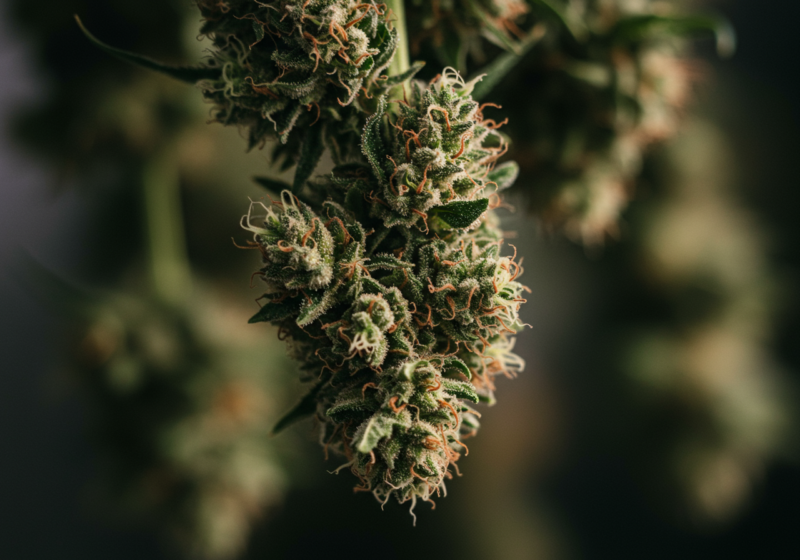
There are four key enemies during drying; light, heat, air, and rough handling. Too much of any of these, and your precious trichomes degrade into less potent compounds. Marijuana that hasn’t been properly dried or stored can also retain too much moisture, leading to mold—a disaster for any grower. The trick is patience. Rushing things will only dry the outer part of the bud while locking in moisture in the middle. That’s why slow, even curing is essential to draw out moisture from deep inside the buds.
How to Dry Your Buds:
Drying can be done a few ways, but the most common is to hang your trimmed branches upside down. Let the fan leaves droop and cover the buds—this slows down the drying process and helps protect the flowers. Make sure you hang them in a cool, dark place that’s well-ventilated. And don’t forget—humidity is your enemy. If your drying space is too humid, mold can creep in and ruin everything. It’s also important that this space is totally dark—light will degrade your THC quickly.
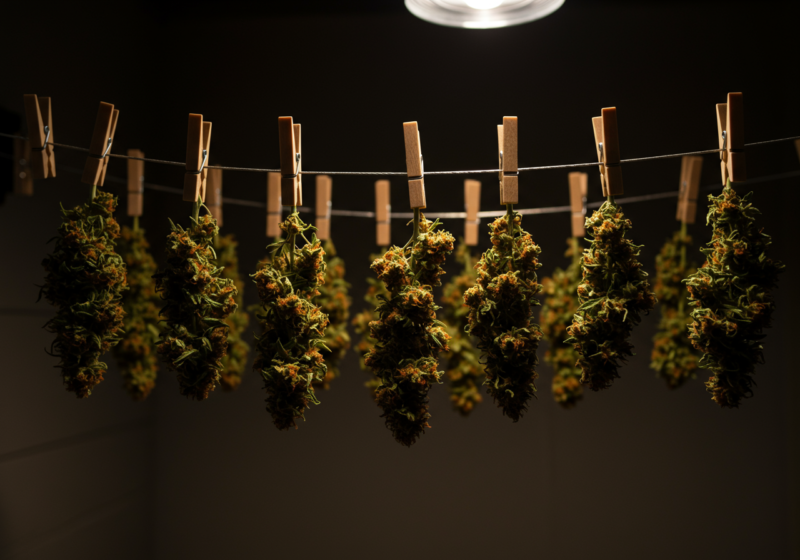
A good drying area should maintain a temperature around 65-75°F (18-24°C), but never let it rise above 80°F (26°C), or you’ll risk losing potency. Proper airflow is also essential—fans can help circulate air, but don’t point them directly at the buds.
If you dry your buds too fast, they’ll taste like pine needles or hay—not exactly the flavor you want after months of hard work. Patience is key here. Letting them dry slowly ensures that all the flavor, aroma, and potency stays intact. Proper drying and curing will also convert non-psychoactive THC-A into the potent THC we all love.
When you hang your marijuana upside down in the dark, gravity will pull all that remaining THC down into the buds, maximizing potency. Keep in mind that your freshly harvested buds aren’t as potent right after cutting—they still contain THC in its acidic form, which doesn’t give the psychoactive effects until it’s properly dried and cured. So, drying your buds the right way is absolutely crucial to high quality of your harvest.
Conditions for Drying:
Keep your drying space completely dark—any light exposure will start breaking down THC immediately, reducing potency. And as for temperature, anything higher than 80°F (26°C) will degrade THC as well. Humidity should stay between 45-55% for optimal results. The slower the drying, the smoother and tastier your buds will be.
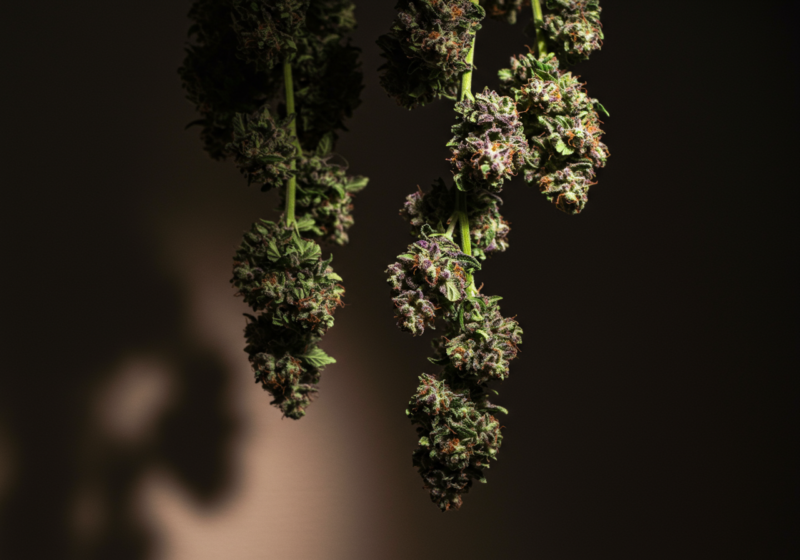
Patience pays off. If you rush it, you’ll miss out on all the rich, flavorful aromas and potent effects that make your harvest special. Take your time, keep conditions optimal, and your reward will be worth every minute.
Air Drying Your Buds
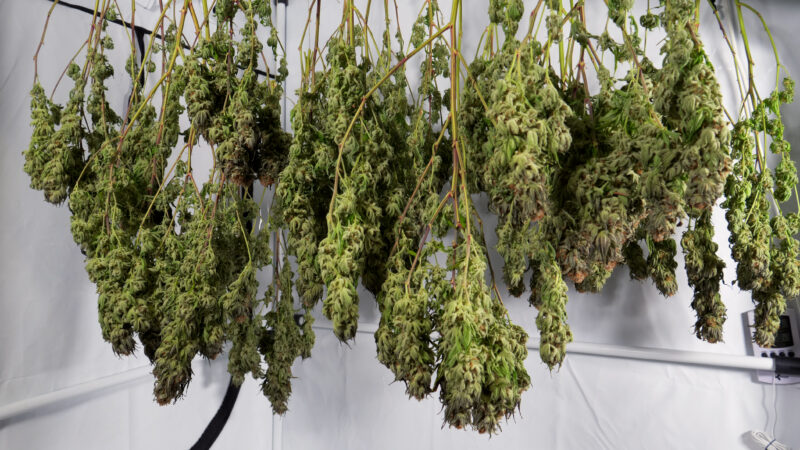
Air drying is hands down the most popular and effective method for drying cannabis today, and it’s no surprise why. It gives you control over the airflow, which lets you manage the speed of drying—crucial for preserving potency and flavor. When done right, air drying results in beautifully dried buds, ready for curing or consumption.
The most common technique is to suspend the freshly harvested plants upside down in a dark room, keeping good air circulation throughout the space. Don’t point the fan directly at the plants though—just enough to keep the air moving around them. This ensures even drying without drying out the buds too fast.
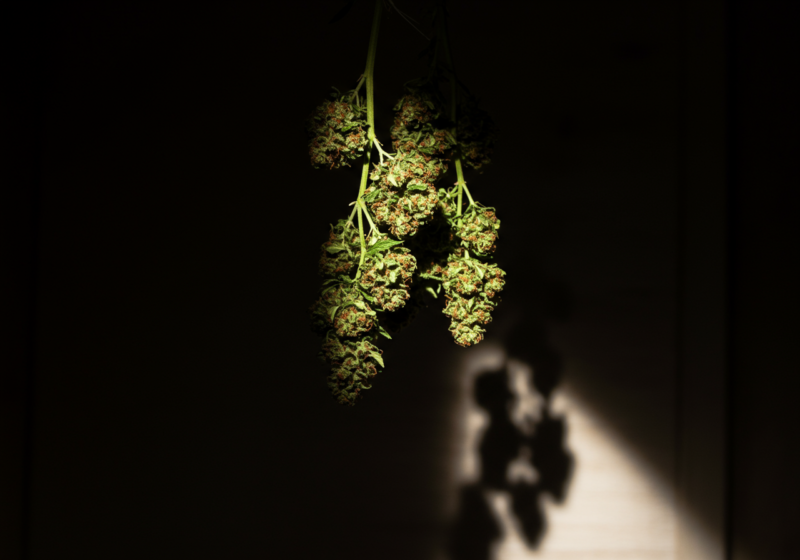
Another option is to place your buds on a half-open drawer or tray where air can circulate around them. As the drying process progresses, you can slowly reduce the airflow by closing the drawer more, making sure the buds dry evenly.
Some growers use the simpler approach of laying the buds in a single layer inside a brown paper bag. While this method works, it speeds up the drying process a bit too much, and you risk losing some quality in the end. It’s always a trade-off—too fast, and you’ll sacrifice some flavor and aroma; too slow, and you risk exposing the buds to too much air, which can reduce potency.
Aiming for about seven days of drying time is ideal for most growers. If you aren’t planning to cure the cannabis, dry it until the stems snap cleanly instead of bending. For those curing afterward, you can start curing with buds that are still a touch moist inside but dry on the outside.
How to Dry Your Buds:
To properly dry your harvest, hang the buds upside down from their stems. Use string, wire, or anything sturdy that you can secure to a wall or another stable object. Make sure your setup is strong enough to hold the weight of your drying cannabis. Nails or screws driven into wood are a solid choice, and ensure there’s enough room between each plant for air to flow freely. Proper airflow is important.
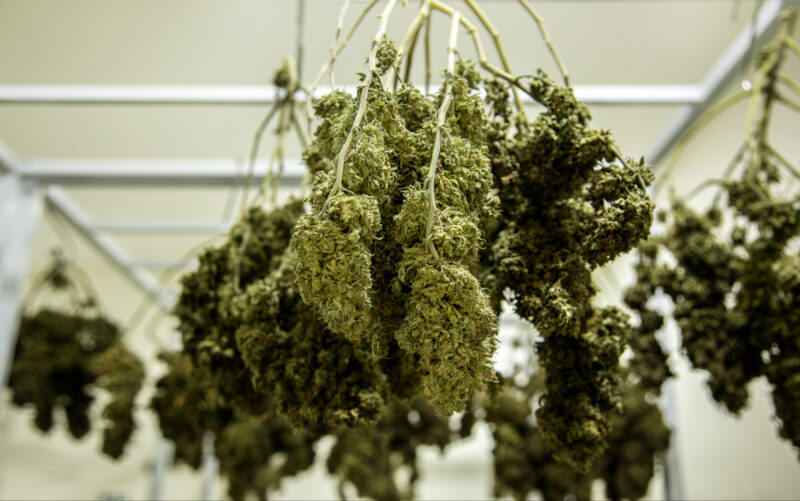
Every day, check your buds for signs of mold or mildew. If you catch any issues early, you can adjust the conditions and save your crop. As the fan leaves droop and turn crispy, start removing them—this is a good indicator that your buds are drying nicely.
Proper Air Circulation:
The drying space needs a constant circulation of air, but remember, don’t blast the buds with direct wind—keep the airflow gentle. A fan or two in the room should be more than enough to keep the air moving evenly, reducing the chance of mold forming on your buds. Without this airflow, moisture can accumulate, creating the perfect environment for mold, which can destroy your entire crop.
Mold appears as white fuzz or spots and has a nasty smell—so be vigilant and keep those conditions optimal.
WARNING: Don’t ever smoke moldy cannabis! It’s not just bad for your taste. It can make you seriously ill or even be fatal. Moldy cannabis is beyond saving, so stay alert and keep your drying environment under control to avoid this disaster.
Take your time with proper air drying and ventilation, you’ll preserve all the goodness potency, flavor, and aroma that makes your buds stand out.
Ideal Conditions for Drying
Creating the perfect drying environment is key to preserving your freshly harvested buds' potency, flavor, and aroma. A cool, dark space is absolutely essential—any light exposure will begin to degrade THC almost immediately, and we’re after the best, most potent buds possible.
You need to maintain strict control over the temperature and humidity to get optimal results. The ideal drying conditions fall within these ranges:
- Temperature: 65-76°F (18.3-24.4°C)
- Humidity: 45%-55%
If the temperature drops below 65°F, the drying time will be lengthened, which might lead to mold issues if you’re not careful. On the flip side, if the temperature rises above 75°F, you’ll dry the outside of the bud too quickly while leaving moisture locked inside, resulting in harsh smoke and a loss of flavor.
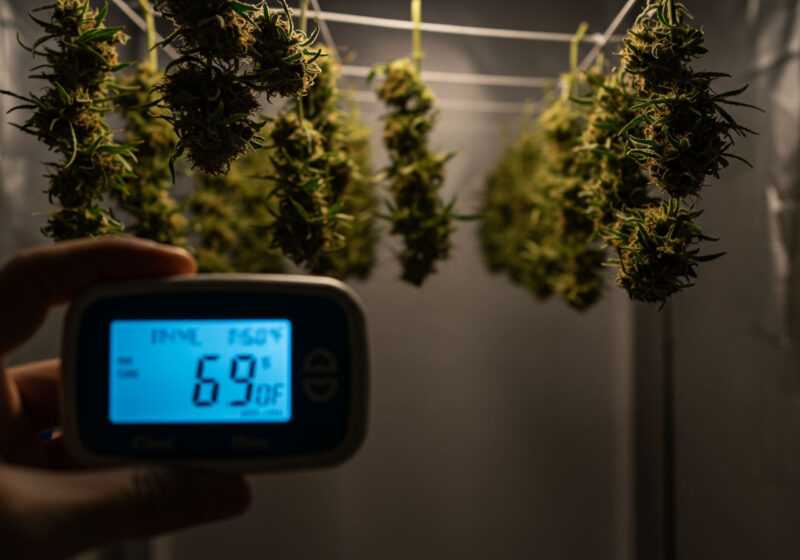
Humidity plays a similar role. Below 45%, the buds will dry too fast, and you’ll lose some of that rich, complex flavor. If the humidity creeps above 55%, you risk mold development because the buds will take too long to dry.
To ensure you’re hitting the sweet spot, keep a hygrometer and thermometer near your drying plants at all times. A hygrometer will measure the relative humidity in the room, while the thermometer keeps track of the temperature. Some devices even have both in one unit, making it easier to monitor and adjust conditions as needed.
If it’s too hot or cold, you may need to bring in a heater or air conditioner depending on your environment. A dehumidifier will bring levels down for humidity control, while a humidifier can raise them. There are two main types of humidifiers: warm mist and cool mist.
- A warm mist humidifier heats the water before releasing the humidity, which can slightly raise the temperature of the room.
- A cool mist humidifier adds moisture without affecting the room’s temperature, and is typically a safer bet for drying cannabis.
Some humidifiers let you switch between warm and cool mist, giving you full control over your environment. Choose one that suits your climate best and remember, in most cases, cool mist is the way to go.
Drying takes patience—around two weeks is generally the right amount of time. If your drying space is holding steady between 65-75°F and 45-55% humidity, your buds will dry slowly, preserving all that terpy goodness.
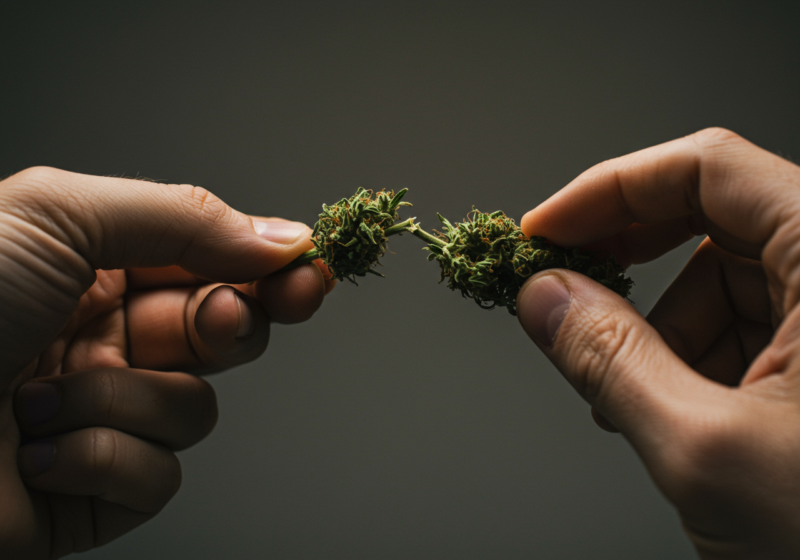
Your buds are ready when the stems snap easily instead of bending. This is a surefire way to know they’re fully dried and ready for curing or smoking. The surface of the buds should feel dry to the touch, but if you’re unsure, roll up a tiny joint (around a half gram or less) to test. If it burns smoothly, you’re in the clear!
Note: Good ventilation is critical for even drying, but be careful—if you blast air directly at the buds, they’ll dry too fast and lose potency. Aim for a gentle, circulating airflow. This way, your buds will dry out evenly, keeping them from becoming too crisp or brittle. Drying them too fast can lead to harsh smoke, but don’t worry, you’ll find your rhythm as you gain experience.
WARNING: Light destroys THC! Always keep your drying space as dark as possible. Even small amounts of light exposure can degrade your bud’s potency.
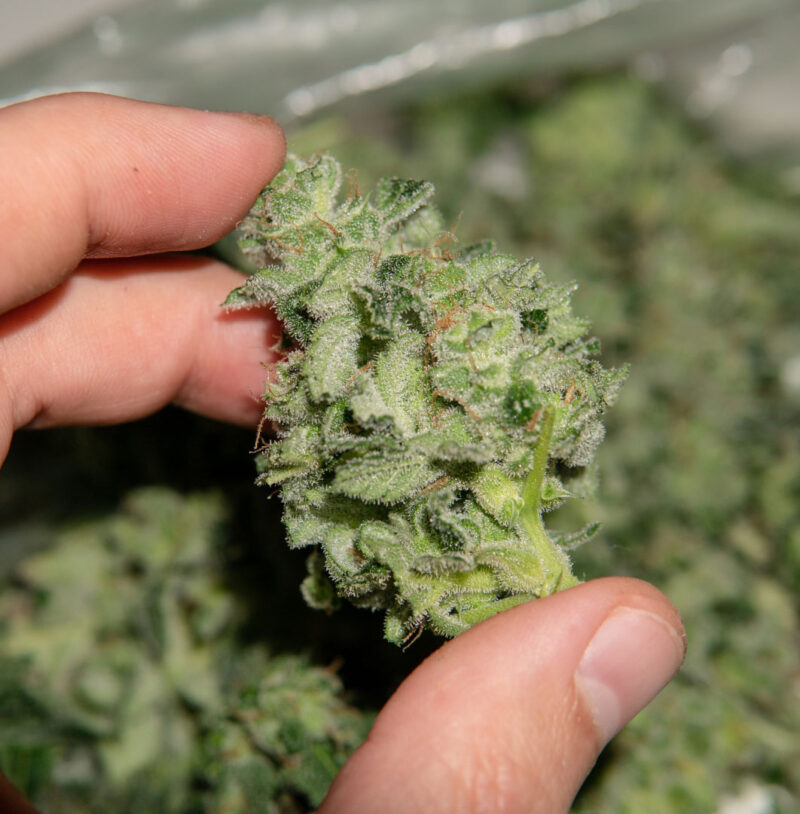
The trick to a smooth smoke is a slow, steady dry. Rushing the process will result in a harsh taste and poor burning quality. So take your time, monitor the conditions carefully, and remember—the longer and slower your buds dry, the better the final product will be. Keep it cool, keep it dark, and let your buds dry out nice and slow for that smooth, flavorful smoke!
Quick-Dry Method: Peeling Stems
If you’re in a rush and absolutely need to dry your buds faster, there’s a trick that can shave off some drying time—peeling the stems. On the first drying day, after removing the fan leaves, use a sharp knife to score and peel the main stem. Exposing the stem’s inside to the air speeds up the drying process by allowing moisture to escape more quickly, cutting the drying time by up to 33%. You can repeat this peeling ritual daily for about five days until the buds are fully dried.
While this method works when you need to accelerate drying, remember that slow drying typically yields better results. But peeling stems can do the trick if you’re in a tight spot and need to dry faster.
How to Re-hydrate Dry Buds
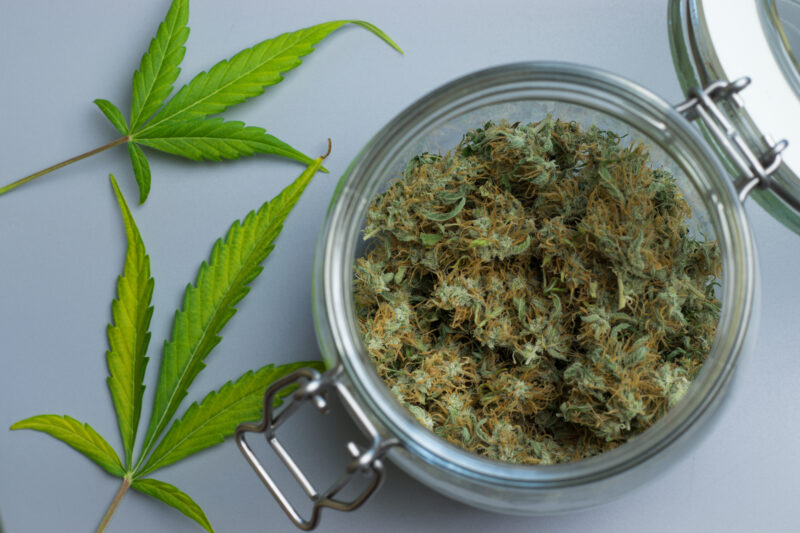
Sometimes, buds can become over-dried before they’ve had the chance to properly cure. Don’t panic! There are several ways to re-hydrate your over-dried buds, bringing them back to life and allowing the curing process to continue. Whether you use fresh buds, fruit peels, or even water, you can restore some moisture to your cannabis.
Be careful, though! When re-moisturizing, the materials you use (like fruits or vegetables) can sometimes carry fungi or bacteria. You’ll need to monitor the process closely to prevent any contamination that could ruin your entire batch.
Here’s a simple step-by-step guide to re-moisturize dry buds:
Step 1: Place your over-dried buds into a sealed container like a Ziploc bag or, preferably, a 1-quart mason jar.
Step 2: Add a few freshly cut fan leaves or fresh shoots into the jar or bag. Use 3-5 leaves for half a mason jar. As the leaves lose their moisture, they will dry and shrivel. If fan leaves aren’t available, you can substitute them with a small piece of lettuce, apple, orange, or potato peel. A paper towel with a few drops of water can also do the job.
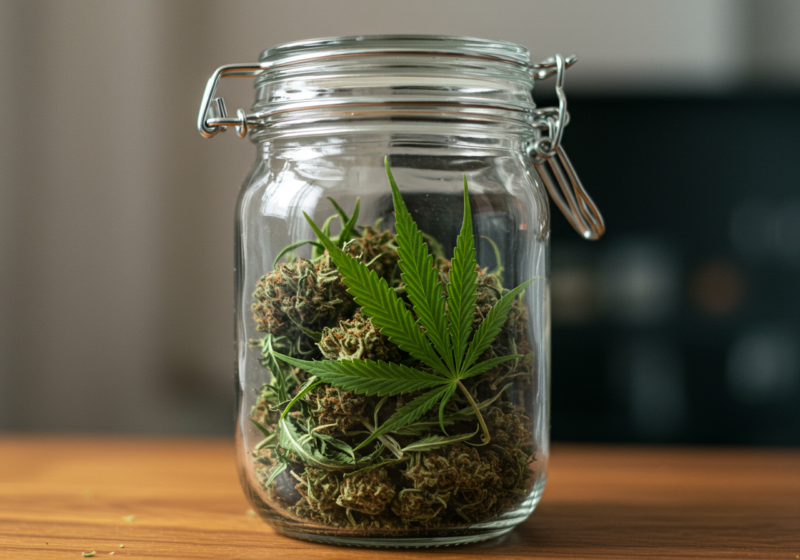
Step 3: Now, let the magic happen! Leave the container sealed for about a day, depending on how dry the buds were and how much you’re re-moisturizing. This process can work in as little as five hours, but keep checking daily.
As the buds re-hydrate, they’ll develop a softer texture and won’t feel crispy or brittle. Plus, they’ll regain that pleasant aroma. Once the buds have reabsorbed enough moisture, they’ll smell better too.
Note: Simply scale up the process for larger batches of dry buds. You might want to separate larger buds from smaller ones to ensure even re-moisturizing. Be sure to turn the buds daily to expose the bottom ones, and always check for any signs of rot. The entire process can take 1-3 days depending on the dryness and size of the batch.
Re-moisturizing dry buds isn’t difficult, but it does require careful attention to avoid mold and bacteria. As always, slow, even drying is the best process for curing cannabis, but if you’ve overshot it and the buds are too dry, this re-moisturizing method can save your stash!
Curing Your Buds
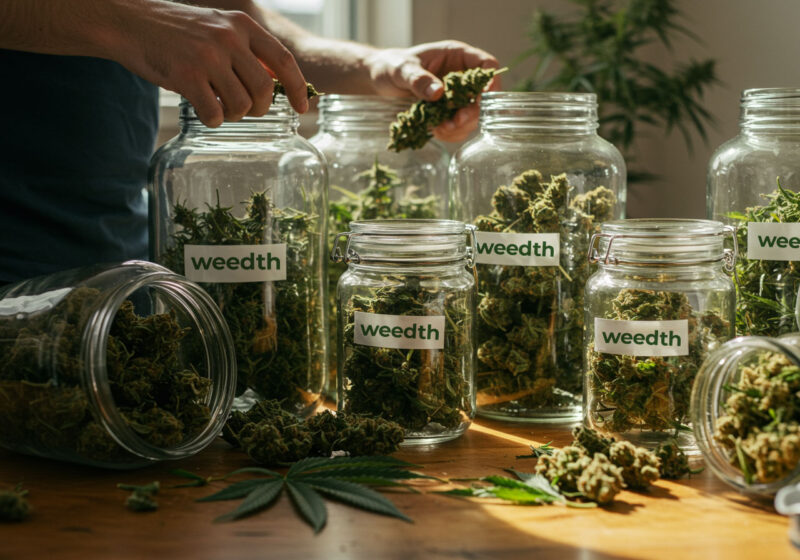
Curing is a crucial step if you want smooth, flavorful smoke that won’t leave you coughing up a lung. Sure, a fan leaf might give you an okay smoke, and the trim will be even better but the buds are your gold mine. Properly cured buds will deliver the full euphoric high and smooth experience you’re after. So, let’s dive into how to do it right and why it’s such an important part of the process.
When it comes to curing, the goal is to remove moisture evenly from the buds. If left unchecked, dry buds will start drying from the outside in. By the time the center of the bud dries, the outside will have become crispy and brittle. To avoid this, curing helps redistribute moisture throughout the bud. You’ll need airtight containers like glass jars (preferably) to create an even curing environment. Plastics can impart a weird taste, so steer clear of them. Containers with a rubber seal work best, but any jar with a tight-fitting lid will do the job.
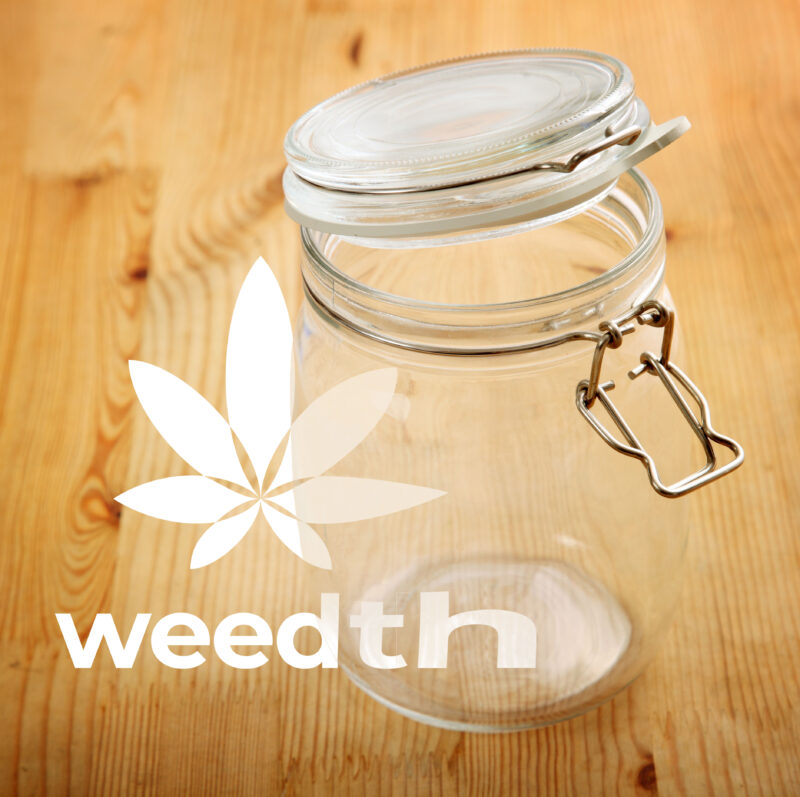
When the buds feel firm and slightly crisp, it’s time to seal them in a jar and store them in a cool, dark place. The key is striking the right balance between dryness and moisture. You want your buds dry enough that they won’t grow mold, but still moist enough that they won’t crumble apart when handled. This is the sweet spot for great-tasting, smooth-smoking buds.
How Curing Affects Potency
Curing plays a huge role in flavor and aroma, but it can also affect the potency. It’s not just about drying the buds. Sometimes when your buds first feel dry, they actually aren’t. During the curing process, moisture that’s left deep within the buds sweats out, and you’ll see how much moisture remains. Drying the buds allows the THC to convert from its acidic form (THCA) into its psychoactive form—THC.
When moisture leaves the bud, THC molecules change their structure slightly, becoming more potent. Heat can also do this, but curing does it more slowly, preserving the integrity of the bud. When your buds are fully cured, you’ll have perfectly balanced, psychoactive buds with a smoother, more flavorful smoke.
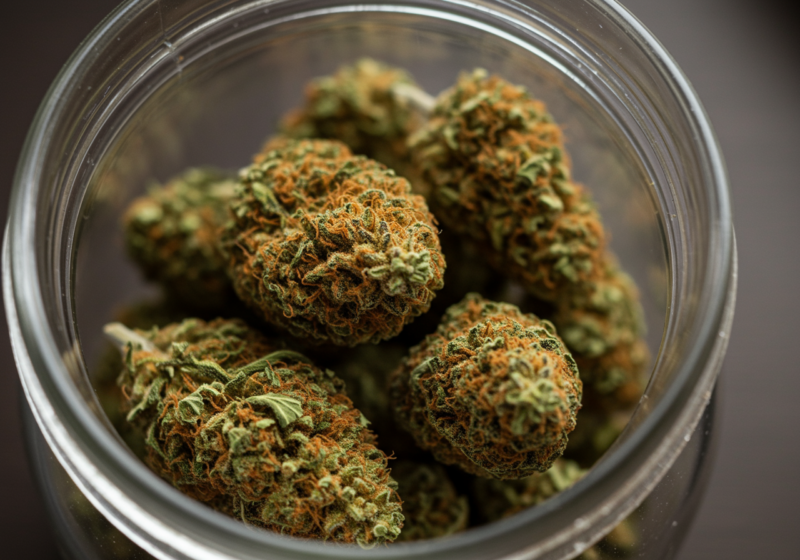
Most of the THC converts to its usable, active form during this time, without the degradation that can occur from fast drying methods.
Properly cured buds will have a nice, even burn when smoked, and they’ll break down easily into joints, blunts, or bowls. If you’re making hash, the curing process will help develop that perfect consistency—a crunchy exterior with a soft, creamy center. The smoother, tastier smoke that results from curing is well worth the effort.
When Are Your Buds Ready to Cure?
Several factors affect how long it takes for buds to be ready to cure, such as humidity, temperature, air circulation, and the size and density of the buds. The key is to establish an environment that encourages slow and even drying. Cool temperatures and low humidity help preserve the aroma and flavor.
A good way to tell if your buds are ready is to evaluate the “crunch” of the stem. When the stem snaps instead of bending, your buds are ready to move into airtight containers for curing. Some growers even bite the stems to check for that crunch—your jaw is more sensitive than your fingers. You can also grind up a small bud from the center of a larger cola, roll a joint, and see how it smokes. If the smoke is smooth and burns evenly, the rest of your buds are likely ready for curing.
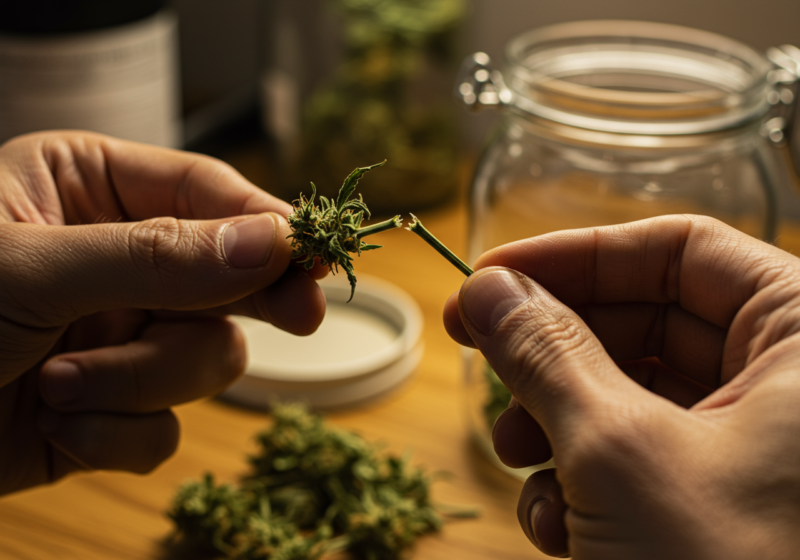
Once your buds reach the right dryness level, place them into airtight jars. Pack them in snugly to eliminate as much air as possible, then store them in a cool, dark place to let the curing process.
How to Properly Dry & Preserve Your Buds
A lot of commercial growers rush the drying process to get their buds to market. They hang the colas upside down but often use forced airflow, high temperatures, and low humidity to speed things up. The result? Harsh, grassy-tasting weed that lacks the flavor and smoothness of a properly cured bud. They’re in a hurry to exchange their buds for cash but you have the luxury of time for the home grower.
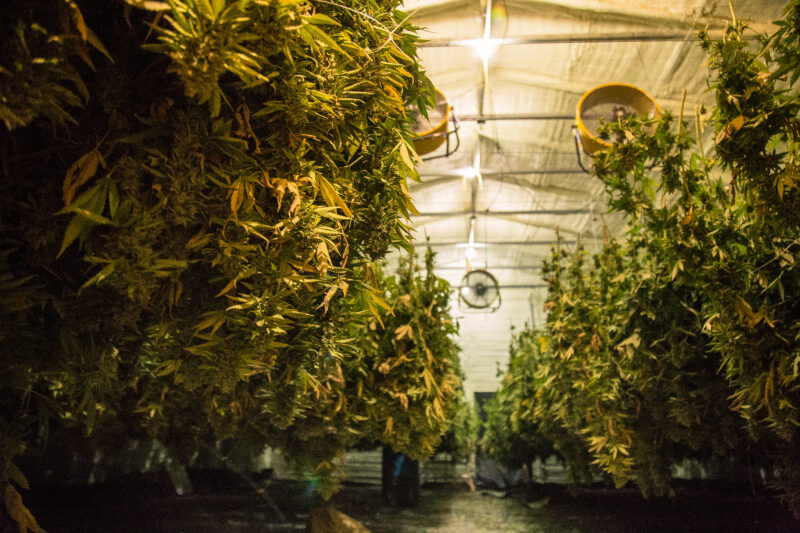
Remember: When you harvest, hang the entire plant upside down to dry in the same room you grew it in (or a similar space). Keep the humidity between 50-60% to avoid mold and maintain a temperature around 65-68°F (18.3-20°C). Darkness is key because light degrades THC quickly, so make sure the room is completely dark.
Drying should take 3-4 weeks. The plant will still be alive for a short time after you cut it, and the natural processes that break down sugars will still be happening. You don’t want to speed up this process. Quick drying will stop these natural processes and ruin the flavor. Letting the plant dry slowly ensures that moisture is evenly distributed and the flavor is preserved.
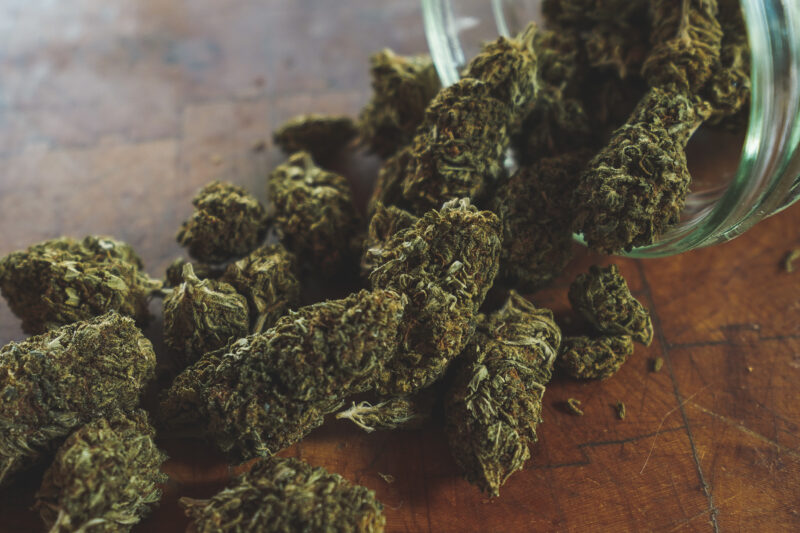
Note: If you didn't trim your buds after harvest then trim off the large and medium fan leaves, leaving the smaller ones intact. Stems should snap when bent, and the buds should be dry but not brittle.
Proper Curing
After the initial drying phase, trim off any remaining sugar leaves and store your buds in airtight glass jars for curing. Keep the jars in a cool, dark place to preserve potency and flavor. Avoid using plastic bags, as they are not truly airtight and may affect the quality of your buds.
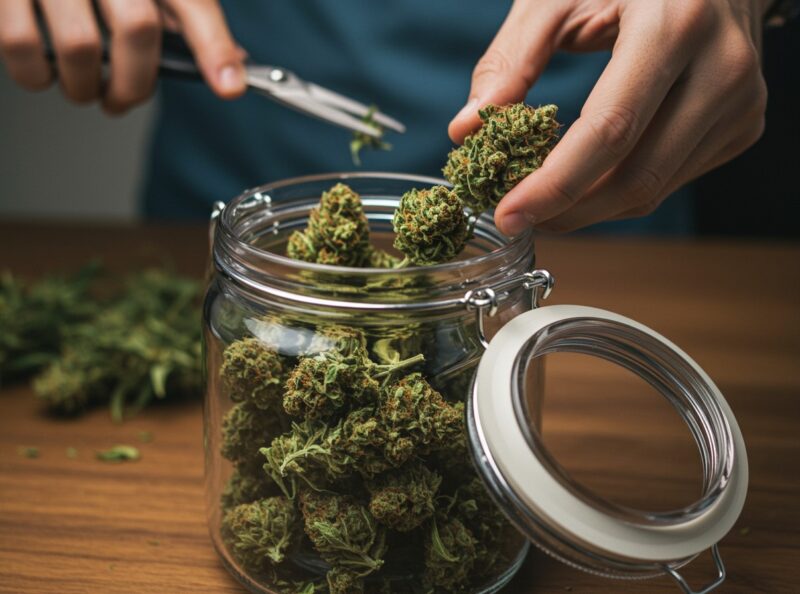
Pack your buds loosely into the jars, but don’t crush them. The goal is to minimize air while allowing for some airflow. Check the buds daily for the first week or two to ensure they are not too moist or sweating. If they are, let them air dry a little longer before repacking.
For the best results, cure your buds for at least two to four weeks. The longer the buds cure (up to three months or more), the smoother and more flavorful they become.
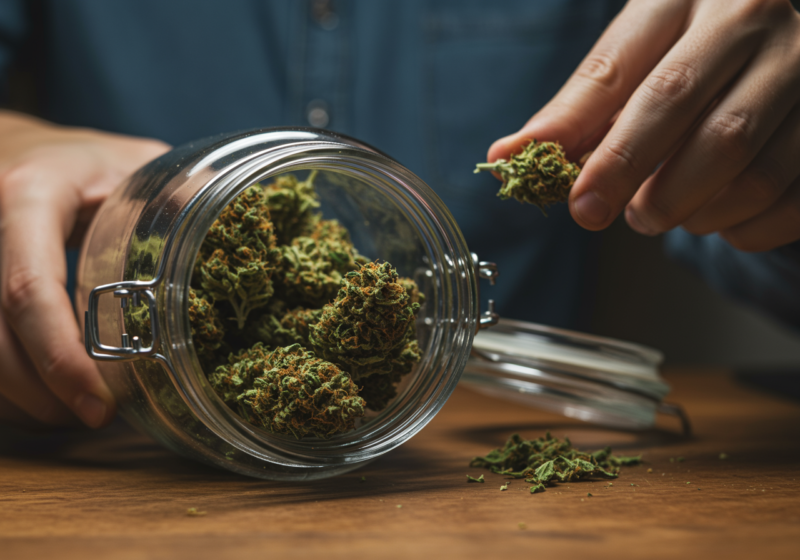
Properly cured buds will last for a long time when stored in a cool, dark, and dry place. With patience, you’ll be rewarded with a smooth, flavorful smoke and a longer-lasting high. Curing process is important for quality of your joy because when you taste I guarantee you’ll never go back to smoking harsh, uncured buds again!
Storing Your Marijuana
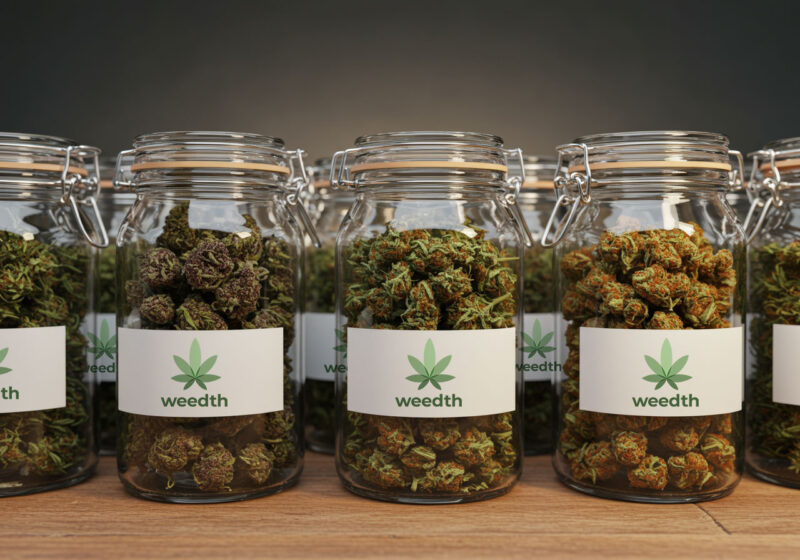
When it comes to curing and storing your precious buds, the container you choose is crucial. The best choice for curing and storing cannabis is a glass jar with a wide mouth for easy access and a rubber seal to keep air out. Avoid using plastic containers at all costs—plastic is porous and can react with the phenolic acids and terpenoids in your buds, leaving a bitter aftertaste. Glass jars with a rubberized top offer an airtight seal, which preserves the potency and flavor of your buds.
Using the wrong container can ruin your hard work, leading to a poor cure and weak, bad-tasting buds. If you want to ensure your buds stay fresh and potent, glass is the way to go. Once you’ve got the right containers, it’s time to store your buds properly.
Gently place your freshly dried marijuana into the jars. If necessary, cut the buds to size so they fit. Store the jars in a dark area where the temperature is between 50-65°F (10-24°C), and the humidity is kept between 40%-60%. This environment will preserve your buds in their best condition.
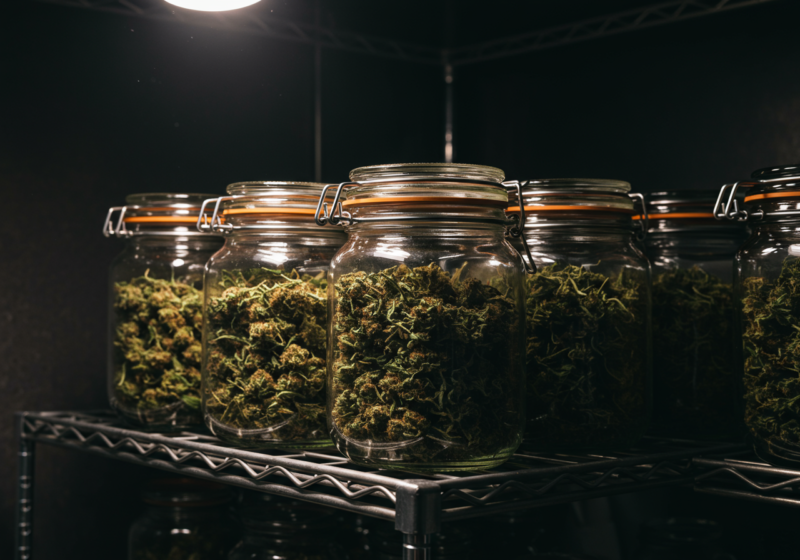
For the first 7-10 days, it’s recommended to open the containers 3-6 times daily to let any excess moisture escape. Simply fan the jars with your hand to release the humidity. Shake the buds gently every few days to move them around, making sure they dry evenly. If moisture builds up on the inside of the lid, wipe it off. Also, give the buds a quarter turn daily to ensure different parts of the bud are exposed to the air. By the end of this period, your marijuana should be perfectly dried, with an even burn when smoked.
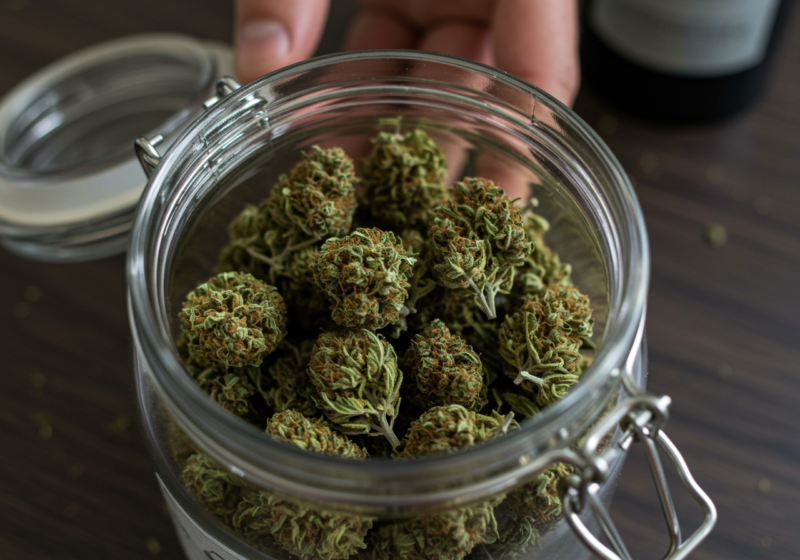
Once your buds are properly cured, there’s no need to continue opening the containers. The THC will have reached its peak, and the buds will be ready to store or enjoy.
Long-Term Storage
If you’re planning to store your buds for up to a year, keep them in an airtight container in a dark, cool place to preserve potency. Avoid exposure to light, air, and heat, as these factors degrade cannabinoids and terpenes over time.
While some growers freeze their buds for long-term storage, freezing temperatures can make trichomes brittle, causing them to break off. Refrigerators are not recommended due to their fluctuating humidity levels, which can promote mold growth and degrade the quality of your buds. Storing cannabis in a fridge without strict humidity control can do more harm than good.
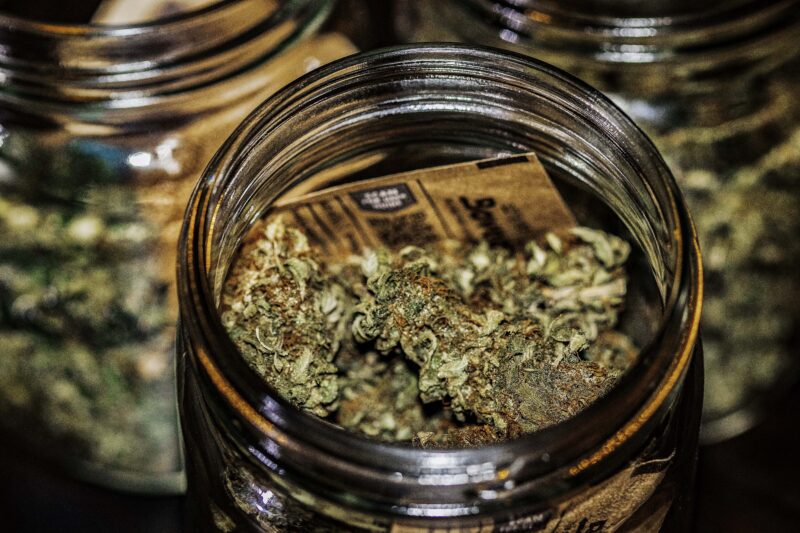
If you are thinking of long-term storage for up to 5 years, a vacuum sealer is one of the best options. Vacuum-sealing your buds and storing them in a dark place at a temperature between 40-55°F (4.4-12.7°C), you can preserve their potency and flavor for years to come. But be careful: even vacuum-sealed marijuana can absorb moisture if stored in a humid environment, so you may need to dry the buds again before smoking if you notice any dampness.
Key Storage Tips
Here are a few things to keep in mind to maintain potency during curing and storage:
- Keep buds in the dark: Light degrades THC over time, reducing potency.
- Maintain moderate temperatures: 50-65°F (10-18°C) is ideal. Avoid excessive heat, which can cause oxidation, mold, or bacterial growth.
- Do not store buds in freezing temperatures: Cold storage does not preserve potency. Instead, freezing can damage trichomes, making them brittle and causing them to break off. Refrigerators also introduce humidity, increasing the risk of mold.
- For long-term storage, keep buds in airtight glass jars in a cool, dry, and dark place. Vacuum sealing in a controlled environment can also extend shelf life.
- Avoid plastic containers: Plastic can generate static electricity, which can pull trichomes off the buds and degrade potency.
- Inert gases like nitrogen can help slow oxidation, but this is typically used for commercial storage. Ascorbic acid (Vitamin C) packets are not commonly used for cannabis preservation and may not significantly impact storage quality.
- Handle buds gently: Store whole, unbroken buds whenever possible. Overhandling or pressing can break the protective outer layer, leading to oxidation and cannabinoid degradation.
Following these tips, your stored buds will stay potent, flavorful, and fresh for as long as you need them. Take care of your storage conditions to enjoy your cannabis at its best.

